
FUNCTIONAL BLOCK DIAGRAM
REV. B
Information furnished by Analog Devices is believed to be accurate and
reliable. However, no responsibility is assumed by Analog Devices for its
use, nor for any infringements of patents or other rights of third parties
which may result from its use. No license is granted by implication or
otherwise under any patent or patent rights of Analog Devices.
a
ADSP-2100 Family
DSP Microcomputers
ADSP-21xx
SUMMARY
16-Bit Fixed-Point DSP Microprocessors with
On-Chip Memory
Enhanced Harvard Architecture for Three-Bus
Performance: Instruction Bus & Dual Data Buses
Independent Computation Units: ALU, Multiplier/
Accumulator, and Shifter
Single-Cycle Instruction Execution & Multifunction
Instructions
On-Chip Program Memory RAM or ROM
& Data Memory RAM
Integrated I/O Peripherals: Serial Ports, Timer,
Host Interface Port (ADSP-2111 Only)
FEATURES
25 MIPS, 40 ns Maximum Instruction Rate
Separate On-Chip Buses for Program and Data Memory
Program Memory Stores Both Instructions and Data
(Three-Bus Performance)
Dual Data Address Generators with Modulo and
Bit-Reverse Addressing
Efficient Program Sequencing with Zero-Overhead
Looping: Single-Cycle Loop Setup
Automatic Booting of On-Chip Program Memory from
Byte-Wide External Memory (e.g., EPROM )
Double-Buffered Serial Ports with Companding Hardware,
Automatic Data Buffering, and Multichannel Operation
ADSP-2111 Host Interface Port Provides Easy Interface
to 68000, 80C51, ADSP-21xx, Etc.
Automatic Booting of ADSP-2111 Program Memory
Through Host Interface Port
Three Edge- or Level-Sensitive Interrupts
Low Power IDLE Instruction
PGA, PLCC, PQFP, and TQFP Packages
MIL-STD-883B Versions Available
This data sheet describes the following ADSP-2100 Family
processors:
ADSP-2101
ADSP-2103
3.3 V Version of ADSP-2101
ADSP-2105
Low Cost DSP
ADSP-2111
DSP with Host Interface Port
ADSP-2115
ADSP-2161/62/63/64
Custom ROM-programmed DSPs
The following ADSP-2100 Family processors are not included
in this data sheet:
ADSP-2100A
DSP Microprocessor
ADSP-2165/66
ROM-programmed ADSP-216x processors
with powerdown and larger on-chip
memories (12K Program Memory ROM,
1K Program Memory RAM, 4K Data
Memory RAM)
ADSP-21msp5x
Mixed-Signal DSP Processors with
integrated on-chip A/D and D/A plus
powerdown
ADSP-2171
Speed and feature enhanced ADSP-2100
Family processor with host interface port,
powerdown, and instruction set extensions
for bit manipulation, multiplication, biased
rounding, and global interrupt masking
ADSP-2181
ADSP-21xx processor with ADSP-2171
features plus 80K bytes of on-chip RAM
configured as 16K words of program
memory and 16K words of data memory.
Refer to the individual data sheet of each of these processors for
further information.
GENERAL DESCRIPTION
The ADSP-2100 Family processors are single-chip micro-
computers optimized for digital signal processing (DSP)
and other high speed numeric processing applications. The
ADSP-21xx processors are all built upon a common core. Each
processor combines the core DSP architecture--computation
units, data address generators, and program sequencer--with
differentiating features such as on-chip program and data
memory RAM, a programmable timer, one or two serial ports,
and, on the ADSP-2111, a host interface port.
EXTERNAL
ADDRESS
BUS
DATA
MEMORY
PROGRAM
MEMORY
EXTERNAL
DATA
BUS
ADSP-2100 CORE
ARITHMETIC UNITS
SHIFTER
MAC
ALU
MEMORY
SERIAL PORTS
SPORT 0
SPORT 1
HOST
INTERFACE
PORT
(ADSP-2111)
FLAGS
(ADSP-2111)
DATA ADDRESS
GENERATORS
DAG 1
DAG 2
PROGRAM
SEQUENCER
PROGRAM MEMORY ADDRESS
DATA MEMORY ADDRESS
PROGRAM MEMORY DATA
DATA MEMORY DATA
TIMER
© Analog Devices, Inc., 1996
One Technology Way, P.O. Box 9106, Norwood, MA 02062-9106, U.S.A.
Tel: 617/329-4700
Fax: 617/326-8703

ADSP-21xx
≠2≠
REV. B
Fabricated in a high speed, submicron, double-layer metal
CMOS process, the highest-performance ADSP-21xx proces-
sors operate at 25 MHz with a 40 ns instruction cycle time.
Every instruction can execute in a single cycle. Fabrication in
CMOS results in low power dissipation.
The ADSP-2100 Family's flexible architecture and compre-
hensive instruction set support a high degree of parallelism.
In one cycle the ADSP-21xx can perform all of the following
operations:
∑
Generate the next program address
∑
Fetch the next instruction
∑
Perform one or two data moves
∑
Update one or two data address pointers
∑
Perform a computation
∑
Receive and transmit data via one or two serial ports
∑
Receive and/or transmit data via the host interface port
(ADSP-2111 only)
The ADSP-2101, ADSP-2105, and ADSP-2115 comprise the
basic set of processors of the family. Each of these three devices
contains program and data memory RAM, an interval timer,
and one or two serial ports. The ADSP-2103 is a 3.3 volt
power supply version of the ADSP-2101; it is identical to the
ADSP-2101 in all other characteristics. Table I shows the
features of each ADSP-21xx processor.
The ADSP-2111 adds a 16-bit host interface port (HIP) to the
basic set of ADSP-21xx integrated features. The host port
provides a simple interface to host microprocessors or
microcontrollers such as the 8031, 68000, or ISA bus.
TABLE OF CONTENTS
GENERAL DESCRIPTION . . . . . . . . . . . . . . . . . . . . . . . . 1
Development Tools . . . . . . . . . . . . . . . . . . . . . . . . . . . . . . . 4
Additional Information . . . . . . . . . . . . . . . . . . . . . . . . . . . . 4
ARCHITECTURE OVERVIEW . . . . . . . . . . . . . . . . . . . . 4
Serial Ports . . . . . . . . . . . . . . . . . . . . . . . . . . . . . . . . . . . . . 5
Host Interface Port (ADSP-2111) . . . . . . . . . . . . . . . . . . . . 6
Interrupts . . . . . . . . . . . . . . . . . . . . . . . . . . . . . . . . . . . . . . . 6
Pin Definitions . . . . . . . . . . . . . . . . . . . . . . . . . . . . . . . . . . . 7
SYSTEM INTERFACE . . . . . . . . . . . . . . . . . . . . . . . . . . . 7
Clock Signals . . . . . . . . . . . . . . . . . . . . . . . . . . . . . . . . . . . . 7
Reset . . . . . . . . . . . . . . . . . . . . . . . . . . . . . . . . . . . . . . . . . . 8
Program Memory Interface . . . . . . . . . . . . . . . . . . . . . . . . 10
Program Memory Maps . . . . . . . . . . . . . . . . . . . . . . . . . . . 10
Data Memory Interface . . . . . . . . . . . . . . . . . . . . . . . . . . . 12
Data Memory Map . . . . . . . . . . . . . . . . . . . . . . . . . . . . . . 12
Boot Memory Interface . . . . . . . . . . . . . . . . . . . . . . . . . . . 12
Bus Interface . . . . . . . . . . . . . . . . . . . . . . . . . . . . . . . . . . . 12
Low Power IDLE Instruction . . . . . . . . . . . . . . . . . . . . . . 13
ADSP-216x Prototyping . . . . . . . . . . . . . . . . . . . . . . . . . . 13
Ordering Procedure for ADSP-216x ROM Processors . . . . 13
Wafer Products . . . . . . . . . . . . . . . . . . . . . . . . . . . . . . . . . 14
Functional Differences for Older Revision Devices . . . . . . 14
Instruction Set . . . . . . . . . . . . . . . . . . . . . . . . . . . . . . . . . . 15
SPECIFICATIONS
(ADSP-2101/2105/2115/2161/2163) . . . . . . . . . . . . . . . 17
Recommended Operating Conditions . . . . . . . . . . . . . . . . 17
Electrical Characteristics . . . . . . . . . . . . . . . . . . . . . . . . . . 17
Supply Current & Power (ADSP-2101/2161/2163) . . . . . . 18
Power Dissipation Example . . . . . . . . . . . . . . . . . . . . . . . . 19
Environmental Conditions . . . . . . . . . . . . . . . . . . . . . . . . . 19
Capacitive Loading . . . . . . . . . . . . . . . . . . . . . . . . . . . . . . 19
Test Conditions . . . . . . . . . . . . . . . . . . . . . . . . . . . . . . . . . 20
SPECIFICATIONS
(ADSP-2111) . . . . . . . . . . . . . . . . . . . . . . . . . . . . . . . . . 21
Recommended Operating Conditions . . . . . . . . . . . . . . . . 21
Electrical Characteristics . . . . . . . . . . . . . . . . . . . . . . . . . . 21
Supply Current & Power . . . . . . . . . . . . . . . . . . . . . . . . . . 22
Power Dissipation Example . . . . . . . . . . . . . . . . . . . . . . . . 23
Environmental Conditions . . . . . . . . . . . . . . . . . . . . . . . . . 23
Capacitive Loading . . . . . . . . . . . . . . . . . . . . . . . . . . . . . . 23
Test Conditions . . . . . . . . . . . . . . . . . . . . . . . . . . . . . . . . . 24
SPECIFICATIONS (ADSP-2103/2162/2164) . . . . . . . . . 25
Recommended Operating Conditions . . . . . . . . . . . . . . . . 25
Electrical Characteristics . . . . . . . . . . . . . . . . . . . . . . . . . . 25
Supply Current & Power . . . . . . . . . . . . . . . . . . . . . . . . . . 26
Power Dissipation Example . . . . . . . . . . . . . . . . . . . . . . . . 27
Environmental Conditions . . . . . . . . . . . . . . . . . . . . . . . . . 27
Capacitive Loading . . . . . . . . . . . . . . . . . . . . . . . . . . . . . . 27
Test Conditions . . . . . . . . . . . . . . . . . . . . . . . . . . . . . . . . . 28
TIMING PARAMETERS
(ADSP-2101/2105/2111/2115/2161/2163) . . . . . . . . . . . . 29
Clock Signals . . . . . . . . . . . . . . . . . . . . . . . . . . . . . . . . . . . 30
Interrupts & Flags . . . . . . . . . . . . . . . . . . . . . . . . . . . . . . . 31
Bus Request≠Bus Grant . . . . . . . . . . . . . . . . . . . . . . . . . . . 32
Memory Read . . . . . . . . . . . . . . . . . . . . . . . . . . . . . . . . . . 33
Memory Write . . . . . . . . . . . . . . . . . . . . . . . . . . . . . . . . . . 34
Serial Ports . . . . . . . . . . . . . . . . . . . . . . . . . . . . . . . . . . . . 35
Host Interface Port (ADSP-2111) . . . . . . . . . . . . . . . . . . . 36
TIMING PARAMETERS (ADSP-2103/2162/2164) . . . . 44
Clock Signals . . . . . . . . . . . . . . . . . . . . . . . . . . . . . . . . . . . 45
Interrupts & Flags . . . . . . . . . . . . . . . . . . . . . . . . . . . . . . . 46
Bus Request≠Bus Grant . . . . . . . . . . . . . . . . . . . . . . . . . . . 47
Memory Read . . . . . . . . . . . . . . . . . . . . . . . . . . . . . . . . . . 48
Memory Write . . . . . . . . . . . . . . . . . . . . . . . . . . . . . . . . . . 49
Serial Ports . . . . . . . . . . . . . . . . . . . . . . . . . . . . . . . . . . . . 50
PIN CONFIGURATIONS
68-Pin PGA (ADSP-2101) . . . . . . . . . . . . . . . . . . . . . . . . 51
68-Lead PLCC (ADSP-2101/2103/2105/2115/216x) . . . . 52
80-Lead PQFP (ADSP-2101/2103/2115/216x) . . . . . . . . . 53
80-Lead TQFP (ADSP-2115) . . . . . . . . . . . . . . . . . . . . . . 53
100-Pin PGA (ADSP-2111) . . . . . . . . . . . . . . . . . . . . . . . 54
100-Lead PQFP (ADSP-2111) . . . . . . . . . . . . . . . . . . . . . 55
PACKAGE OUTLINE DIMENSIONS
68-Pin PGA . . . . . . . . . . . . . . . . . . . . . . . . . . . . . . . . . . . . 56
68-Lead PLCC . . . . . . . . . . . . . . . . . . . . . . . . . . . . . . . . . 57
80-Lead PQFP, 80-Lead TQFP . . . . . . . . . . . . . . . . . . . . 58
100-Pin PGA . . . . . . . . . . . . . . . . . . . . . . . . . . . . . . . . . . . 59
100-Lead PQFP . . . . . . . . . . . . . . . . . . . . . . . . . . . . . . . . 60
ORDERING GUIDE . . . . . . . . . . . . . . . . . . . . . . . . . . 61-62

ADSP-21xx
REV. B
≠3≠
Table I. ADSP-21xx Processor Features
Feature
2101
2103
2105
2115
2111
Data Memory (RAM)
1K
1K
1
/
2
K
1
/
2
K
1K
Program Memory (RAM)
2K
2K
1K
1K
2K
Timer
∑
∑
∑
∑
∑
Serial Port 0 (Multichannel)
∑
∑
≠
∑
∑
Serial Port 1
∑
∑
∑
∑
∑
Host Interface Port
≠
≠
≠
≠
∑
Speed Grades (Instruction Cycle Time)
10.24 MHz (76.9 ns)
≠
∑
≠
≠
≠
13.0 MHz (76.9 ns)
≠
≠
≠
≠
∑
13.824 MHz (72.3 ns)
≠
≠
∑
≠
≠
16.67 MHz (60 ns)
∑
≠
≠
∑
∑
20.0 MHz (50 ns)
∑
≠
∑
∑
∑
25 MHz (40 ns)
∑
≠
≠
∑
≠
Supply Voltage
5 V
3.3 V
5 V
5 V
5 V
Packages
68-Pin PGA
∑
≠
≠
≠
≠
68-Lead PLCC
∑
∑
∑
∑
≠
80-Lead PQFP
∑
∑
≠
∑
≠
80-Lead TQFP
≠
≠
≠
∑
≠
100-Pin PGA
≠
≠
≠
≠
∑
100-Lead PQFP
≠
≠
≠
≠
∑
Temperature Grades
K Commercial 0
∞
C to +70
∞
C
∑
∑
∑
∑
∑
B Industrial
≠40
∞
C to +85
∞
C
∑
∑
∑
∑
∑
T Extended
≠55
∞
C to +125
∞
C
∑
≠
≠
≠
∑
Table II. ADSP-216x ROM-Programmed Processor Features
Feature
2161
2162
2163
2164
Data Memory (RAM)
1
/
2
K
1
/
2
K
1
/
2
K
1
/
2
K
Program Memory (ROM)
8K
8K
4K
4K
Program Memory (RAM)
≠
≠
≠
≠
Timer
∑
∑
∑
∑
Serial Port 0 (Multichannel)
∑
∑
∑
∑
Serial Port 1
∑
∑
∑
∑
Supply Voltage
5 V
3.3 V
5 V
3.3 V
Speed Grades (Instruction Cycle Time)
10.24 MHz (97.6 ns)
≠
∑
≠
∑
16.67 MHz (60 ns)
∑
≠
∑
≠
25 MHz (40 ns)
≠
≠
∑
≠
Packages
68-Lead PLCC
∑
∑
∑
∑
80-Lead PQFP
∑
∑
∑
∑
Temperature Grades
K Commercial 0
∞
C to +70
∞
C
∑
∑
∑
∑
B Industrial
≠40
∞
C to +85
∞
C
∑
∑
∑
∑

ADSP-21xx
≠4≠
REV. B
The ADSP-216x series are memory-variant versions of the
ADSP-2101 and ADSP-2103 that contain factory-programmed
on-chip ROM program memory. These devices offer different
amounts of on-chip memory for program and data storage.
Table II shows the features available in the ADSP-216x series of
custom ROM-coded processors.
The ADSP-216x products eliminate the need for an external
boot EPROM in your system, and can also eliminate the need
for any external program memory by fitting the entire applica-
tion program in on-chip ROM. These devices thus provide an
excellent option for volume applications where board space and
system cost constraints are of critical concern.
Development Tools
The ADSP-21xx processors are supported by a complete set of
tools for system development. The ADSP-2100 Family Devel-
opment Software includes C and assembly language tools that
allow programmers to write code for any of the ADSP-21xx
processors. The ANSI C compiler generates ADSP-21xx
assembly source code, while the runtime C library provides
ANSI-standard and custom DSP library routines. The ADSP-
21xx assembler produces object code modules which the linker
combines into an executable file. The processor simulators
provide an interactive instruction-level simulation with a
reconfigurable, windowed user interface. A PROM splitter
utility generates PROM programmer compatible files.
EZ-ICE
Æ
in-circuit emulators allow debugging of ADSP-21xx
systems by providing a full range of emulation functions such as
modification of memory and register values and execution
breakpoints. EZ-LAB
Æ
demonstration boards are complete DSP
systems that execute EPROM-based programs.
The EZ-Kit Lite is a very low-cost evaluation/development
platform that contains both the hardware and software needed
to evaluate the ADSP-21xx architecture.
Additional details and ordering information is available in the
ADSP-2100 Family Software & Hardware Development Tools data
sheet (ADDS-21xx-TOOLS). This data sheet can be requested
from any Analog Devices sales office or distributor.
Additional Information
This data sheet provides a general overview of ADSP-21xx
processor functionality. For detailed design information on the
architecture and instruction set, refer to the ADSP-2100 Family
User's Manual, available from Analog Devices.
ARCHITECTURE OVERVIEW
Figure 1 shows a block diagram of the ADSP-21xx architecture.
The processors contain three independent computational units:
the ALU, the multiplier/accumulator (MAC), and the shifter.
The computational units process 16-bit data directly and have
provisions to support multiprecision computations. The ALU
performs a standard set of arithmetic and logic operations;
division primitives are also supported. The MAC performs
single-cycle multiply, multiply/add, and multiply/subtract
operations. The shifter performs logical and arithmetic shifts,
normalization, denormalization, and derive exponent operations.
The shifter can be used to efficiently implement numeric format
control including multiword floating-point representations.
The internal result (R) bus directly connects the computational
units so that the output of any unit may be used as the input of
any unit on the next cycle.
A powerful program sequencer and two dedicated data address
generators ensure efficient use of these computational units.
The sequencer supports conditional jumps, subroutine calls,
and returns in a single cycle. With internal loop counters and
loop stacks, the ADSP-21xx executes looped code with zero
overhead--no explicit jump instructions are required to
maintain the loop.
Two data address generators (DAGs) provide addresses for
simultaneous dual operand fetches (from data memory and
program memory). Each DAG maintains and updates four
address pointers. Whenever the pointer is used to access data
(indirect addressing), it is post-modified by the value of one of
four modify registers. A length value may be associated with
each pointer to implement automatic modulo addressing for
circular buffers. The circular buffering feature is also used by
the serial ports for automatic data transfers to (and from) on-
chip memory.
Efficient data transfer is achieved with the use of five internal
buses:
∑ Program Memory Address (PMA) Bus
∑ Program Memory Data (PMD) Bus
∑ Data Memory Address (DMA) Bus
∑ Data Memory Data (DMD) Bus
∑ Result (R) Bus
The two address buses (PMA, DMA) share a single external
address bus, allowing memory to be expanded off-chip, and the
two data buses (PMD, DMD) share a single external data bus.
The BMS, DMS, and PMS signals indicate which memory
space is using the external buses.
Program memory can store both instructions and data, permit-
ting the ADSP-21xx to fetch two operands in a single cycle, one
from program memory and one from data memory. The
processor can fetch an operand from on-chip program memory
and the next instruction in the same cycle.
The memory interface supports slow memories and memory-
mapped peripherals with programmable wait state generation.
External devices can gain control of the processor's buses with
the use of the bus request/grant signals (BR, BG).
EZ-ICE and EZ-LAB are registered trademarks of Analog Devices, Inc.
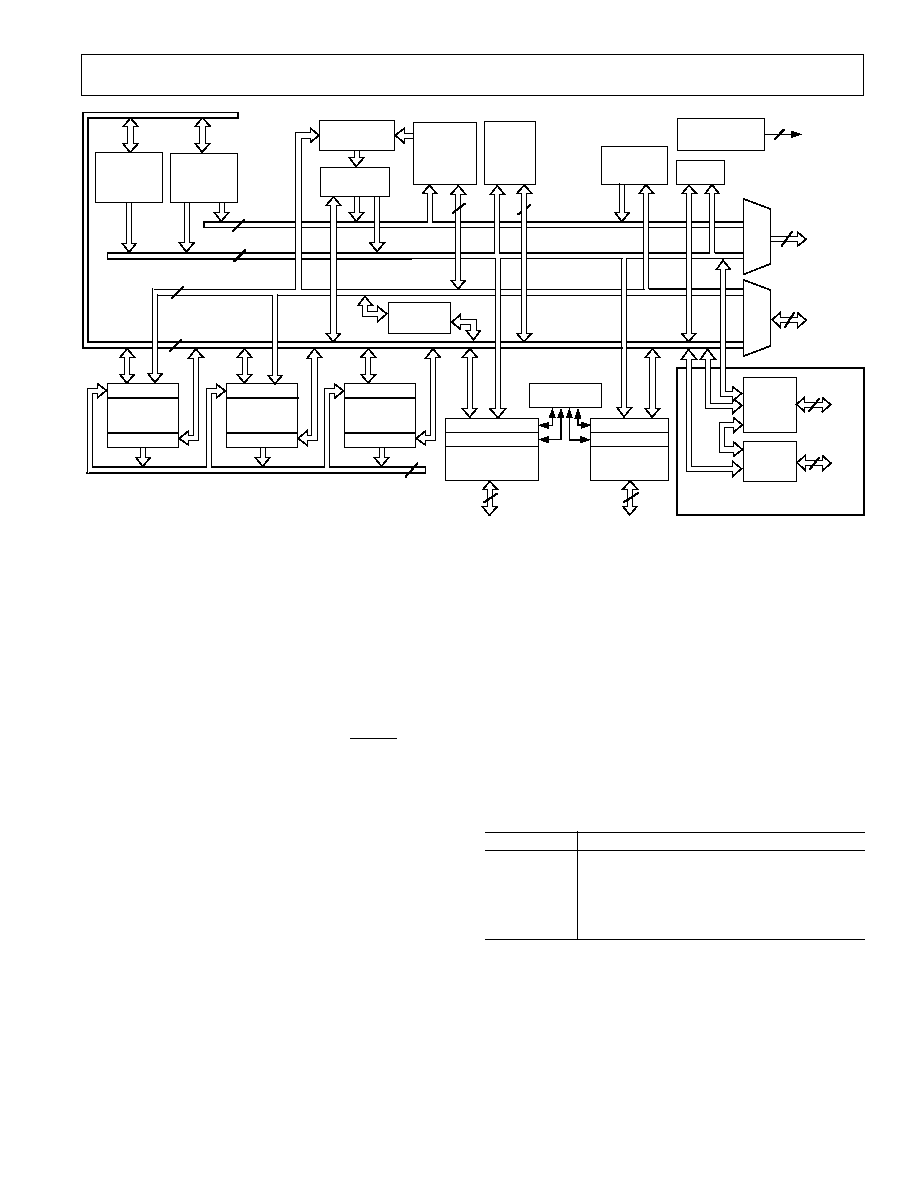
ADSP-21xx
REV. B
≠5≠
Figure 1. ADSP-21xx Block Diagram
One bus grant execution mode (GO Mode) allows the ADSP-
21xx to continue running from internal memory. A second
execution mode requires the processor to halt while buses are
granted.
Each ADSP-21xx processor can respond to several different
interrupts. There can be up to three external interrupts,
configured as edge- or level-sensitive. Internal interrupts can be
generated by the timer, serial ports, and, on the ADSP-2111,
the host interface port. There is also a master RESET signal.
Booting circuitry provides for loading on-chip program memory
automatically from byte-wide external memory. After reset,
three wait states are automatically generated. This allows, for
example, a 60 ns ADSP-2101 to use a 200 ns EPROM as
external boot memory. Multiple programs can be selected and
loaded from the EPROM with no additional hardware.
The data receive and transmit pins on SPORT1 (Serial Port 1)
can be alternatively configured as a general-purpose input flag
and output flag. You can use these pins for event signalling to
and from an external device. The ADSP-2111 has three
additional flag outputs whose states are controlled through
software.
A programmable interval timer can generate periodic interrupts.
A 16-bit count register (TCOUNT) is decremented every n
cycles, where n≠1 is a scaling value stored in an 8-bit register
(TSCALE). When the value of the count register reaches zero,
an interrupt is generated and the count register is reloaded from
a 16-bit period register (TPERIOD).
Serial Ports
The ADSP-21xx processors include two synchronous serial
ports ("SPORTs") for serial communications and multiproces-
sor communication. All of the ADSP-21xx processors have two
serial ports (SPORT0, SPORT1) except for the ADSP-2105,
which has only SPORT1.
The serial ports provide a complete synchronous serial interface
with optional companding in hardware. A wide variety of
framed or frameless data transmit and receive modes of opera-
tion are available. Each SPORT can generate an internal
programmable serial clock or accept an external serial clock.
Each serial port has a 5-pin interface consisting of the following
signals:
Signal Name
Function
SCLK
Serial Clock (I/O)
RFS
Receive Frame Synchronization (I/O)
TFS
Transmit Frame Synchronization (I/O)
DR
Serial Data Receive
DT
Serial Data Transmit
The ADSP-21xx serial ports offer the following capabilities:
Bidirectional--Each SPORT has a separate, double-buffered
transmit and receive function.
Flexible Clocking--Each SPORT can use an external serial
clock or generate its own clock internally.
R Bus
16
DMD BUS
HOST
PORT
CONTROL
PMD BUS
DMA BUS
PMA BUS
14
24
16
EXTERNAL
ADDRESS
BUS
EXTERNAL
DATA
BUS
HOST
PORT
DATA
BOOT
ADDRESS
GENERATOR
TIMER
14
11
BUS
EXCHANGE
COMPANDING
CIRCUITRY
5
16
24
RECEIVE REG
TRANSMIT REG
SERIAL
PORT 1
EXTERNAL
HOST PORT
BUS
DMA BUS
PMA BUS
DMD BUS
PMD BUS
HOST INTERFACE PORT
(ADSP-2111 Only)
FLAGS
(ADSP-2111 Only)
3
PROGRAM
SEQUENCER
INSTRUCTION
REGISTER
PROGRAM
MEMORY
SRAM
or ROM
DATA
MEMORY
SRAM
DATA
ADDRESS
GENERATOR
#2
DATA
ADDRESS
GENERATOR
#1
14
INPUT REGS
OUTPUT REGS
SHIFTER
INPUT REGS
OUTPUT REGS
MAC
INPUT REGS
OUTPUT REGS
ALU
RECEIVE REG
TRANSMIT REG
SERIAL
PORT 0
(Not on ADSP-2105)
5
16
MUX
24
MUX

ADSP-21xx
≠6≠
REV. B
of the ADSP-2111. The two status registers provide status
information to both the ADSP-2111 and the host processor.
HSR7 contains a software reset bit which can be set by both the
ADSP-2111 and the host.
HIP transfers can be managed using either interrupts or polling.
The HIP generates an interrupt whenever an HDR register
receives data from a host processor write. It also generates an
interrupt when the host processor has performed a successful
read of any HDR. The read/write status of the HDRs is also
stored in the HSR registers.
The HMASK register bits can be used to mask the generation of
read or write interrupts from individual HDR registers. Bits in
the IMASK register enable and disable all HIP read interrupts
or all HIP write interrupts. So, for example, a write to HDR4
will cause an interrupt only if both the HDR4 Write bit in
HMASK and the HIP Write interrupt enable bit in IMASK are
set.
The HIP provides a second method of booting the ADSP-2111
in which the host processor loads instructions into the HIP. The
ADSP-2111 automatically transfers the data, in this case
opcodes, to internal program memory. The BMODE pin
determines whether the ADSP-2111 boots from the host
processor through the HIP or from external EPROM over the
data bus.
Interrupts
The ADSP-21xx's interrupt controller lets the processor
respond to interrupts with a minimum of overhead. Up to three
external interrupt input pins, IRQ0, IRQ1, and IRQ2, are
provided. IRQ2 is always available as a dedicated pin; IRQ1 and
IRQ0
may be alternately configured as part of Serial Port 1. The
ADSP-21xx also supports internal interrupts from the timer, the
serial ports, and the host interface port (on the ADSP-2111).
The interrupts are internally prioritized and individually
maskable (except for RESET which is non-maskable). The
IRQx
input pins can be programmed for either level- or edge-
sensitivity. The interrupt priorities for each ADSP-21xx
processor are shown in Table III.
The ADSP-21xx uses a vectored interrupt scheme: when an
interrupt is acknowledged, the processor shifts program control
to the interrupt vector address corresponding to the interrupt
received. Interrupts can be optionally nested so that a higher
priority interrupt can preempt the currently executing interrupt
service routine. Each interrupt vector location is four instruc-
tions in length so that simple service routines can be coded
entirely in this space. Longer service routines require an
additional JUMP or CALL instruction.
Individual interrupt requests are logically ANDed with the bits
in the IMASK register; the highest-priority unmasked interrupt
is then selected.
The interrupt control register, ICNTL, allows the external
interrupts to be set as either edge- or level-sensitive. Depending
on bit 4 in ICNTL, interrupt service routines can either be
nested (with higher priority interrupts taking precedence) or be
processed sequentially (with only one interrupt service active at
a time).
Flexible Framing--The SPORTs have independent framing
for the transmit and receive functions; each function can run in
a frameless mode or with frame synchronization signals inter-
nally generated or externally generated; frame sync signals may
be active high or inverted, with either of two pulse widths and
timings.
Different Word Lengths--Each SPORT supports serial data
word lengths from 3 to 16 bits.
Companding in Hardware--Each SPORT provides optional
A-law and
µ
-law companding according to CCITT recommen-
dation G.711.
Flexible Interrupt Scheme--Receive and transmit functions
can generate a unique interrupt upon completion of a data word
transfer.
Autobuffering with Single-Cycle Overhead--Each SPORT
can automatically receive or transmit the contents of an entire
circular data buffer with only one overhead cycle per data word;
an interrupt is generated after the transfer of the entire buffer is
completed.
Multichannel Capability (SPORT0 Only)--SPORT0
provides a multichannel interface to selectively receive or
transmit a 24-word or 32-word, time-division multiplexed serial
bit stream; this feature is especially useful for T1 or CEPT
interfaces, or as a network communication scheme for multiple
processors. (Note that the ADSP-2105 includes only SPORT1,
not SPORT0, and thus does not offer multichannel operation.)
Alternate Configuration--SPORT1 can be alternatively
configured as two external interrupt inputs (IRQ0, IRQ1) and
the Flag In and Flag Out signals (FI, FO).
Host Interface Port (ADSP-2111)
The ADSP-2111 includes a Host Interface Port (HIP), a
parallel I/O port that allows easy connection to a host processor.
Through the HIP, the ADSP-2111 can be accessed by the host
processor as a memory-mapped peripheral. The host interface
port can be thought of as an area of dual-ported memory, or
mailbox registers, that allows communication between the
computational core of the ADSP-2111 and the host computer.
The host interface port is completely asynchronous. The host
processor can write data into the HIP while the ADSP-2111 is
operating at full speed.
Three pins configure the HIP for operation with different types
of host processors. The HSIZE pin configures HIP for 8- or 16-
bit communication with the host processor. HMD0 configures
the bus strobes, selecting either separate read and write strobes
or a single read/write select and a host data strobe. HMD1
selects either separate address (3-bit) and data (16-bit) buses or
a multiplexed 16-bit address/data bus with address latch enable.
Tying these pins to appropriate values configures the ADSP-
2111 for straight-wire interface to a variety of industry-standard
microprocessors and microcomputers.
The HIP contains six data registers (HDR5-0) and two status
registers (HSR7-6) with an associated HMASK register for
masking interrupts from individual HIP data registers. The HIP
data registers are memory-mapped in the internal data memory
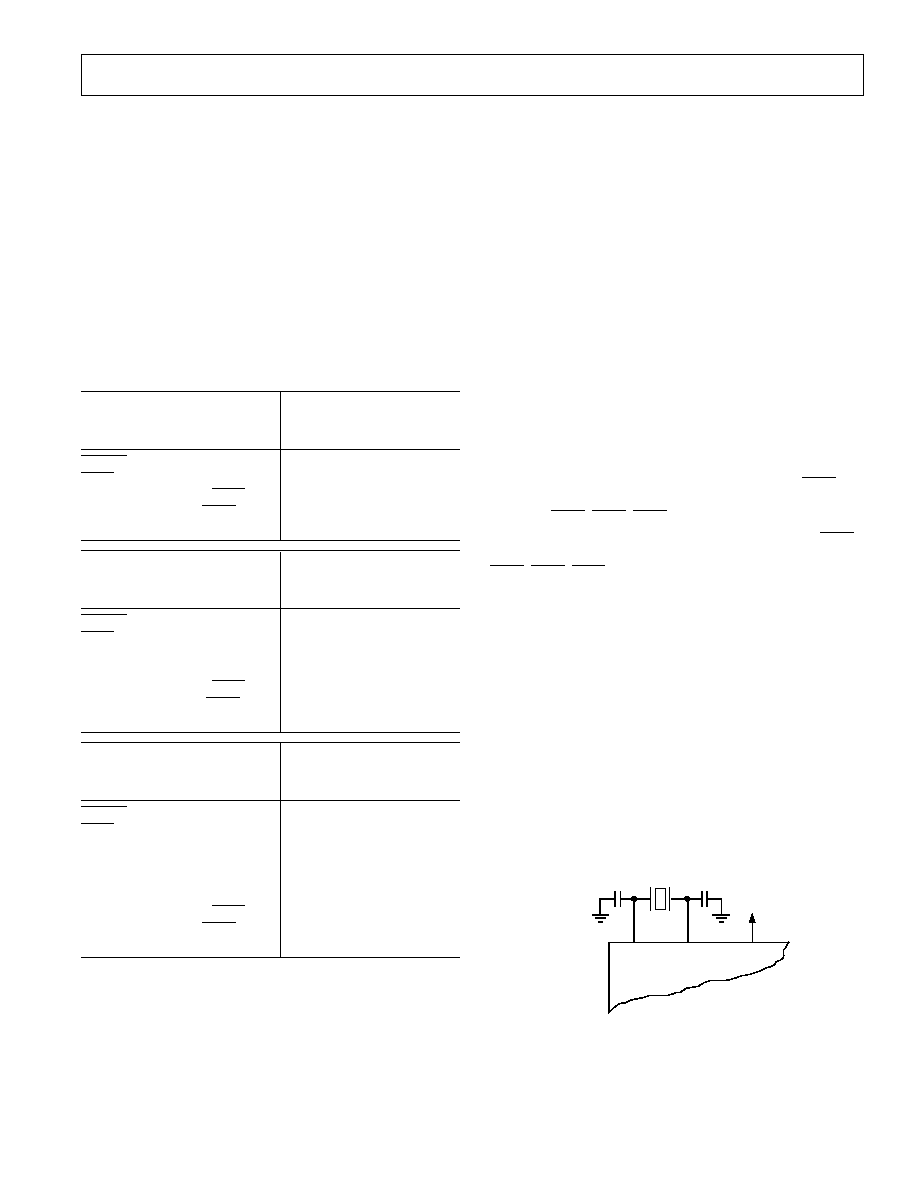
ADSP-21xx
REV. B
≠7≠
The interrupt force and clear register, IFC, is a write-only
register that contains a force bit and a clear bit for each inter-
rupt (except for level-sensitive interrupts and the ADSP-2111
HIP interrupts--these cannot be forced or cleared in software).
When responding to an interrupt, the ASTAT, MSTAT, and
IMASK status registers are pushed onto the status stack and
the PC counter is loaded with the appropriate vector address.
The status stack is seven levels deep (nine levels deep on the
ADSP-2111) to allow interrupt nesting. The stack is automati-
cally popped when a return from the interrupt instruction is
executed.
Pin Definitions
Table IV (on next page) shows pin definitions for the ADSP-
21xx processors. Any inputs not used must be tied to V
DD
.
Table III. Interrupt Vector Addresses & Priority
ADSP-2105
Interrupt
Interrupt
Source
Vector Address
RESET
Startup
0x0000
IRQ2
0x0004 (High Priority)
SPORT1 Transmit or IRQ1
0x0010
SPORT1 Receive or IRQ0
0x0014
Timer
0x0018 (Low Priority)
ADSP-2101/2103/2115/216x
Interrupt
Interrupt
Source
Vector Address
RESET
Startup
0x0000
IRQ2
0x0004 (High Priority)
SPORT0 Transmit
0x0008
SPORT0 Receive
0x000C
SPORT1 Transmit or IRQ1
0x0010
SPORT1 Receive or IRQ0
0x0014
Timer
0x0018 (Low Priority)
ADSP-2111
Interrupt
Interrupt
Source
Vector Address
RESET
Startup
0x0000
IRQ2
0x0004 (High Priority)
HIP Write from Host
0x0008
HIP Read to Host
0x000C
SPORT0 Transmit
0x0010
SPORT0 Receive
0x0014
SPORT1 Transmit or IRQ1
0x0018
SPORT1 Receive or IRQ0
0x001C
Timer
0x0020 (Low Priority)
SYSTEM INTERFACE
Figure 3 shows a typical system for the ADSP-2101, ADSP-
2115, or ADSP-2103, with two serial I/O devices, a boot
EPROM, and optional external program and data memory. A
total of 15K words of data memory and 16K words of program
memory is addressable for the ADSP-2101 and ADSP-2103. A
total of 14.5K words of data memory and 15K words of
program memory is addressable for the ADSP-2115.
Figure 4 shows a system diagram for the ADSP-2105, with one
serial I/O device, a boot EPROM, and optional external
program and data memory. A total of 14.5K words of data
memory and 15K words of program memory is addressable for
the ADSP-2105.
Figure 5 shows a system diagram for the ADSP-2111, with two
serial I/O devices, a host processor, a boot EPROM, and
optional external program and data memory. A total of 15K
words of data memory and 16K words of program memory is
addressable.
Programmable wait-state generation allows the processors to
easily interface to slow external memories.
The ADSP-2101, ADSP-2103, ADSP-2115, and ADSP-2111
processors also provide either: one external interrupt (IRQ2)
and two serial ports (SPORT0, SPORT1), or three external
interrupts (IRQ2, IRQ1, IRQ0) and one serial port (SPORT0).
The ADSP-2105 provides either: one external interrupt (IRQ2)
and one serial port (SPORT1), or three external interrupts
(IRQ2, IRQ1, IRQ0) with no serial port.
Clock Signals
The ADSP-21xx processors' CLKIN input may be driven by a
crystal or by a TTL-compatible external clock signal. The
CLKIN input may not be halted or changed in frequency during
operation, nor operated below the specified low frequency limit.
If an external clock is used, it should be a TTL-compatible
signal running at the instruction rate. The signal should be
connected to the processor's CLKIN input; in this case, the
XTAL input must be left unconnected.
Because the ADSP-21xx processors include an on-chip oscilla-
tor circuit, an external crystal may also be used. The crystal
should be connected across the CLKIN and XTAL pins, with
two capacitors connected as shown in Figure 2. A parallel-
resonant, fundamental frequency, microprocessor-grade crystal
should be used.
Figure 2. External Crystal Connections
CLKIN
CLKOUT
XTAL
ADSP-21xx

ADSP-21xx
≠8≠
REV. B
A clock output signal (CLKOUT) is generated by the processor,
synchronized to the processor's internal cycles.
Reset
The RESET
signal initiates a complete reset of the ADSP-21xx.
The RESET signal must be asserted when the chip is powered
up to assure proper initialization. If the RESET signal is applied
during initial power-up, it must be held long enough to allow
the processor's internal clock to stabilize. If RESET is activated
at any time after power-up and the input clock frequency does
not change, the processor's internal clock continues and does
not require this stabilization time.
The power-up sequence is defined as the total time required for
the crystal oscillator circuit to stabilize after a valid V
DD
is
applied to the processor and for the internal phase-locked loop
(PLL) to lock onto the specific crystal frequency. A minimum of
2000 t
CK
cycles will ensure that the PLL has locked (this does
not, however, include the crystal oscillator start-up time).
During this power-up sequence the RESET signal should be
held low. On any subsequent resets, the RESET signal must
meet the minimum pulse width specification, t
RSP
.
To generate the RESET signal, use either an RC circuit with an
external Schmidt trigger or a commercially available reset IC.
(Do not use only an RC circuit.)
Table IV. ADSP-21xx Pin Definitions
Pin
# of
Input /
Name(s)
Pins
Output
Function
Address
14
O
Address outputs for program, data and boot memory.
Data
1
24
I/O
Data I/O pins for program and data memories. Input only for
boot memory, with two MSBs used for boot memory addresses.
Unused data lines may be left floating.
RESET
1
I
Processor Reset Input
IRQ2
1
I
External Interrupt Request #2
BR
2
1
I
External Bus Request Input
BG
1
O
External Bus Grant Output
PMS
1
O
External Program Memory Select
DMS
1
O
External Data Memory Select
BMS
1
O
Boot Memory Select
RD
1
O
External Memory Read Enable
WR
1
O
External Memory Write Enable
MMAP
1
I
Memory Map Select Input
CLKIN, XTAL
2
I
External Clock or Quartz Crystal Input
CLKOUT
1
O
Processor Clock Output
V
DD
Power Supply Pins
GND
Ground Pins
SPORT0
3
5
I/O
Serial Port 0 Pins (TFS0, RFS0, DT0, DR0, SCLK0)
SPORT1
5
I/O
Serial Port 1 Pins (TFS1, RFS1, DT1, DR1, SCLK1)
or Interrupts & Flags:
IRQ0
(RFS1)
1
I
External Interrupt Request #0
IRQ1
(TFS1)
1
I
External Interrupt Request #1
FI (DR1)
1
I
Flag Input Pin
FO (DT1)
1
O
Flag Output Pin
FL2≠0 (ADSP-2111 Only)
3
O
General Purpose Flag Output Pins
Host Interface Port
(ADSP-2111 Only)
HSEL
1
I
HIP Select Input
HACK
1
O
HIP Acknowledge Output
HSIZE
1
I
8/16-Bit Host Select (0 = 16-Bit, 1 = 8-Bit)
BMODE
1
I
Boot Mode Select (0 = Standard EPROM Booting, 1 = HIP Booting)
HMD0
1
I
Bus Strobe Select (0 = RD/WR, 1 = RW/DS)
HMD1
1
I
HIP Address/Data Mode Select (0 = Separate, 1 = Multiplexed)
HRD
/HRW
1
I
HIP Read Strobe or Read/Write Select
HWR
/HDS
1
I
HIP Write Strobe or Host Data Strobe Select
HD15≠0/HAD15-0
16
I/O
HIP Data or HIP Data and Address
HA2/ALE
1
I
Host Address 2 Input or Address Latch Enable Input
HA1≠0/Unused
2
I
Host Address 1 and 0 Inputs
NOTES
1
Unused data bus lines may be left floating.
2
BR
must be tied high (to V
DD
) if not used.
3
ADSP-2105 does not have SPORT0. (SPORT0 pins are No Connects on the ADSP-2105.)

ADSP-21xx
REV. B
≠9≠
Figure 4. ADSP-2105 System
Figure 3. ADSP-2101/ADSP-2103/ADSP-2115 System
BR
BG
CLKIN
RESET
IRQ2
BMS
ADSP-2101
or
ADSP-2103
or
ADSP-2115
CLKOUT
ADDR
DATA
(OPTIONAL)
1x CLOCK
or
CRYSTAL
PMS
DMS
RD
WR
ADDR
13-0
DATA
23-0
ADDR
DATA
(OPTIONAL)
ADDR
DATA
BOOT
MEMORY
e.g. EPROM
2764
27128
27256
27512
PROGRAM
MEMORY
DATA
MEMORY
&
PERIPHERALS
14
24
D
23-22
A
13-0
D
15-8
D
23-0
D
23-8
A
13-0
A
13-0
XTAL
MMAP
SERIAL
DEVICE
(OPTIONAL)
SCLK1
RFS1
or IRQ0
TFS1
or IRQ1
DT1
or FO
DR1
or FI
SPORT 1
SCLK0
RFS0
TFS0
DT0
DR0
SPORT 0
SERIAL
DEVICE
(OPTIONAL)
OE
WE
CS
OE
WE
CS
OE
CS
THE TWO MSBs OF THE DATA BUS (D
23-22
) ARE USED TO SUPPLY THE TWO MSBs OF THE
BOOT MEMORY EPROM ADDRESS. THIS IS ONLY REQUIRED FOR THE 27256 AND 27512.
BR
BG
CLKIN
RESET
IRQ2
BMS
ADSP-2105
CLKOUT
ADDR
DATA
(OPTIONAL)
1x CLOCK
or
CRYSTAL
PMS
DMS
RD
WR
ADDR
13-0
DATA
23-0
ADDR
DATA
(OPTIONAL)
ADDR
DATA
BOOT
MEMORY
e.g. EPROM
2764
27128
27256
27512
PROGRAM
MEMORY
DATA
MEMORY
&
PERIPHERALS
14
24
D
23-22
A
13-0
D
15-8
D
23-0
D
23-8
A
13-0
A
13-0
XTAL
MMAP
SERIAL
DEVICE
(OPTIONAL)
SCLK1
RFS1
or IRQ0
TFS1
or IRQ1
DT1
or FO
DR1
or FI
SPORT 1
OE
WE
CS
OE
WE
CS
OE
CS
THE TWO MSBs OF THE DATA BUS (D
23-22
) ARE USED TO SUPPLY THE TWO MSBs OF THE
BOOT MEMORY EPROM ADDRESS. THIS IS ONLY REQUIRED FOR THE 27256 AND 27512.
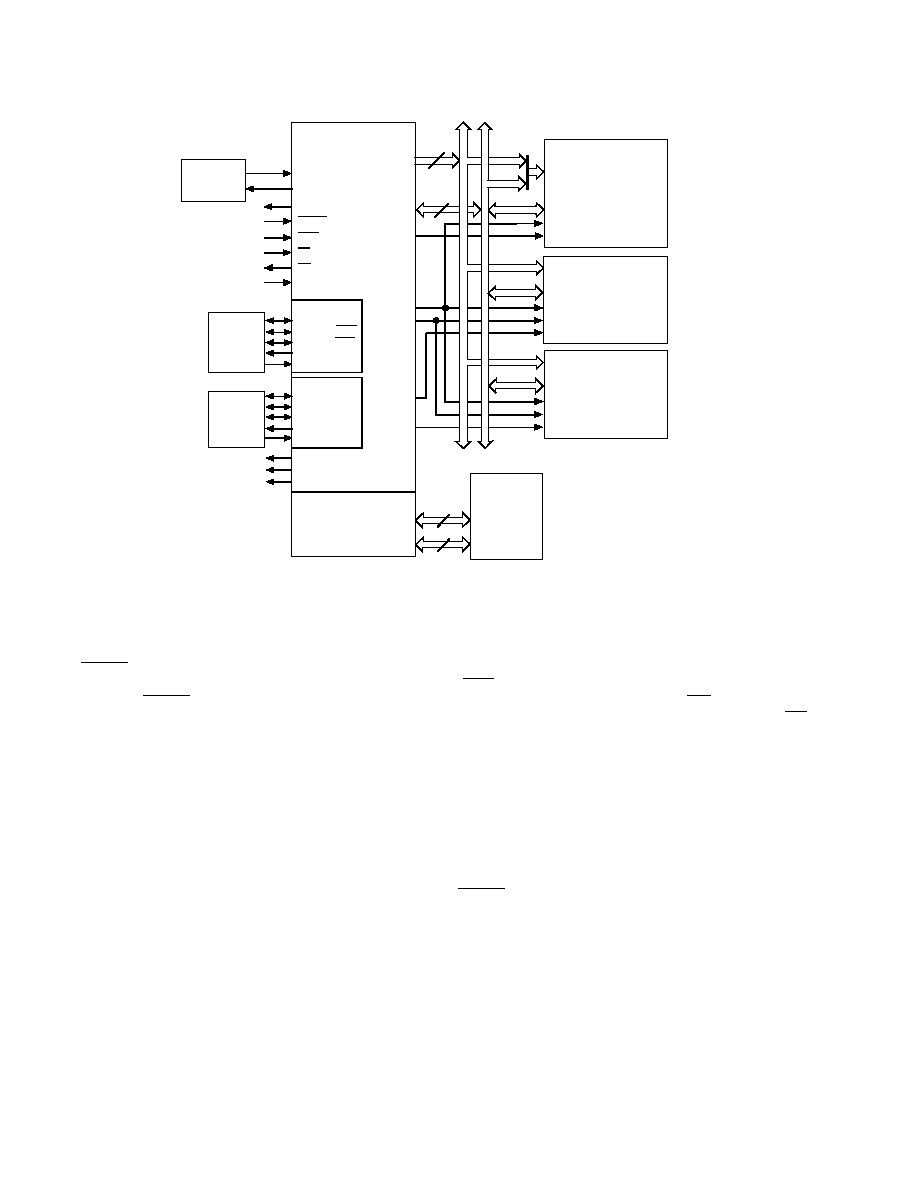
ADSP-21xx
≠10≠
REV. B
Figure 5. ADSP-2111 System
The RESET input resets all internal stack pointers to the empty
stack condition, masks all interrupts, and clears the MSTAT
register. When RESET is released, the boot loading sequence is
performed (provided there is no pending bus request and the
chip is configured for booting, with MMAP = 0). The first
instruction is then fetched from internal program memory
location 0x0000.
Program Memory Interface
The on-chip program memory address bus (PMA) and on-chip
program memory data bus (PMD) are multiplexed with the on-
chip data memory buses (DMA, DMD), creating a single
external data bus and a single external address bus. The external
data bus is bidirectional and is 24 bits wide to allow instruction
fetches from external program memory. Program memory may
contain code and data.
The external address bus is 14 bits wide. For the ADSP-2101,
ADSP-2103, and ADSP-2111, these lines can directly address
up to 16K words, of which 2K are on-chip. For the ADSP-2105
and ADSP-2115, the address lines can directly address up to
15K words, of which 1K is on-chip.
The data lines are bidirectional. The program memory select
(PMS) signal indicates accesses to program memory and can be
used as a chip select signal. The write (WR) signal indicates a
write operation and is used as a write strobe. The read (RD)
signal indicates a read operation and is used as a read strobe or
output enable signal.
The ADSP-21xx processors write data from their 16-bit
registers to 24-bit program memory using the PX register to
provide the lower eight bits. When the processor reads 16-bit
data from 24-bit program memory to a 16-bit data register, the
lower eight bits are placed in the PX register.
The program memory interface can generate 0 to 7 wait states
for external memory devices; default is to 7 wait states after
RESET
.
Program Memory Maps
Program memory can be mapped in two ways, depending on the
state of the MMAP pin. Figure 6 shows the two program
memory maps for the ADSP-2101, ADSP-2103, and
ADSP-2111. Figure 8 shows the program memory maps for the
ADSP-2105 and ADSP-2115. Figures 7 and 9 show the
program memory maps for the ADSP-2161/62 and ADSP-2163/
64, respectively.
BR
BG
CLKIN
RESET
IRQ2
BMS
CLKOUT
ADDR
DATA
(OPTIONAL)
1x CLOCK
or
CRYSTAL
PMS
DMS
RD
WR
ADDR
13-0
DATA
23-0
ADDR
DATA
(OPTIONAL)
ADDR
DATA
BOOT
MEMORY
e.g. EPROM
2764
27128
27256
27512
PROGRAM
MEMORY
DATA
MEMORY
&
PERIPHERALS
14
24
D
23-22
A
13-0
D
15-8
D
23-0
D
23-8
A
13-0
A
13-0
XTAL
MMAP
SERIAL
DEVICE
(OPTIONAL)
SCLK1
RFS1
or
IRQ0
TFS1
or
IRQ1
DT1
or
FO
DR1
or
FI
SPORT 1
SCLK0
RFS0
TFS0
DT0
DR0
SPORT 0
SERIAL
DEVICE
(OPTIONAL)
OE
WE
CS
OE
WE
CS
OE
CS
ADSP-2111
HOST
PROCESSOR
(OPTIONAL)
HOST INTERFACE PORT
CONTROL
DATA / ADDR
(OPTIONAL)
FL0
FL1
FL2
7
16
THE TWO MSBs OF THE DATA BUS (D
23-22
) ARE USED TO SUPPLY THE TWO MSBs OF THE
BOOT MEMORY EPROM ADDRESS. THIS IS ONLY REQUIRED FOR THE 27256 AND 27512.
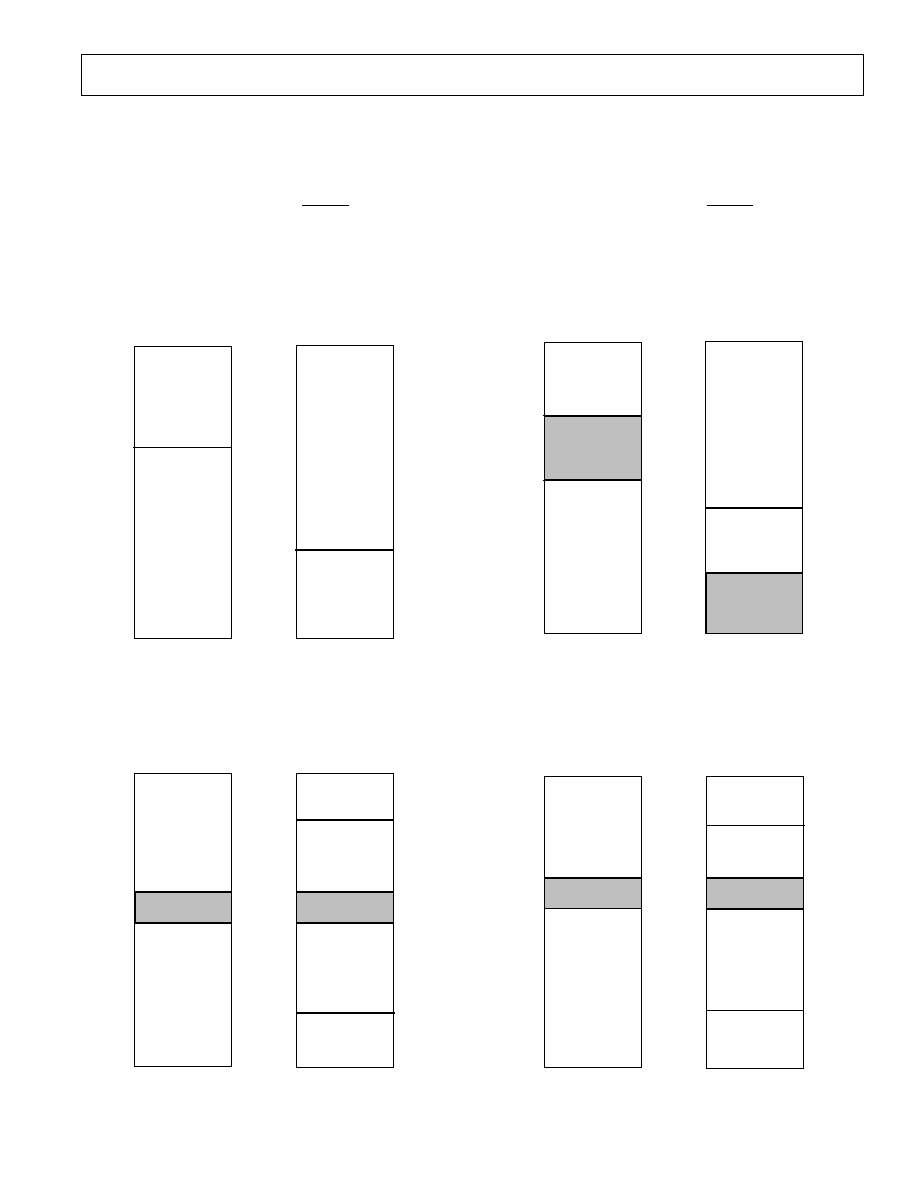
ADSP-21xx
REV. B
≠11≠
ADSP-2101/ADSP-2103/ADSP-2111
When MMAP = 0, on-chip program memory RAM occupies
2K words beginning at address 0x0000. Off-chip program
memory uses the remaining 14K words beginning at address
0x0800. In this configuration≠when MMAP = 0≠the boot
loading sequence (described below in "Boot Memory Inter-
face") is automatically initiated when RESET is released.
When MMAP = 1, 14K words of off-chip program memory
begin at address 0x0000 and on-chip program memory RAM is
located in the upper 2K words, beginning at address 0x3800. In
this configuration, program memory is not booted although it
can be written to and read under program control.
ADSP-2105/ADSP-2115
When MMAP = 0, on-chip program memory RAM occupies
1K words beginning at address 0x0000. Off-chip program
memory uses the remaining 14K words beginning at address
0x0800. In this configuration≠when MMAP = 0≠the boot
loading sequence (described below in "Boot Memory Inter-
face") is automatically initiated when RESET is released.
When MMAP = 1, 14K words of off-chip program memory
begin at address 0x0000 and on-chip program memory RAM is
located in the 1K words between addresses 0x3800≠0x3BFF. In
this configuration, program memory is not booted although it
can be written to and read under program control.
INTERNAL
RAM
LOADED FROM
EXTERNAL
BOOT MEMORY
EXTERNAL
0x07FF
0x0800
0x3FFF
0x0000
EXTERNAL
No Booting
0x37FF
0x3800
0x3FFF
0x0000
MMAP=0
MMAP=1
INTERNAL
RAM
2K
14K
2K
14K
Figure 6. ADSP-2101/ADSP-2103/ADSP-2111 Program
Memory Maps
Figure 8. ADSP-2105/ADSP-2115 Program Memory Maps
Figure 7. ADSP-2161/62 Program Memory Maps
Figure 9. ADSP-2163/64 Program Memory Maps
0x07FF
0x0800
0x1FF0
0x1FFF
0x2000
0x1FF0
0x1FFF
0x2000
MMAP=0
0x3FFF
0x0000
8K
EXTERNAL
8K
INTERNAL
ROM
0x0000
MMAP=1
0x3FFF
0x3800
0x37FF
2K
EXTERNAL
6K
INTERNAL
ROM
6K
EXTERNAL
2K
INTERNAL
ROM
RESERVED
RESERVED
INTERNAL RAM
LOADED FROM
EXTERNAL
BOOT MEMORY
EXTERNAL
0x03FF
0x0400
0x3FFF
0x0000
EXTERNAL
0x3BFF
0x3C00
0x3FFF
0x0000
MMAP=0
MMAP=1
No Booting
0x37FF
0x3800
0x07FF
0x0800
RESERVED
1K
14K
14K
1K
INTERNAL RAM
1K
1K
RESERVED
4K
INTERNAL
ROM
12K
EXTERNAL
0x3FFF
0x0000
2K
EXTERNAL
0x3FFF
0x0000
MMAP=0
MMAP=1
0x37FF
0x3800
2K
INTERNAL
ROM
2K
INTERNAL
ROM
10K
EXTERNAL
0x07FF
0x0800
0x0FF0
0x0FFF
0x1000
0x0FF0
RESERVED
RESERVED
0x0FFF
0x1000
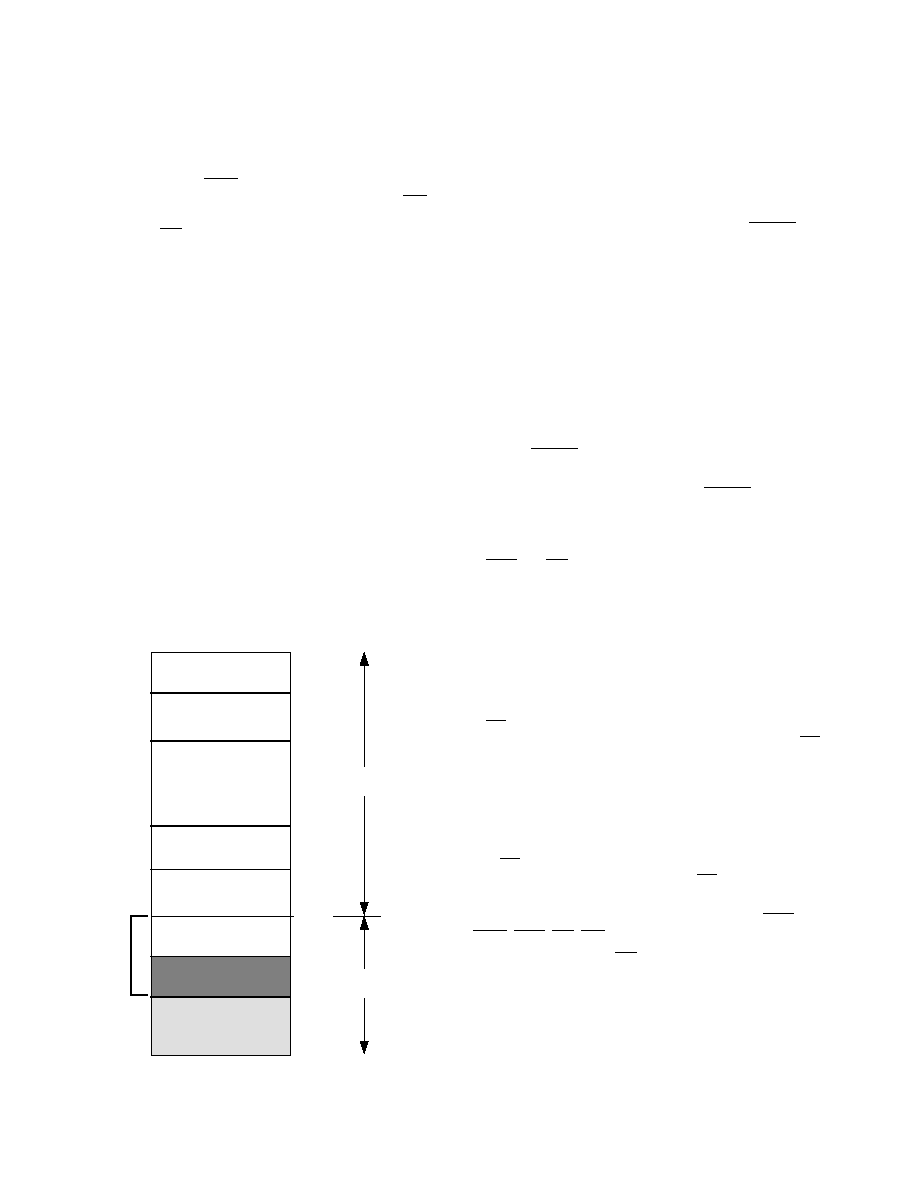
ADSP-21xx
≠12≠
REV. B
All Processors
The remaining 14K of data memory is located off-chip. This
external data memory is divided into five zones, each associated
with its own wait-state generator. This allows slower peripherals
to be memory-mapped into data memory for which wait states
are specified. By mapping peripherals into different zones, you
can accommodate peripherals with different wait-state require-
ments. All zones default to seven wait states after RESET.
Boot Memory Interface
On the ADSP-2101, ADSP-2103, and ADSP-2111, boot
memory is an external 64K by 8 space, divided into eight
separate 8K by 8 pages. On the ADSP-2105 and ADSP-2115,
boot memory is a 32K by 8 space, divided into eight separate
4K by 8 pages. The 8-bit bytes are automatically packed into
24-bit instruction words by each processor, for loading into on-
chip program memory.
Three bits in the processors' System Control Register select
which page is loaded by the boot memory interface. Another bit
in the System Control Register allows the forcing of a boot
loading sequence under software control. Boot loading from
Page 0 after RESET is initiated automatically if MMAP = 0.
The boot memory interface can generate zero to seven wait
states; it defaults to three wait states after RESET. This allows
the ADSP-21xx to boot from a single low cost EPROM such as
a 27C256. Program memory is booted one byte at a time and
converted to 24-bit program memory words.
The BMS and RD signals are used to select and to strobe the
boot memory interface. Only 8-bit data is read over the data
bus, on pins D8-D15. To accommodate up to eight pages of
boot memory, the two MSBs of the data bus are used in the
boot memory interface as the two MSBs of the boot memory
address: D23, D22, and A13 supply the boot page number.
The ADSP-2100 Family Assembler and Linker allow the
creation of programs and data structures requiring multiple boot
pages during execution.
The BR signal is recognized during the booting sequence. The
bus is granted after loading the current byte is completed. BR
during booting may be used to implement booting under control
of a host processor.
Bus Interface
The ADSP-21xx processors can relinquish control of their data
and address buses to an external device. When the external
device requires control of the buses, it asserts the bus request
signal (BR). If the ADSP-21xx is not performing an external
memory access, it responds to the active BR input in the next
cycle by:
∑
Three-stating the data and address buses and the PMS,
DMS, BMS, RD, WR output drivers,
∑
Asserting the bus grant (BG) signal,
∑
and halting program execution.
If the Go mode is set, however, the ADSP-21xx will not halt
program execution until it encounters an instruction that
requires an external memory access.
Data Memory Interface
The data memory address bus (DMA) is 14 bits wide. The
bidirectional external data bus is 24 bits wide, with the upper 16
bits used for data memory data (DMD) transfers.
The data memory select (DMS) signal indicates access to data
memory and can be used as a chip select signal. The write (WR)
signal indicates a write operation and can be used as a write
strobe. The read (RD) signal indicates a read operation and can
be used as a read strobe or output enable signal.
The ADSP-21xx processors support memory-mapped I/O, with
the peripherals memory-mapped into the data memory address
space and accessed by the processor in the same manner as data
memory.
Data Memory Map
ADSP-2101/ADSP-2103/ADSP-2111
For the ADSP-2101, ADSP-2103, and ADSP-2111, on-chip
data memory RAM resides in the 1K words beginning at
address 0x3800, as shown in Figure 10. Data memory locations
from 0x3C00 to the end of data memory at 0x3FFF are
reserved. Control and status registers for the system, timer,
wait-state configuration, and serial port operations are located in
this region of memory.
ADSP-2105/ADSP-2115
For the ADSP-2105 and ADSP-2115, on-chip data memory
RAM resides in the 512 words beginning at address 0x3800,
also shown in Figure 10. Data memory locations from 0x3A00
to the end of data memory at 0x3FFF are reserved. Control and
status registers for the system, timer, wait-state configuration,
and serial port operations are located in this region of memory.
Figure 10. Data Memory Map (All Processors)
0x3A00
0x0400
0x0000
1K EXTERNAL
DWAIT0
1K EXTERNAL
DWAIT1
10K EXTERNAL
DWAIT2
1K EXTERNAL
DWAIT3
0x0800
0x3000
512 for ADSP-2105
ADSP-2115
ADSP-216x
EXTERNAL
RAM
INTERNAL
RAM
0x3C00
0x3FFF
1K for ADSP-2101
ADSP-2103
ADSP-2111
MEMORY-MAPPED
CONTROL REGISTERS
& RESERVED
1K EXTERNAL
DWAIT4
0x3400
0x3800

ADSP-21xx
REV. B
≠13≠
If the ADSP-21xx is performing an external memory access
when the external device asserts the BR signal, it will not three-
state the memory interfaces or assert the BG signal until the
cycle after the access completes (up to eight cycles later depend-
ing on the number of wait states). The instruction does not need
to be completed when the bus is granted; the ADSP-21xx will
grant the bus in between two memory accesses if an instruction
requires more than one external memory access.
When the BR signal is released, the processor releases the BG
signal, re-enables the output drivers and continues program
execution from the point where it stopped.
The bus request feature operates at all times, including when
the processor is booting and when RESET is active. If this
feature is not used, the BR input should be tied high (to V
DD
).
Low Power IDLE Instruction
The IDLE instruction places the ADSP-21xx processor in low
power state in which it waits for an interrupt. When an interrupt
occurs, it is serviced and execution continues with instruction
following IDLE. Typically this next instruction will be a JUMP
back to the IDLE instruction. This implements a low-power
standby loop.
The IDLE n instruction is a special version of IDLE that slows
the processor's internal clock signal to further reduce power
consumption. The reduced clock frequency, a programmable
fraction of the normal clock rate, is specified by a selectable
divisor, n, given in the IDLE instruction. The syntax of the
instruction is:
IDLE n;
where n = 16, 32, 64, or 128.
The instruction leaves the chip in an idle state, operating at the
slower rate. While it is in this state, the processor's other
internal clock signals, such as SCLK, CLKOUT, and the timer
clock, are reduced by the same ratio. Upon receipt of an
enabled interrupt, the processor will stay in the IDLE state for
up to a maximum of n CLKIN cycles, where n is the divisor
specified in the instruction, before resuming normal operation.
When the IDLE n instruction is used, it slows the processor's
internal clock and thus its response time to incoming interrupts≠
the 1-cycle response time of the standard IDLE state is in-
creased by n, the clock divisor. When an enabled interrupt is
received, the ADSP-21xx will remain in the IDLE state for up
to a maximum of n CLKIN cycles (where n = 16, 32, 64, or
128) before resuming normal operation.
When the IDLE n instruction is used in systems that have an
externally generated serial clock (SCLK), the serial clock rate
may be faster than the processor's reduced internal clock rate.
Under these conditions, interrupts must not be generated at a
faster rate than can be serviced, due to the additional time the
processor takes to come out of the IDLE state (a maximum of n
CLKIN cycles).
ADSP-216x Prototyping
You can prototype your ADSP-216x system with either the
ADSP-2101 or ADSP-2103 RAM-based processors. When code
is fully developed and debugged, it can be submitted to Analog
Devices for conversion into a ADSP-216x ROM product.
The ADSP-2101 EZ-ICE emulator can be used for develop-
ment of ADSP-216x systems. For the 3.3 V ADSP-2162 and
ADSP-2164, a voltage converter interface board provides 3.3 V
emulation.
Additional overlay memory is used for emulation of ADSP-
2161/62 systems. It should be noted that due to the use of off-
chip overlay memory to emulate the ADSP-2161/62, a perfor-
mance loss may be experienced when both executing instruc-
tions and fetching program memory data from the off-chip
overlay memory in the same cycle. This can be overcome by
locating program memory data in on-chip memory.
Ordering Procedure for ADSP-216x ROM Processors
To place an order for a custom ROM-coded ADSP-2161,
ADSP-2162, ADSP-2163, or ADSP-2164 processor, you must:
1. Complete the following forms contained in the ADSP ROM
Ordering Package, available from your Analog Devices sales
representative:
ADSP-216x ROM Specification Form
ROM Release Agreement
ROM NRE Agreement & Minimum Quantity Order (MQO)
Acceptance Agreement for Pre-Production ROM Products
2. Return the forms to Analog Devices along with two copies of
the Memory Image File (.EXE file) of your ROM code. The
files must be supplied on two 3.5" or 5.25" floppy disks for
the IBM PC (DOS 2.01 or higher).
3. Place a purchase order with Analog Devices for non-recurring
engineering changes (NRE) associated with ROM product
development.
After this information is received, it is entered into Analog
Devices' ROM Manager System which assigns a custom ROM
model number to the product. This model number will be
branded on all prototype and production units manufactured to
these specifications.
To minimize the risk of code being altered during this process,
Analog Devices verifies that the .EXE files on both floppy disks
are identical, and recalculates the checksums for the .EXE file
entered into the ROM Manager System. The checksum data, in
the form of a ROM Memory Map, a hard copy of the .EXE file,
and a ROM Data Verification form are returned to you for
inspection.

ADSP-21xx
≠14≠
REV. B
A signed ROM Verification Form and a purchase order for
production units are required prior to any product being
manufactured. Prototype units may be applied toward the
minimum order quantity.
Upon completion of prototype manufacture, Analog Devices
will ship prototype units and a delivery schedule update for
production units. An invoice against your purchase order for the
NRE charges is issued at this time.
There is a charge for each ROM mask generated and a mini-
mum order quantity. Consult your sales representative for
details. A separate order must be placed for parts of a specific
package type, temperature range, and speed grade.
Package & Speed
Lot # & Revision Code
Date Code
Functional Differences for Older Revision Devices
Older revisions of the ADSP-21xx processors have slight
differences in functionality. The two differences are as follows:
∑
Bus Grant (BG) is asserted in the same cycle that Bus
Request (BR) is recognized (i.e. when setup and hold time
requirements are met for the BR input). Bus Request input is
a synchronous input rather than asynchronous. (In newer
revision devices, BG is asserted in the cycle after BR is
recognized.)
∑
Only the standard IDLE instruction is available, not the
clock-reducing IDLE n instruction.
To determine the revision of a particular ADSP-21xx device,
inspect the marking on the device. For example, an ADSP-2101
of revision 6.0 will have the following marking:
The revision codes for the older versions of each ADSP-21xx
device are as follows:
Processor
Old Functionality
New Functionality
ADSP-2101
Revision Code
5.0
Revision Code
6.0
ADSP-2105
No Revision Code
Revision Code
1.0
ADSP-2115
Revision Code < 1.0
Revision Code
1.0
ADSP-2111
RevisionCode < 2.0
Revision Code
2.0
ADSP-2103
Revision code
5.0
Revision code
6.0
a
ADSP-2101
KS-66
EE/A12345-6.0
9234

ADSP-21xx
REV. B
≠15≠
Instruction Set
The ADSP-21xx assembly language uses an algebraic syntax for
ease of coding and readability. The sources and destinations of
computations and data movements are written explicitly in each
assembly statement, eliminating cryptic assembler mnemonics.
Every instruction assembles into a single 24-bit word and
executes in a single cycle. The instructions encompass a wide
variety of instruction types along with a high degree of
operational parallelism. There are five basic categories of
instructions: data move instructions, computational instruc-
tions, multifunction instructions, program flow control instruc-
tions and miscellaneous instructions. Multifunction instructions
perform one or two data moves and a computation.
The instruction set is summarized below. The ADSP-2100
Family Users Manual contains a complete reference to the
instruction set.
ALU Instructions
[IF cond]
AR|AF
=
xop + yop [+ C] ;
Add/Add with Carry
=
xop ≠ yop [+ C≠ 1] ;
Subtract X ≠ Y/Subtract X ≠ Y with Borrow
=
yop ≠ xop [+ C≠ 1] ;
Subtract Y ≠ X/Subtract Y ≠ X with Borrow
=
xop AND yop ;
AND
=
xop OR yop ;
OR
=
xop XOR yop ;
XOR
=
PASS xop ;
Pass, Clear
=
≠ xop ;
Negate
=
NOT xop ;
NOT
=
ABS xop ;
Absolute Value
=
yop + 1 ;
Increment
=
yop ≠ 1 ;
Decrement
=
DIVS yop, xop ;
Divide
=
DIVQ xop ;
MAC Instructions
[IF cond]
MR|MF =
xop * yop ;
Multiply
=
MR + xop * yop ;
Multiply/Accumulate
=
MR ≠ xop * yop ;
Multiply/Subtract
=
MR ;
Transfer MR
=
0 ;
Clear
IF MV SAT MR ;
Conditional MR Saturation
Shifter Instructions
[IF cond]
SR = [SR OR] ASHIFT xop ;
Arithmetic Shift
[IF cond]
SR = [SR OR] LSHIFT xop ;
Logical Shift
SR = [SR OR] ASHIFT xop BY <exp>;
Arithmetic Shift Immediate
SR = [SR OR] LSHIFT xop BY <exp>;
Logical Shift Immediate
[IF cond]
SE = EXP xop ;
Derive Exponent
[IF cond]
SB = EXPADJ xop ;
Block Exponent Adjust
[IF cond]
SR = [SR OR] NORM xop ;
Normalize
Data Move Instructions
reg = reg ;
Register-to-Register Move
reg = <data> ;
Load Register Immediate
reg = DM (<addr>) ;
Data Memory Read (Direct Address)
dreg = DM (Ix , My) ;
Data Memory Read (Indirect Address)
dreg = PM (Ix , My) ;
Program Memory Read (Indirect Address)
DM (<addr>) = reg ;
Data Memory Write (Direct Address)
DM (Ix , My) = dreg ;
Data Memory Write (Indirect Address)
PM (Ix , My) = dreg ;
Program Memory Write (Indirect Address)
Multifunction Instructions
<ALU>|<MAC>|<SHIFT> , dreg = dreg ;
Computation with Register-to-Register Move
<ALU>|<MAC>|<SHIFT> , dreg = DM (Ix , My) ;
Computation with Memory Read
<ALU>|<MAC>|<SHIFT> , dreg = PM (Ix , My) ;
Computation with Memory Read
DM (Ix , My) = dreg , <ALU>|<MAC>|<SHIFT> ;
Computation with Memory Write
PM (Ix , My) = dreg , <ALU>|<MAC>|<SHIFT> ;
Computation with Memory Write
dreg = DM (Ix , My) , dreg = PM (Ix , My) ;
Data & Program Memory Read
<ALU>|<MAC> , dreg = DM (Ix , My) , dreg = PM (Ix , My) ;
ALU/MAC with Data & Program Memory Read

ADSP-21xx
≠16≠
REV. B
Program Flow Instructions
DO <addr> [UNTIL term] ;
Do Until Loop
[IF cond] JUMP (Ix) ;
Jump
[IF cond] JUMP <addr>;
[IF cond] CALL (Ix) ;
Call Subroutine
[IF cond] CALL <addr>;
IF [NOT ] FLAG_IN
JUMP <addr>;
Jump/Call on Flag In Pin
IF [NOT ] FLAG_IN
CALL <addr>;
[IF cond] SET|RESET|TOGGLE FLAG_OUT [, ...] ;
Modify Flag Out Pin
[IF cond] RTS ;
Return from Subroutine
[IF cond] RTI ;
Return from Interrupt Service Routine
IDLE [(n)] ;
Idle
Miscellaneous Instructions
NOP ;
No Operation
MODIFY (Ix , My);
Modify Address Register
[PUSH STS] [, POP CNTR] [, POP PC] [, POP LOOP] ;
Stack Control
ENA|DIS
SEC_REG [, ...] ;
Mode Control
BIT_REV
AV_LATCH
AR_SAT
M_MODE
TIMER
G_MODE
Assembly Code Example
The following example is a code fragment that performs the filter tap update for an adaptive filter based on a least-mean-squared
algorithm. Notice that the computations in the instructions are written like algebraic equations.
MF=MX0* MY1 ( RND), MX0=DM(I2,M1);
{ MF=error * b eta}
MR=MX0* MF ( RND), AY0=PM(I6,M5);
DO adapt UNTIL CE;
AR=MR1+AY0, MX0=DM(I2,M1), AY0=PM(I6,M7);
adapt:
PM(I6,M6)= A R, MR=MX0 * MF ( RND);
MODIFY(I2,M3);
{Point to oldest data}
MODIFY(I6,M7);
{Point to start of data}
Notation Conventions
Ix
Index registers for indirect addressing
My
Modify registers for indirect addressing
<data>
Immediate data value
<addr>
Immediate address value
<exp>
Exponent (shift value) in shift immediate instructions (8-bit signed number)
<ALU>
Any ALU instruction (except divide)
<MAC>
Any multiply-accumulate instruction
<SHIFT>
Any shift instruction (except shift immediate)
cond
Condition code for conditional instruction
term
Termination code for DO UNTIL loop
dreg
Data register (of ALU, MAC, or Shifter)
reg
Any register (including dregs)
;
A semicolon terminates the instruction
,
Commas separate multiple operations of a single instruction
[ ]
Optional part of instruction
[, ...]
Optional, multiple operations of an instruction
option1 | option2
List of options; choose one.

REV. B
≠17≠
ADSP-2101/2105/2115/2161/2163≠SPECIFICATIONS
CAUTION
ESD (electrostatic discharge) sensitive device. Electrostatic charges as high as 4000 V readily
accumulate on the human body and test equipment and can discharge without detection. Although
the ADSP-21xx processors feature proprietary ESD protection circuitry to dissipate high energy
electrostatic discharges (Human Body Model), permanent damage may occur to devices subjected
to such discharges. Therefore, proper ESD precautions are recommended to avoid performance
degradation or loss of functionality. Unused devices must be stored in conductive foam or shunts,
and the foam should be discharged to the destination socket before the devices are removed. Per
method 3015 of MIL-STD-883, the ADSP-21xx processors have been classified as Class 1 devices.
RECOMMENDED OPERATING CONDITIONS
K Grade
B Grade
T Grade
Parameter
Min
Max
Min
Max
Min
Max
Unit
V
DD
Supply Voltage
4.50
5.50
4.50
5.50
4.50
5.50
V
T
AMB
Ambient Operating Temperature
0
+70
≠40
+85
≠55
+125
∞
C
See "Environmental Conditions" for information on thermal specifications.
ELECTRICAL CHARACTERISTICS
Parameter
Test Conditions
Min
Max
Unit
V
IH
Hi-Level Input Voltage
3, 5
@ V
DD
= max
2.0
V
V
IH
Hi-Level CLKIN Voltage
@ V
DD
= max
2.2
V
V
IL
Lo-Level Input Voltage
1, 3
@ V
DD
= min
0.8
V
V
OH
Hi-Level Output Voltage
2, 3, 7
@ V
DD
= min, I
OH
= ≠0.5 mA
2.4
V
@ V
DD
= min, I
OH
= ≠100
µ
A
8
V
DD
≠ 0.3
V
V
OL
Lo-Level Output Voltage
2, 3, 7
@ V
DD
= min, I
OL
= 2 mA
0.4
V
I
IH
Hi-Level Input Current
1
@ V
DD
= max, V
IN
= V
DD
max
10
µ
A
I
IL
Lo-Level Input Current
1
@ V
DD
= max, V
IN
= 0 V
10
µ
A
I
OZH
Tristate Leakage Current
4
@ V
DD
= max, V
IN
= V
DD
max
6
10
µ
A
I
OZL
Tristate Leakage Current
4
@ V
DD
= max, V
IN
= 0 V
6
10
µ
A
C
I
Input Pin Capacitance
1, 8, 9
@ V
IN
= 2.5 V, f
IN
= 1.0 MHz, T
AMB
= 25
∞
C
8
pF
C
O
Output Pin Capacitance
4, 8, 9, 10
@ V
IN
= 2.5 V, f
IN
= 1.0 MHz, T
AMB
= 25
∞
C
8
pF
NOTES
1
Input-only pins: CLKIN, RESET, IRQ2, BR, MMAP, DR1, DR0 (not on ADSP-2105).
2
Output pins: BG, PMS, DMS, BMS, RD, WR, A0≠A13, CLKOUT, DT1, DT0 (not on ADSP-2105).
3
Bidirectional pins: D0≠D23, SCLK1, RFS1, TFS1, SCLK0 (not on ADSP-2105), RFS0 (not on ADSP-2105), TFS0 (not on ADSP-2105).
4
Tristatable pins: A0≠A13, D0≠D23, PMS, DMS, BMS, RD, WR, DT1, SCLK1, RSF1, TFS1, DT0 (not on ADSP-2105), SCLK0 (not on ADSP-2105),
RFS0 (not on ADSP-2105), TFS0 (not on ADSP-2105).
5
Input-only pins: RESET, IRQ2, BR, MMAP, DR1, DR0 (not on ADSP-2105).
6
0 V on BR, CLKIN Active (to force tristate condition).
7
Although specified for TTL outputs, all ADSP-21xx outputs are CMOS-compatible and will drive to V
DD
and GND, assuming no dc loads.
8
Guaranteed but not tested.
9
Applies to PGA, PLCC, PQFP package types.
10
Output pin capacitance is the capacitive load for any three-stated output pin.
Specifications subject to change without notice.
ABSOLUTE MAXIMUM RATINGS
*
Supply Voltage . . . . . . . . . . . . . . . . . . . . . . . . . . ≠0.3 V to +7 V
Input Voltage . . . . . . . . . . . . . . . . . . . . . ≠0.3 V to V
DD
+ 0.3 V
Output Voltage Swing . . . . . . . . . . . . . . ≠0.3 V to V
DD
+ 0.3 V
Operating Temperature Range (Ambient) . . . ≠55∫C to +125∫C
Storage Temperature Range . . . . . . . . . . . . . ≠65∫C to +150∫C
Lead Temperature (10 sec) PGA . . . . . . . . . . . . . . . . . +300∫C
Lead Temperature (5 sec) PLCC, PQFP, TQFP . . . . +280∫C
*Stresses greater than those listed above may cause permanent damage to the
device. These are stress ratings only, and functional operation of the device at these
or any other conditions greater than those indicated in the operational sections of
this specification is not implied. Exposure to absolute maximum rating conditions
for extended periods may affect device reliability.
WARNING!
ESD SENSITIVE DEVICE
ADSP-21xx
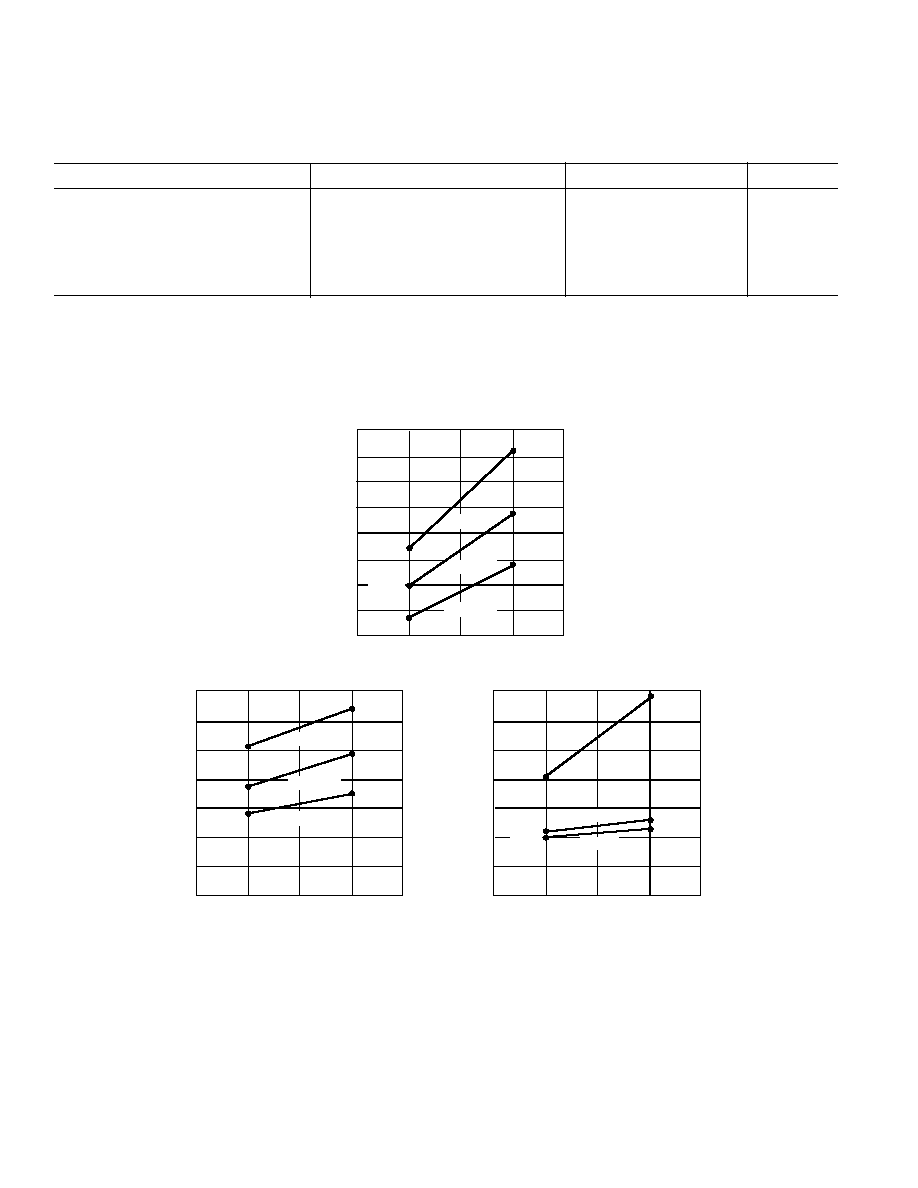
ADSP-21xx
≠18≠
REV. B
SPECIFICATIONS (ADSP-2101/2105/2115/2161/2163)
SUPPLY CURRENT & POWER (ADSP-2101/2105/2115/2161/2163)
Parameter
Test Conditions
Min
Max
Unit
I
DD
Supply Current (Dynamic)
1
@ V
DD
= max, t
CK
= 40 ns
2
38
mA
@ V
DD
= max, t
CK
= 50 ns
2
31
mA
@ V
DD
= max, t
CK
= 72.3 ns
2
24
mA
I
DD
Supply Current (Idle)
1, 3
@ V
DD
= max, t
CK
= 40 ns
4
12
mA
@ V
DD
= max, t
CK
= 50 ns
11
mA
@ V
DD
= max, t
CK
= 72.3 ns
10
mA
NOTES
1
Current reflects device operating with no output loads.
2
V
IN
= 0.4 V and 2.4 V.
3
Idle refers to ADSP-21xx state of operation during execution of IDLE instruction. Deasserted pins are driven to either V
DD
or GND.
4
ADSP-2105 is not available in a 25 MHz speed grade.
For typical supply current (internal power dissipation) figures, see Figure 11.
Figure 11. ADSP-2101 Power (Typical) vs. Frequency
VALID FOR ALL TEMPERATURE GRADES.
1
POWER REFLECTS DEVICE OPERATING WITH NO OUTPUT LOADS.
2
IDLE REFERS TO ADSP-21xx OPERATION DURING EXECUTION OF IDLE INSTRUCTION.
DEASSERTED PINS ARE DRIVEN TO EITHER V
DD
OR GND.
3
MAXIMUM POWER DISSIPATION AT V
DD
=
5.5V DURING EXECUTION OF
IDLE n INSTRUCTION.
POWER ≠ mW
30.00
20.00
13.83
10.00
25.00
30
45
35
40
50
60
55
65
IDLE 128
IDD IDLE
IDLE 16
51mW
41mW
40mW
64mW
43mW
42mW
FREQUENCY
≠ MHz
IDD IDLE n MODES
3
POWER ≠ mW
30.00
20.00
13.83
10.00
25.00
80
60
140
100
120
160
200
180
220
129mW
100mW
74mW
205mW
157mW
118mW
FREQUENCY
≠ MHz
IDD DYNAMIC
1
V
DD
=
5.5V
V
DD
=
5.0V
V
DD
=
4.5V
POWER ≠ mW
30.00
20.00
13.83
10.00
25.00
0
30
10
20
40
60
50
70
51mW
38mW
28mW
64mW
49mW
35mW
FREQUENCY
≠ MHz
IDD IDLE
1,2
V
DD
=
5.5V
V
DD
=
5.0V
V
DD
=
4.5V

ADSP-21xx
REV. B
≠19≠
POWER DISSIPATION EXAMPLE
To determine total power dissipation in a specific application,
the following equation should be applied for each output:
C
◊
V
DD
2
◊
f
C = load capacitance, f = output switching frequency.
Example:
In an ADSP-2101 application where external data memory is
used and no other outputs are active, power dissipation is
calculated as follows:
Assumptions:
∑
External data memory is accessed every cycle with 50% of the
address pins switching.
∑
External data memory writes occur every other cycle with
50% of the data pins switching.
∑
Each address and data pin has a 10 pF total load at the pin.
∑
The application operates at V
DD
= 5.0 V and t
CK
= 50 ns.
Total Power Dissipation = P
INT
+ (C
◊
V
DD
2
◊
f )
P
INT
= internal power dissipation (from Figure 11).
(C
◊
V
DD
2
◊
f ) is calculated for each output:
# of
Output
Pins
◊
C
◊
V
DD
2
◊
f
Address, DMS 8
◊
10 pF
◊
5
2
V
◊
20 MHz = 40.0 mW
Data, WR
9
◊
10 pF
◊
5
2
V
◊
10 MHz = 22.5 mW
RD
1
◊
10 pF
◊
5
2
V
◊
10 MHz = 2.5 mW
CLKOUT
1
◊
10 pF
◊
5
2
V
◊
20 MHz = 5.0 mW
70.0 mW
Total power dissipation for this example = P
INT
+ 70.0 mW.
ENVIRONMENTAL CONDITIONS
Ambient Temperature Rating:
T
AMB
= T
CASE
≠ (PD
◊
CA
)
T
CASE
= Case Temperature in
∞
C
PD = Power Dissipation in W
CA
= Thermal Resistance (Case-to-Ambient)
JA
= Thermal Resistance (Junction-to-Ambient)
JC
= Thermal Resistance (Junction-to-Case)
Package
JA
JC
CA
PGA
18
∞
C/W
9
∞
C/W
9
∞
C/W
PLCC
27
∞
C/W
16
∞
C/W
11
∞
C/W
PQFP
60
∞
C/W
18
∞
C/W
42
∞
C/W
TQFP
60
∞
C/W
18
∞
C/W
42
∞
C/W
SPECIFICATIONS (ADSP-2101/2105/2115/2161/2163)
CAPACITIVE LOADING
Figures 12 and 13 show capacitive loading characteristics for the
ADSP-2101, ADSP-2105, ADSP-2115, and ADSP-2161/2163.
C
L
≠ pF
25
150
125
100
75
50
RISE TIME (0.8V - 2.0V) ≠ ns
V
DD
= 4.5V
8
7
6
5
4
3
2
1
0
175
0
Figure 12. Typical Output Rise Time vs. Load Capacitance, C
L
(at Maximum Ambient Operating Temperature)
Figure 13. Typical Output Valid Delay or Hold vs. Load
Capacitance, C
L
(at Maximum Ambient Operating Temperature)
C
L
≠ pF
25
100
125
50
75
150
VALID OUTPUT DELAY OR HOLD ≠ ns
V
DD
= 4.5V
175
0
5
4
3
2
1
0
≠1
≠2
≠3

ADSP-21xx
≠20≠
REV. B
TEST CONDITIONS
Figure 14 shows voltage reference levels for ac measurements.
Figure 14. Voltage Reference Levels for AC Measurements
(Except Output Enable/Disable)
Output Disable Time
Output pins are considered to be disabled when they have
stopped driving and started a transition from the measured
output high or low voltage to a high impedance state. The
output disable time (t
DIS
) is the difference of t
MEASURED
and
t
DECAY
, as shown in Figure 15. The time t
MEASURED
is the
interval from when a reference signal reaches a high or low
voltage level to when the output voltages have changed by 0.5 V
from the measured output high or low voltage.
The decay time, t
DECAY
, is dependent on the capacitative load,
C
L
, and the current load, i
L
, on the output pin. It can be
approximated by the following equation:
t
DECAY
=
C
L
◊
0.5 V
i
L
from which
t
DIS
= t
MEASURED
≠ t
DECAY
is calculated. If multiple pins (such as the data bus) are dis-
abled, the measurement value is that of the last pin to stop
driving.
Output Enable Time
Output pins are considered to be enabled when they have made
a transition from a high-impedance state to when they start
driving. The output enable time (t
E NA
) is the interval from
when a reference signal reaches a high or low voltage level to
when the output has reached a specified high or low trip point,
as shown in Figure 15. If multiple pins (such as the data bus)
are enabled, the measurement value is that of the first pin to
start driving.
SPECIFICATIONS (ADSP-2101/2105/2115/2161/2163)
3.0V
1.5V
0.0V
2.0V
1.5V
0.8V
INPUT
OUTPUT
Figure 15. Output Enable/Disable
TO
OUTPUT
PIN
50pF
+1.5V
I
OH
I
OL
Figure 16. Equivalent Device Loading for AC Measurements
(Except Output Enable/Disable)
2.0V
1.0V
t
ENA
REFERENCE
SIGNAL
OUTPUT
t
DECAY
V
OH
(MEASURED)
OUTPUT STOPS
DRIVING
OUTPUT STARTS
DRIVING
t
DIS
t
MEASURED
V
OL
(MEASURED)
V
OH
(MEASURED) ≠ 0.5V
V
OL
(MEASURED) +0.5V
HIGH-IMPEDANCE STATE.
TEST CONDITIONS CAUSE
THIS VOLTAGE LEVEL TO BE
APPROXIMATELY 1.5V.
V
OH
(MEASURED)
V
OL
(MEASURED)

ADSP-2111≠SPECIFICATIONS
RECOMMENDED OPERATING CONDITIONS
K Grade
B Grade
T Grade
Parameter
Min
Max
Min
Max
Min
Max
Unit
V
DD
Supply Voltage
4.50
5.50
4.50
5.50
4.50
5.50
V
T
AMB
Ambient Operating Temperature
0
+70
≠40
+85
≠55
+125
∞
C
See "Environmental Conditions" for information on thermal specifications.
ELECTRICAL CHARACTERISTICS
Parameter
Test Conditions
Min
Max
Unit
V
IH
Hi-Level Input Voltage
3, 5
@ V
DD
= max
2.0
V
V
IH
Hi-Level CLKIN Voltage
@ V
DD
= max
2.2
V
V
IL
Lo-Level Input Voltage
1, 3
@ V
DD
= min
0.8
V
V
OH
Hi-Level Output Voltage
2, 3, 7
@ V
DD
= min, I
OH
= ≠0.5 mA
2.4
V
@ V
DD
= min, I
OH
= ≠100
µ
A
8
V
DD
≠ 0.3
V
V
OL
Lo-Level Output Voltage
2, 3, 7
@ V
DD
= min, I
OL
= 2 mA
0.4
V
I
IH
Hi-Level Input Current
1
@ V
DD
= max, V
IN
= V
DD
max
10
µ
A
I
IL
Lo-Level Input Current
1
@ V
DD
= max, V
IN
= 0V
10
µ
A
I
OZH
Tristate Leakage Curren
4
@ V
DD
= max, V
IN
= V
DD
max
6
10
µ
A
I
OZL
Tristate Leakage Current
4
@ V
DD
= max, V
IN
= 0V
6
10
µ
A
C
I
Input Pin Capacitance
1, 8, 9
@ V
IN
= 2.5 V, f
IN
= 1.0 MHz, T
AMB
= 25
∞
C
8
pF
C
O
Output Pin Capacitance
4, 8, 9, 10
@ V
IN
= 2.5 V, f
IN
= 1.0 MHz, T
AMB
= 25
∞
C
8
pF
NOTES
1
Input-only pins: CLKIN, RESET, IRQ2, BR, MMAP, DR1, DR0, HSEL, HSIZE, BMODE, HMD0, HMD1, HRD/HRW, HWR/HDS, HA2/ALE, HA1-0.
2
Output pins: BG, PMS, DMS, BMS, RD, WR, A0≠A13, CLKOUT, DT1, DT0, HACK, FL2-0.
3
Bidirectional pins: D0≠D23, SCLK1, RFS1, TFS1, SCLK0, RFS0, TFS0, HD0≠HD15/HAD0≠HAD15.
4
Tristatable pins: A0≠A13, D0≠D23, PMS, DMS, BMS, RD, WR, DT1, SCLK1, RSF1, TFS1, DT0, SCLK0, RFS0, TFS0, HD0≠HD15/HAD0≠HAD15.
5
Input-only pins: RESET, IRQ2, BR, MMAP, DR1, DR0, HSEL, HSIZE, BMODE, HMD0, HMD1, HRD/HRW, HWR/HDS, HA2/ALE, HA1-0.
6
0 V on BR, CLKIN Active (to force tristate condition).
7
Although specified for TTL outputs, all ADSP-2111 outputs are CMOS-compatible and will drive to V
DD
and GND, assuming no dc loads.
8
Guaranteed but not tested.
9
Applies to ADSP-2111 PGA and PQFP packages.
10
Output pin capacitance is the capacitive load for any three-stated output pin.
Specifications subject to change without notice.
ABSOLUTE MAXIMUM RATINGS*
Supply Voltage . . . . . . . . . . . . . . . . . . . . . . . . . . ≠0.3 V to +7 V
Input Voltage . . . . . . . . . . . . . . . . . . . . . ≠0.3 V to V
DD
+ 0.3 V
Output Voltage Swing . . . . . . . . . . . . . . ≠0.3 V to V
DD
+ 0.3 V
Operating Temperature Range (Ambient) . . . ≠55∫C to +125∫C
Storage Temperature Range . . . . . . . . . . . . . ≠65∫C to +150∫C
Lead Temperature (10 sec) PGA . . . . . . . . . . . . . . . . . +300∫C
Lead Temperature (5 sec) PQFP . . . . . . . . . . . . . . . . . +280∫C
*Stresses greater than those listed above may cause permanent damage to the
device. These are stress ratings only, and functional operation of the device at these
or any other conditions greater than those indicated in the operational sections of
this specification is not implied. Exposure to absolute maximum rating conditions
for extended periods may affect device reliability.
ADSP-21xx
REV. B
≠21≠
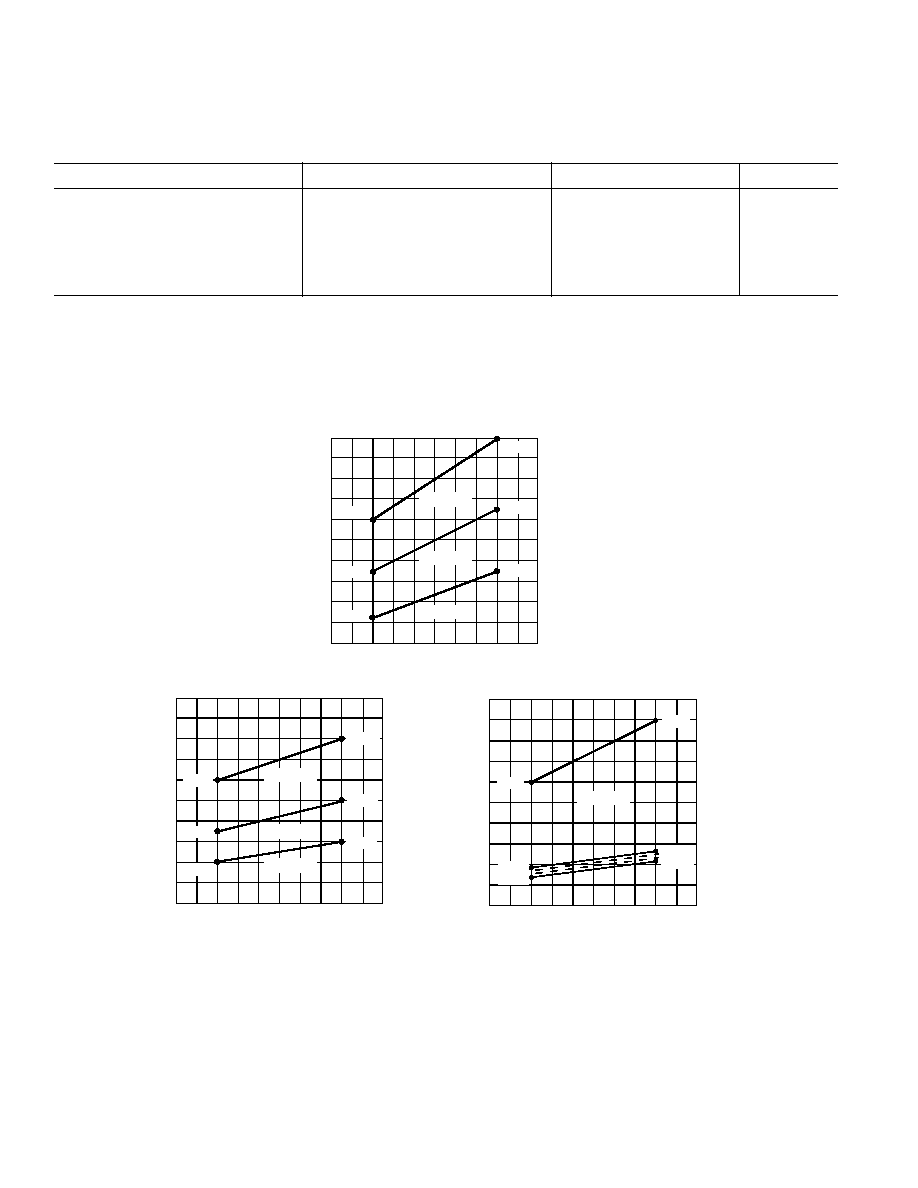
ADSP-21xx
≠22≠
REV. B
SUPPLY CURRENT & POWER (ADSP-2111)
Parameter
Test Conditions
Min
Max
Unit
I
DD
Supply Current (Dynamic)
1
@ V
DD
= max, t
CK
= 50 ns
2
60
mA
@ V
DD
= max, t
CK
= 60 ns
2
52
mA
@ V
DD
= max, t
CK
= 76.9 ns
2
46
mA
I
DD
Supply Current (Idle)
1, 3
@ V
DD
= max, t
CK
= 50 ns
18
mA
@ V
DD
= max, t
CK
= 60 ns
16
mA
@ V
DD
= max, t
CK
= 76.9 ns
14
mA
NOTES
1
Current reflects device operating with no output loads.
2
V
IN
= 0.4 V and 2.4 V.
3
Idle refers to ADSP-21xx state of operation during execution of IDLE instruction. Deasserted pins are driven to either V
DD
or GND.
For typical supply current (internal power dissipation) figures, see Figure 17.
SPECIFICATIONS (ADSP-2111)
Figure 17. ADSP-2111 Power (Typical) vs. Frequency
POWER (P
I
DLE
) ≠ mW
POWER, IDLE
1,2
50
30
40
80
60
70
90
100
20
18
17
16
15
14
19
100mW
70mW
50mW
1
/
t
CK
≠ MHz
40mW
55mW
80mW
POWER, IDLE
n MODES
3
40
30
35
55
45
50
60
65
70
IDLE;
32mW
34mW
IDLE 16;
IDLE 128;
70mW
55mW
20
18
17
16
15
14
19
36mW
38mW
POWER (P
IDLE
n
) ≠ mW
1
/
t
CK
≠ MHz
VALID FOR ALL TEMPERATURE GRADES.
1
POWER REFLECTS DEVICE OPERATING WITH NO OUTPUT LOADS.
2
IDLE REFERS TO ADSP-21xx OPERATION DURING EXECUTION OF IDLE INSTRUCTION.
DEASSERTED PINS ARE DRIVEN TO EITHER V
DD
OR GND.
3
MAXIMUM POWER DISSIPATION AT V
DD
= 5.0V DURING EXECUTION OF
IDLE
n
INSTRUCTION.
POWER (P
INT
) ≠ mW
20
18
17
16
15
14
19
1
/
t
CK
≠ MHz
330mW
260mW
200mW
250mW
200mW
155mW
POWER, INTERNAL
1
190
150
170
250
210
230
270
310
290
330
V
DD
=
5.5V
V
DD
=
5.0V
V
DD
=
4.5V
V
DD
=
5.5V
V
DD
=
5.0V
V
DD
=
4.5V
V
DD
=
5.0V

ADSP-21xx
REV. B
≠23≠
POWER DISSIPATION EXAMPLE
To determine total power dissipation in a specific application,
the following equation should be applied for each output:
C
◊
V
DD
2
◊
f
C = load capacitance, f = output switching frequency.
Example:
In an ADSP-2111 application where external data memory is
used and no other outputs are active, power dissipation is
calculated as follows:
Assumptions:
∑
External data memory is accessed every cycle with 50% of the
address pins switching.
∑
External data memory writes occur every other cycle with
50% of the data pins switching.
∑
Each address and data pin has a 10 pF total load at the pin.
∑
The application operates at V
DD
= 5.0 V and t
CK
= 50 ns.
Total Power Dissipation = P
INT
+ (C
◊
V
DD
2
◊
f )
P
INT
= internal power dissipation (from Figure 17).
(C
◊
V
DD
2
◊
f ) is calculated for each output:
# of
Output
Pins
◊
C
◊
V
DD
2
◊
f
Address, DMS 8
◊
10 pF
◊
5
2
V
◊
20 MHz = 40.0 mW
Data, WR
9
◊
10 pF
◊
5
2
V
◊
10 MHz = 22.5 mW
RD
1
◊
10 pF
◊
5
2
V
◊
10 MHz = 2.5 mW
CLKOUT
1
◊
10 pF
◊
5
2
V
◊
20 MHz = 5.0 mW
70.0 mW
Total power dissipation for this example = P
INT
+ 70.0 mW.
ENVIRONMENTAL CONDITIONS
Ambient Temperature Rating:
T
AMB
= T
CASE
≠ (PD
◊
CA
)
T
CASE
= Case Temperature in
∞
C
PD = Power Dissipation in W
CA
= Thermal Resistance (Case-to-Ambient)
JA
= Thermal Resistance (Junction-to-Ambient)
JC
= Thermal Resistance (Junction-to-Case)
Package
JA
JC
CA
PGA
35
∞
C/W
18
∞
C/W
17
∞
C/W
PQFP
42
∞
C/W
18
∞
C/W
23
∞
C/W
SPECIFICATIONS (ADSP-2111)
CAPACITIVE LOADING
Figures 18 and 19 show capacitive loading characteristics for the
ADSP-2111.
C
L
≠ pF
25
150
125
100
75
50
RISE TIME (0.8V - 2.0V) ≠ ns
14
2
6
4
8
10
12
V
DD
= 4.5V
Figure 18. Typical Output Rise Time vs. Load Capacitance, C
L
(at Maximum Ambient Operating Temperature)
C
L
≠ pF
25
100
125
50
75
150
VALID OUTPUT DELAY OR
HOLD ≠ ns
+10
≠2
≠6
≠4
+4
+2
+6
+8
+12
NOMINAL
V
DD
= 4.5V
Figure 19. Typical Output Valid Delay or Hold vs. Load
Capacitance, C
L
(at Maximum Ambient Operating Temperature)

ADSP-21xx
≠24≠
REV. B
SPECIFICATIONS (ADSP-2111)
The decay time, t
DECAY
, is dependent on the capacitative load,
C
L
, and the current load, i
L
, on the output pin. It can be
approximated by the following equation:
t
DECAY
=
C
L
◊
0.5 V
i
L
from which
t
DIS
= t
MEASURED
≠ t
DECAY
is calculated. If multiple pins (such as the data bus) are dis-
abled, the measurement value is that of the last pin to stop
driving.
Output Enable Time
Output pins are considered to be enabled when they have made
a transition from a high-impedance state to when they start
driving. The output enable time (t
E NA
) is the interval from
when a reference signal reaches a high or low voltage level to
when the output has reached a specified high or low trip point,
as shown in Figure 21. If multiple pins (such as the data bus)
are enabled, the measurement value is that of the first pin to
start driving.
TEST CONDITIONS
Figure 20 shows voltage reference levels for ac measurements.
Figure 20. Voltage Reference Levels for AC Measurements
(Except Output Enable/Disable)
Output Disable Time
Output pins are considered to be disabled when they have
stopped driving and started a transition from the measured
output high or low voltage to a high impedance state. The
output disable time (t
DIS
) is the difference of t
MEASURED
and
t
DECAY
, as shown in Figure 21. The time t
MEASURED
is the
interval from when a reference signal reaches a high or low
voltage level to when the output voltages have changed by 0.5 V
from the measured output high or low voltage.
3.0V
1.5V
0.0V
2.0V
1.5V
0.8V
INPUT
OUTPUT
Figure 22. Equivalent Device Loading for AC Measurements
(Except Output Enable/Disable)
2.0V
1.0V
t
ENA
REFERENCE
SIGNAL
OUTPUT
t
DECAY
V
OH
(MEASURED)
OUTPUT STOPS
DRIVING
OUTPUT STARTS
DRIVING
t
DIS
t
MEASURED
V
OL
(MEASURED)
V
OH
(MEASURED) ≠ 0.5V
V
OL
(MEASURED) +0.5V
HIGH-IMPEDANCE STATE.
TEST CONDITIONS CAUSE
THIS VOLTAGE LEVEL TO BE
APPROXIMATELY 1.5V.
V
OH
(MEASURED)
V
OL
(MEASURED)
Figure 21. Output Enable/Disable
TO
OUTPUT
PIN
50pF
+1.5V
I
OH
I
OL

RECOMMENDED OPERATING CONDITIONS
K Grade
B Grade
Parameter
Min
Max
Min
Max
Unit
V
DD
Supply Voltage
3.00
3.60
3.00
3.60
V
T
AMB
Ambient Operating Temperature
0
+70
≠40
+85
∞
C
See "Environmental Conditions" for information on thermal specifications.
ELECTRICAL CHARACTERISTICS
Parameter
Test Conditions
Min
Max
Unit
V
IH
Hi-Level Input Voltage
1, 3
@ V
DD
= max
2.0
V
V
IL
Lo-Level Input Voltage
1, 3
@ V
DD
= min
0.4
V
V
OH
Hi-Level Output Voltage
2, 3, 6
@ V
DD
= min, I
OH
= ≠0.5 mA
6
2.4
V
V
OL
Lo-Level Output Voltage
2, 3, 6
@ V
DD
= min, I
OL
= 2 mA
6
0.4
V
I
IH
Hi-Level Input Current
1
@ V
DD
= max, V
IN
= V
DD
max
10
µ
A
I
IL
Lo-Level Input Current
1
@ V
DD
= max, V
IN
= 0 V
10
µ
A
I
OZH
Tristate Leakage Current
4
@ V
DD
= max, V
IN
= V
DD
max
5
10
µ
A
I
OZL
Tristate Leakage Current
4
@ V
DD
= max, V
IN
= 0 V
5
10
µ
A
C
I
Input Pin Capacitance
1, 7, 8
@ V
IN
= 2.5 V, f
IN
= 1.0 MHz, T
AMB
= 25
∞
C
8
pF
C
O
Output Pin Capacitance
4, 7, 8, 9
@ V
IN
= 2.5 V, f
IN
= 1.0 MHz, T
AMB
= 25
∞
C
8
pF
NOTES
1
Input-only pins: CLKIN, RESET, IRQ2, BR, MMAP, DR1, DR0.
2
Output pins: BG, PMS, DMS, BMS, RD, WR, A0≠A13, CLKOUT, DT1, DT0.
3
Bidirectional pins: D0≠D23, SCLK1, RFS1, TFS1, SCLK0, RFS0, TFS0.
4
Tristatable pins: A0≠A13, D0≠D23, PMS, DMS, BMS, RD, WR, DT1, SCLK1, RSF1, TFS1, DT0, SCLK0, RFS0, TFS0.
5
0 V on BR, CLKIN Active (to force tristate condition).
6
All ADSP-2103, ADSP-2162, and ADSP-2164 outputs are CMOS and will drive to V
DD
and GND with no dc loads.
7
Guaranteed but not tested.
8
Applies to PLCC and PQFP package types.
9
Output pin capacitance is the capacitive load for any three-stated output pin.
Specifications subject to change without notice.
ADSP-2103/2162/2164≠SPECIFICATIONS
ABSOLUTE MAXIMUM RATINGS*
Supply Voltage . . . . . . . . . . . . . . . . . . . . . . . . ≠0.3 V to +4.5 V
Input Voltage . . . . . . . . . . . . . . . . . . . . . ≠0.3 V to V
DD
+ 0.3 V
Output Voltage Swing . . . . . . . . . . . . . . ≠0.3 V to V
DD
+ 0.3 V
Operating Temperature Range (Ambient) . . . . ≠40∫C to +85∫C
Storage Temperature Range . . . . . . . . . . . . . ≠65∫C to +150∫C
Lead Temperature (5 sec) PLCC, PQFP . . . . . . . . . . . +280∫C
*Stresses greater than those listed above may cause permanent damage to the
device. These are stress ratings only, and functional operation of the device at these
or any other conditions greater than those indicated in the operational sections of
this specification is not implied. Exposure to absolute maximum rating conditions
for extended periods may affect device reliability.
ADSP-21xx
≠25≠
REV. B
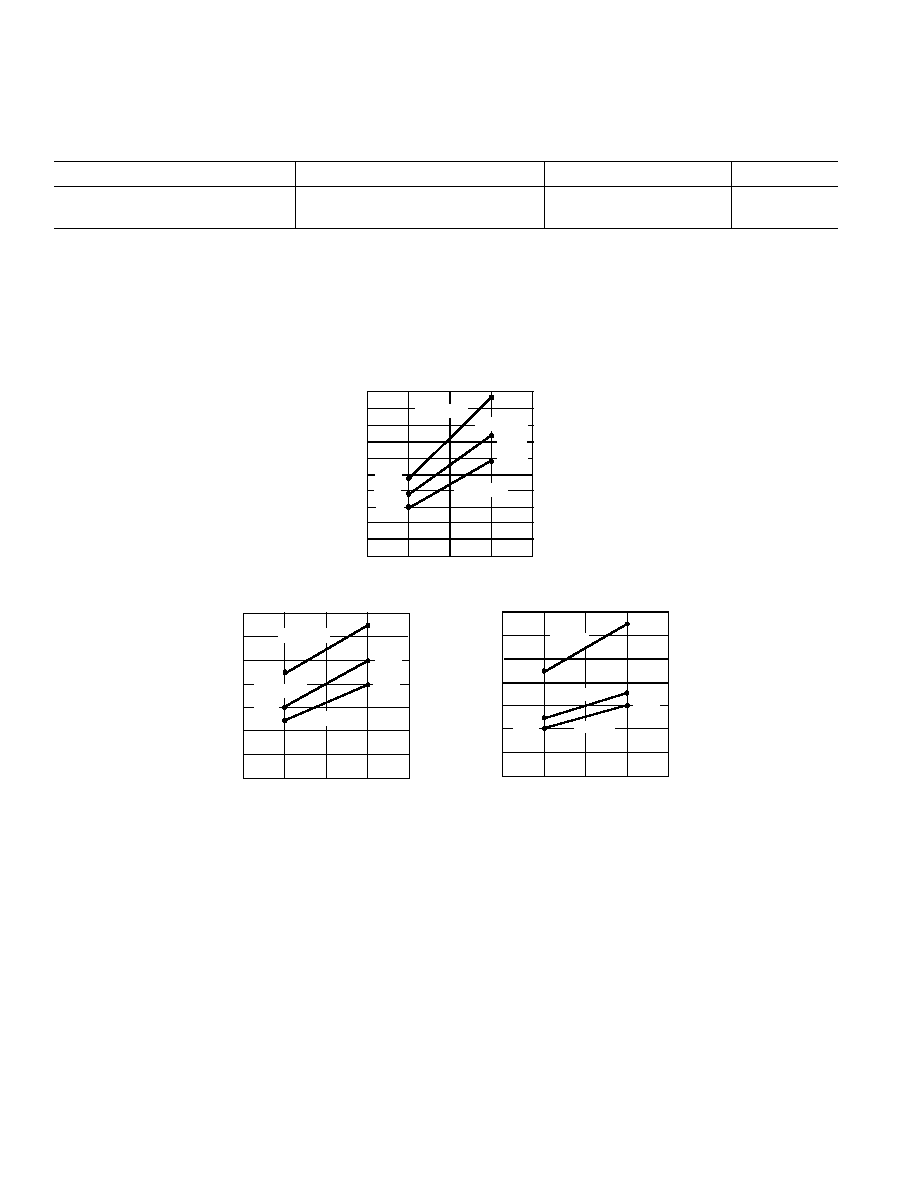
ADSP-21xx
≠26≠
REV. B
SPECIFICATIONS (ADSP-2103/2162/2164)
SUPPLY CURRENT & POWER (ADSP-2103/2162/2164)
Parameter
Test Conditions
Min
Max
Unit
I
DD
Supply Current (Dynamic)
1
@ V
DD
= max, t
CK
= 72.3 ns
2
14
mA
I
DD
Supply Current (Idle)
1, 3
@ V
DD
= max, t
CK
= 72.3 ns
4
mA
NOTES
1
Current reflects device operating with no output loads.
2
V
IN
= 0.4 V and 2.4 V.
3
Idle refers to ADSP-21xx state of operation during execution of IDLE instruction. Deasserted pins are driven to either V
DD
or GND.
For typical supply current (internal power dissipation) figures, see Figure 23.
VALID FOR ALL TEMPERATURE GRADES.
1
POWER REFLECTS DEVICE OPERATING WITH NO OUTPUT LOADS.
2
IDLE REFERS TO ADSP-21xx OPERATION DURING EXECUTION OF IDLE INSTRUCTION.
DEASSERTED PINS ARE DRIVEN TO EITHER V
DD
OR GND.
3
MAXIMUM POWER DISSIPATION AT V
DD
= 3.6V DURING EXECUTION OF
IDLE
n
INSTRUCTION.
4
0
2
10
6
8
12
14
15.00
13.83
10.00
7.00
5.00
POWER ≠ mW
IDD IDLE
FREQUENCY
≠ MHz
9mW
6mW
5mW
13mW
10mW
8mW
1
15
5
10
30
20
25
35
50
POWER ≠ mW
IDLE DYNAMIC
1,2
FREQUENCY
≠ MHz
48mW
37mW
29mW
15mW
15.00
13.83
10.00
7.00
5.00
45
40
0
24mW
19mW
4
0
2
10
6
8
12
14
15.00
13.83
10.00
7.00
5.00
POWER ≠ mW
FREQUENCY
≠ MHz
IDLE 128
IDLE 16
IDD IDLE
9mW
5mW
4mW
13mW
7mW
6mW
IDD IDLE n MODES
3
V
DD
=
3.6V
V
DD
=
3.30V
V
DD
=
3.0V
V
DD
=
3.6V
V
DD
=
3.30V
V
DD
=
3.0V
Figure 23. ADSP-2103 Power (Typical) vs. Frequency

ADSP-21xx
REV. B
≠27≠
POWER DISSIPATION EXAMPLE
To determine total power dissipation in a specific application,
the following equation should be applied for each output:
C
◊
V
DD
2
◊
f
C = load capacitance, f = output switching frequency.
Example:
In an ADSP-2103 application where external data memory is
used and no other outputs are active, power dissipation is
calculated as follows:
Assumptions:
∑
External data memory is accessed every cycle with 50% of the
address pins switching.
∑
External data memory writes occur every other cycle with
50% of the data pins switching.
∑
Each address and data pin has a 10 pF total load at the pin.
∑
The application operates at V
DD
= 3.3 V and t
CK
= 100 ns.
Total Power Dissipation = P
INT
+ (C
◊
V
DD
2
◊
f )
P
INT
= internal power dissipation (from Figure 23).
(C
◊
V
DD
2
◊
f ) is calculated for each output:
# of
Output
Pins
◊
C
◊
V
DD
2
◊
f
Address, DMS 8
◊
10 pF
◊
3.3
2
V
◊
10 MHz = 8.71 mW
Data, WR
9
◊
10 pF
◊
3.3
2
V
◊
5 MHz
= 4.90 mW
RD
1
◊
10 pF
◊
3.3
2
V
◊
5 MHz
= 0.55 mW
CLKOUT
1
◊
10 pF
◊
3.3
2
V
◊
10 MHz = 1.09 mW
15.25 mW
Total power dissipation for this example = P
INT
+ 15.25 mW.
ENVIRONMENTAL CONDITIONS
Ambient Temperature Rating:
T
AMB
= T
CASE
≠ (PD
◊
CA
)
T
CASE
= Case Temperature in
∞
C
PD = Power Dissipation in W
CA
= Thermal Resistance (Case-to-Ambient)
JA
= Thermal Resistance (Junction-to-Ambient)
JC
= Thermal Resistance (Junction-to-Case)
Package
JA
JC
CA
PGA
27
∞
C/W
16
∞
C/W
11
∞
C/W
PQFP
60
∞
C/W
18
∞
C/W
42
∞
C/W
SPECIFICATIONS (ADSP-2103/2162/2164)
Figure 25. Typical Output Valid Delay or Hold vs. Load
Capacitance, C
L
(at Maximum Ambient Operating Temperature)
Figure 24. Typical Output Rise Time vs. Load Capacitance, C
L
(at Maximum Ambient Operating Temperature)
CAPACITIVE LOADING
Figures 24 and 25 show capacitive loading characteristics for the
ADSP-2103, ADSP-2162, and ADSP-2164.
25
150
125
100
75
C
L
≠ pF
50
RISE TIME (0.8V-2.0V) ≠ ns
30
10
5
15
20
25
V
DD
= 3.0V
VALID OUTPUT DELAY OR HOLD ≠ ns
≠2
+4
+2
+6
NOMINAL
25
150
125
100
75
C
L
≠ pF
50
+8
V
DD
= 3.0V
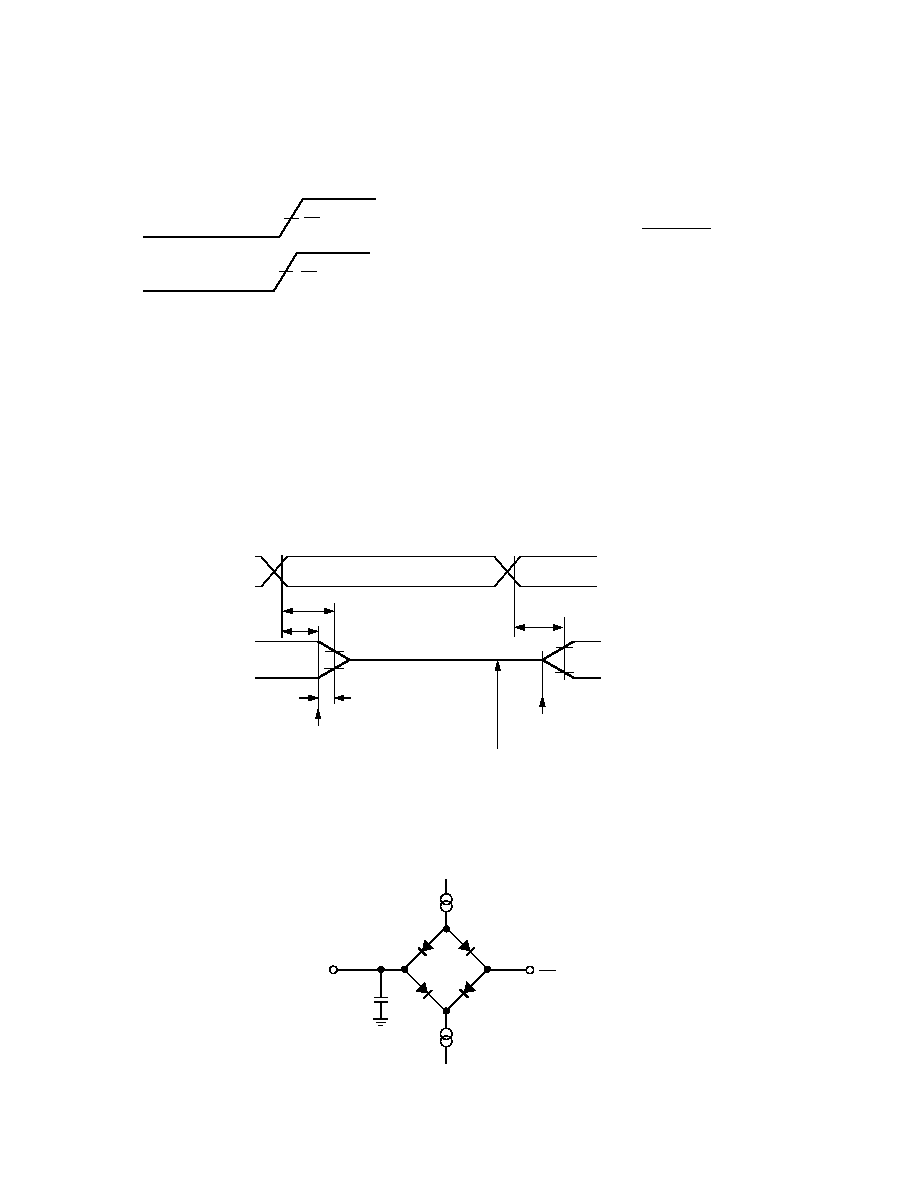
ADSP-21xx
≠28≠
REV. B
The decay time, t
DECAY
, is dependent on the capacitative load,
C
L
, and the current load, i
L
, on the output pin. It can be
approximated by the following equation:
t
DECAY
=
C
L
◊
0.5 V
i
L
from which
t
DIS
= t
MEASURED
≠ t
DECAY
is calculated. If multiple pins (such as the data bus) are dis-
abled, the measurement value is that of the last pin to stop
driving.
Output Enable Time
Output pins are considered to be enabled when they have made
a transition from a high-impedance state to when they start
driving. The output enable time (t
E NA
) is the interval from
when a reference signal reaches a high or low voltage level to
when the output has reached a specified high or low trip point,
as shown in Figure 27. If multiple pins (such as the data bus)
are enabled, the measurement value is that of the first pin to
start driving.
SPECIFICATIONS (ADSP-2103/2162/2164)
TEST CONDITIONS
Figure 26 shows voltage reference levels for ac measurements.
Figure 26. Voltage Reference Levels for AC Measurements
(Except Output Enable/Disable)
Output Disable Time
Output pins are considered to be disabled when they have
stopped driving and started a transition from the measured
output high or low voltage to a high impedance state. The
output disable time (t
DIS
) is the difference of t
MEASURED
and
t
DECAY
, as shown in Figure 27. The time t
MEASURED
is the
interval from when a reference signal reaches a high or low
voltage level to when the output voltages have changed by 0.5 V
from the measured output high or low voltage.
INPUT
OUTPUT
V
DD
2
V
DD
2
2.0V
1.0V
t
ENA
REFERENCE
SIGNAL
OUTPUT
t
DECAY
V
OH
(MEASURED)
OUTPUT STOPS
DRIVING
OUTPUT STARTS
DRIVING
t
DIS
t
MEASURED
V
OL
(MEASURED)
V
OH
(MEASURED) ≠ 0.5V
V
OL
(MEASURED) +0.5V
HIGH-IMPEDANCE STATE.
TEST CONDITIONS CAUSE
THIS VOLTAGE LEVEL TO BE
APPROXIMATELY 1.5V.
V
OH
(MEASURED)
V
OL
(MEASURED)
TO
OUTPUT
PIN
50pF
I
OH
I
OL
V
DD
2
Figure 27. Output Enable/Disable
Figure 28. Equivalent Device Loading for AC Measurements
(Except Output Enable/Disable)

ADSP-21xx
REV. B
≠29≠
GENERAL NOTES
Use the exact timing information given. Do not attempt to
derive parameters from the addition or subtraction of others.
While addition or subtraction would yield meaningful results for
an individual device, the values given in this data sheet reflect
statistical variations and worst cases. Consequently, you cannot
meaningfully add parameters to derive longer times.
TIMING NOTES
Switching characteristics specify how the processor changes its
signals. You have no control over this timing--circuitry external
to the processor must be designed for compatibility with these
signal characteristics. Switching characteristics tell you what the
processor will do in a given circumstance. You can also use
TIMING PARAMETERS (ADSP-2101/2105/2111/2115/2161/2163)
switching characteristics to ensure that any timing requirement
of a device connected to the processor (such as memory) is
satisfied.
Timing requirements apply to signals that are controlled by
circuitry external to the processor, such as the data input for a
read operation. Timing requirements guarantee that the
processor operates correctly with other devices.
MEMORY REQUIREMENTS
The table below shows common memory device specifications
and the corresponding ADSP-21xx timing parameters, for your
convenience.
Memory
ADSP-21xx
Timing
Device
Timing
Parameter
Specification
Parameter
Definition
Address Setup to Write Start
t
ASW
A0≠A13, DMS, PMS Setup before WR Low
Address Setup to Write End
t
AW
A0≠A13, DMS, PMS Setup before WR Deasserted
Address Hold Time
t
WRA
A0≠A13, DMS, PMS Hold after WR Deasserted
Data Setup Time
t
DW
Data Setup before WR High
Data Hold Time
t
DH
Data Hold after WR High
OE to Data Valid
t
RDD
RD Low to Data Valid
Address Access Time
t
AA
A0≠A13, DMS, PMS, BMS to Data Valid
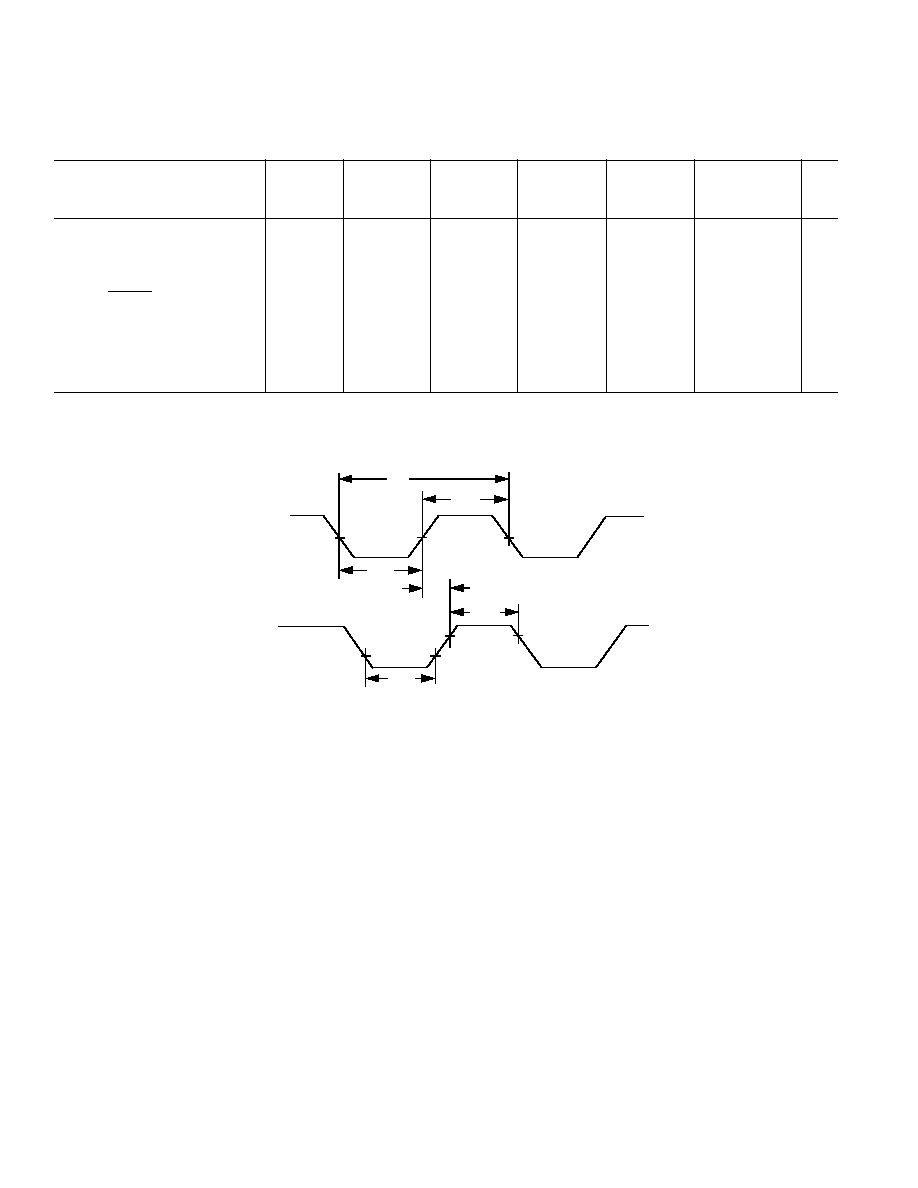
ADSP-21xx
≠30≠
REV. B
TIMING PARAMETERS (ADSP-2101/2105/2111/2115/2161/2163)
CLOCK SIGNALS & RESET
Frequency
13 MHz
13.824 MHz
16.67 MHz
20 MHz
25 MHz
Dependency
Parameter
Min
Max
Min
Max
Min
Max
Min
Max
Min
Max
Min
Max
Unit
Timing Requirement:
t
CK
CLKIN Period
76.9
150
72.3
150
60
150
50
150
40
150
ns
t
CKL
CLKIN Width Low
20
20
20
20
15
20
ns
t
CKH
CLKIN Width High
20
20
20
20
15
20
ns
t
RSP
RESET
Width Low
384.5
361.5
300
250
200
5t
CK
1
ns
Switching Characteristic:
t
CPL
CLKOUT Width Low
28.5
26.2
20
15
10
0.5t
CK
≠ 10
ns
t
CPH
CLKOUT Width High
28.5
26.2
20
15
10
0.5t
CK
≠ 10
ns
t
CKOH
CLKIN High to CLKOUT 0
20
0
20
0
20
0
20
0
15
ns
High
NOTES
1
Applies after powerup sequence is complete. Internal phase lock loop requires no more than 2000 CLKIN cycles, assuming stable CLKIN (not including crystal
oscillator startup time).
Figure 29. Clock Signals
CLKIN
CLKOUT
t
CKH
t
CK
t
CKL
t
CKOH
t
CPH
t
CPL
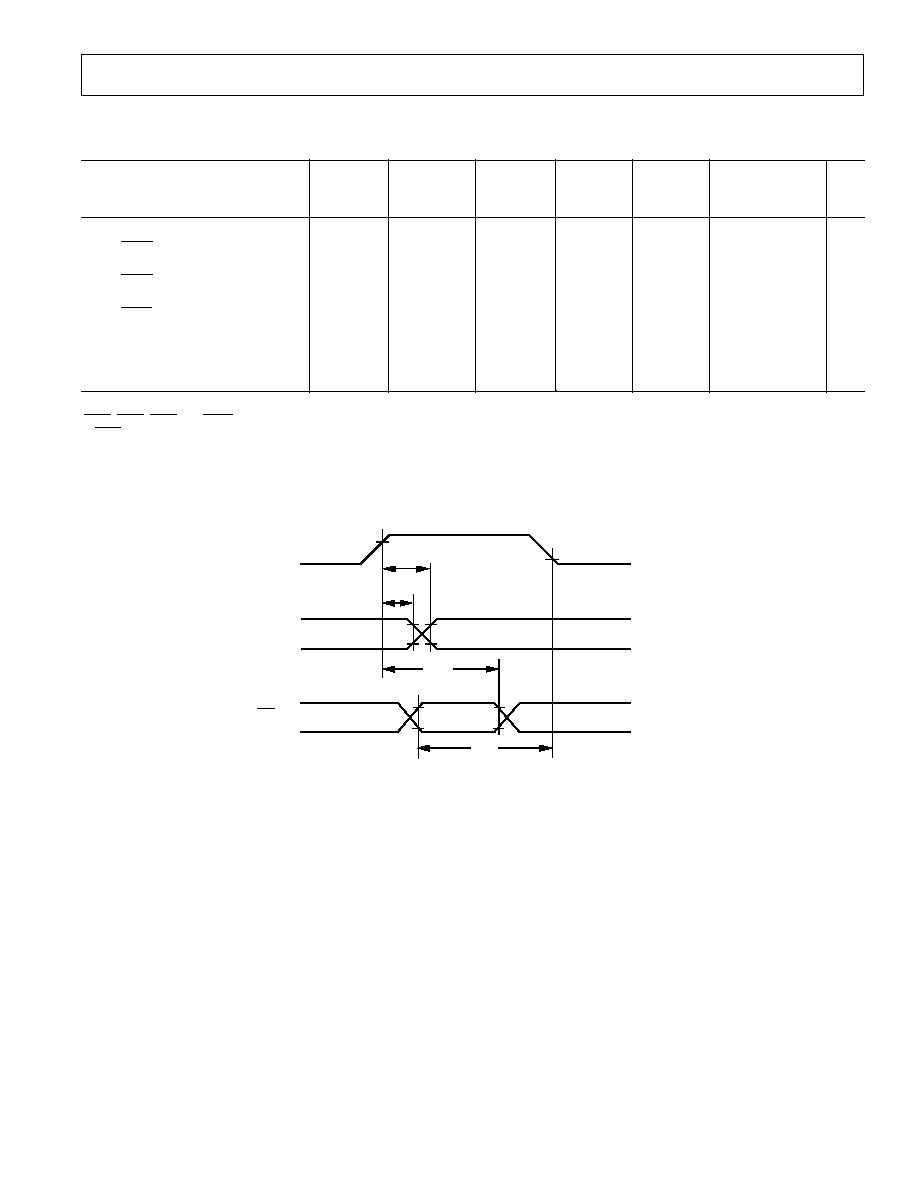
ADSP-21xx
REV. B
≠31≠
TIMING PARAMETERS (ADSP-2101/2105/2111/2115/2161/2163)
Frequency
13 MHz
13.824 MHz
16.67 MHz
20 MHz
25 MHz
Dependency
Parameter
Min
Max
Min
Max
Min Max
Min Max
Min Max
Min
Max
Unit
Timing Requirement:
t
IFS
IRQx
1
or FI Setup before
34.2
33.1
30
27.5
25
0.25t
CK
+ 15
4
ns
CLKOUT Low
2, 3
t
IFS
IRQx
1
or FI Setup before
37.2
36.1
33
30.5
28
0.25t
CK
+ 18
4
ns
CLKOUT Low (ADSP-2111)
2, 3
t
IFH
IRQx
1
or FI Hold after CLKOUT 19.2
18.1
15
12.5
10
0.25t
CK
ns
High
2, 3
Switching Characteristic:
t
FOH
FO Hold after CLKOUT High
5
0
0
0
0
0
0
ns
t
FOD
FO Delay from CLKOUT High
15
15
15
15
12
ns
NOTES
1
IRQx=IRQ0, IRQ1, and IRQ2.
2
If IRQx and FI inputs meet t
IFS
and t
IFH
setup/hold requirements, they will be recognized during the current clock cycle; otherwise they will be recognized
during the following cycle. (Refer to the "Interrupt Controller" section in Chapter 3, Program Control, of the
ADSP-2100 Family User's Manual for further
information on interrupt servicing.)
3
Edge-sensitive interrupts require pulse widths greater than 10 ns. Level-sensitive interrupts must be held low until serviced.
4
t
IFS
(min) = 0.25t
CK
+ 20 ns for ADSP-2101TG-50, ADSP-2101TG/883B-50, ADSP-2111TG-52, and ADSP-2111TG/883B-52 ( Extended Temperature Range
devices).
5
t
FOH
(min) = ≠5 ns for ADSP-2111TG-52 and ADSP-2111TG/883B-52 (Extended Temperature Range devices).
INTERRUPTS & FLAGS
Figure 30. Interrupts & Flags
CLKOUT
FLAG
OUTPUT(S)
t
FOD
IRQ
x
FI
t
FOH
t
IFH
t
IFS
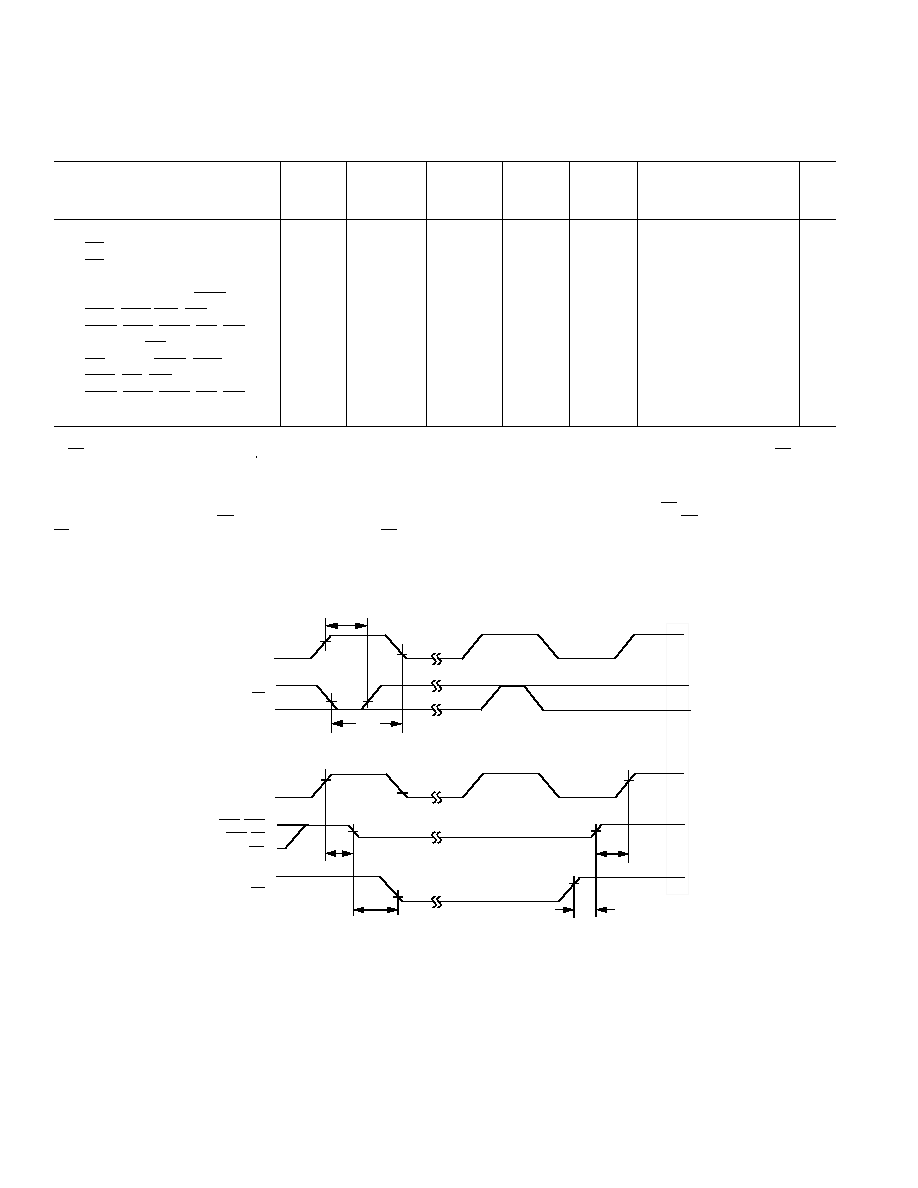
ADSP-21xx
≠32≠
REV. B
Frequency
13 MHz
13.824 MHz 16.67 MHz
20 MHz
25 MHz
Dependency
Parameter
Min Max Min Max
Min Max
Min Max Min Max Min
Max
Unit
Timing Requirement:
t
BH
BR Hold after CLKOUT High
1
24.2
23.1
20
17.5
15
0.25t
CK
+ 5
ns
t
BS
BR Setup before CLKOUT Low
1
39.2
38.1
35
32.5
30
0.25t
CK
+ 20
ns
Switching Characteristic:
t
SD
CLKOUT High to DMS,
39.2
38.1
35
32.5
30
0.25t
CK
+ 20 ns
PMS, BMS, RD, WR Disable
t
SDB
DMS, PMS, BMS, RD, WR
0
0
0
0
0
0
ns
Disable to BG Low
t
SE
BG High to DMS, PMS,
0
0
0
0
0
0
ns
BMS, RD, WR Enable
t
SEC
DMS, PMS, BMS, RD, WR
9.2
8.1
5
2.5
1.5
2
0.25t
CK
≠ 10
2
ns
Enable to CLKOUT High
NOTES
1
If BR meets the t
BS
and t
BH
setup/hold requirements, it will be recognized in the current processor cycle; otherwise it is recognized in the following cycle. BR requires
a pulse width greater than 10 ns.
2
For 25 MHz only the minimum frequency dependency formula for t
SEC
= (0.25t
CK
≠ 8.5).
Section 10.2.4, "Bus Request/Grant," on page 212 of the
ADSP-2100 Family User's Manual (1st Edition, 1993) states that "When BR is recognized, the processor
responds immediately by asserting BG during the same cycle." This is incorrect for the current versions of all ADSP-21xx processors: BG is asserted in the cycle after
BR is recognized. No external synchronization circuit is needed when BR is generated as an asynchronous signal.
TIMING PARAMETERS (ADSP-2101/2105/2111/2115/2161/2163)
BUS REQUEST/GRANT
CLKOUT
PMS
,
DMS
BMS
,
RD
WR
t
BS
BR
BG
CLKOUT
t
SD
t
SDB
t
SE
t
SEC
t
BH
Figure 31. Bus Request/Grant
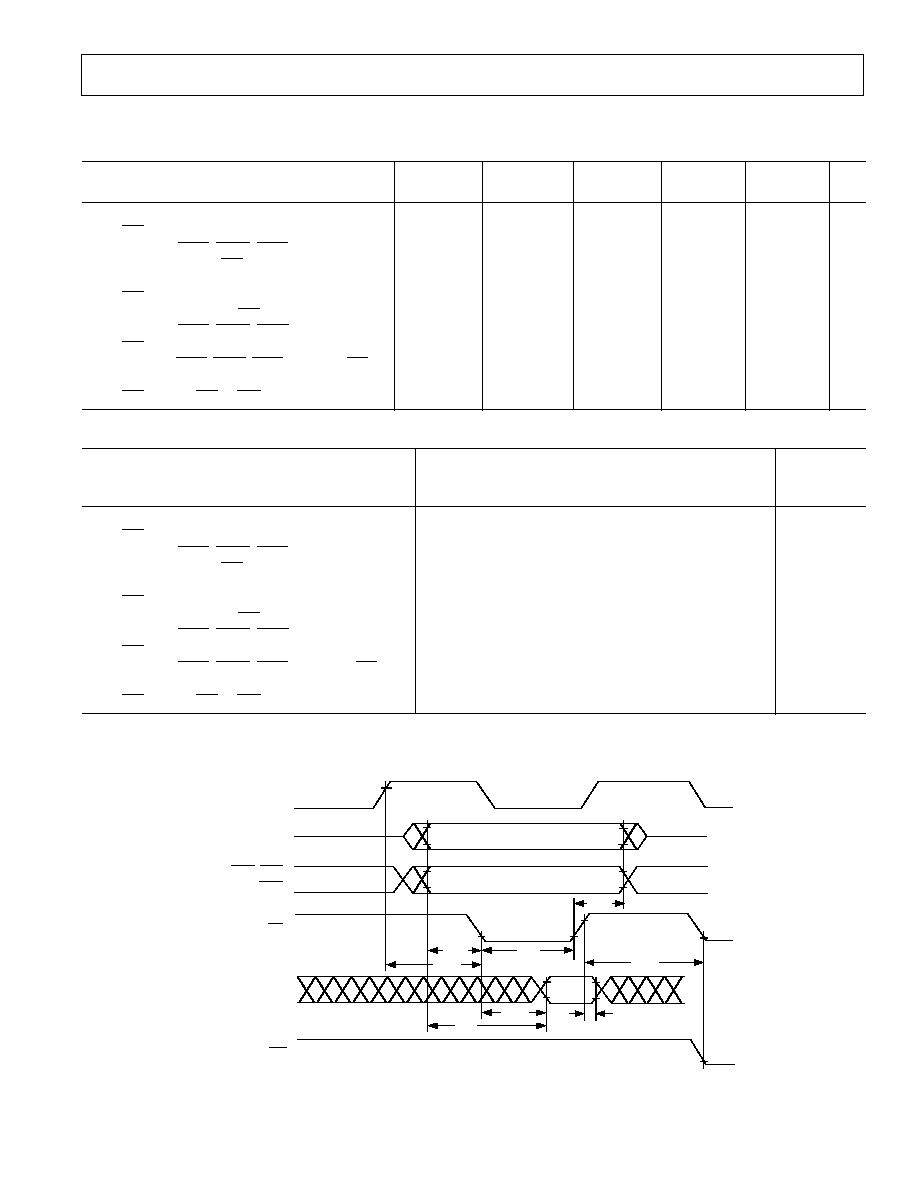
ADSP-21xx
REV. B
≠33≠
Frequency Dependency
(CLKIN
25 MHz)
Parameter
Min
Max
Unit
Timing Requirement:
t
RDD
RD Low to Data Valid
0.5t
CK
≠ 13 + w
ns
t
AA
A0≠A13, PMS, DMS, BMS to Data Valid
0.75t
CK
≠ 18 + w
ns
t
RDH
Data Hold from RD High
0
Switching Characteristic:
t
RP
RD Pulse Width
0.5t
CK
≠ 8 + w
ns
t
CRD
CLKOUT High to RD Low
0.25t
CK
≠ 5
0.25t
CK
+ 10
ns
t
ASR
A0≠A13, PMS, DMS, BMS Setup before
RD Low
0.25t
CK
≠ 10
1
ns
t
RDA
A0≠A13, PMS, DMS, BMS Hold after RD
Deasserted
0.25t
CK
≠ 9
ns
t
RWR
RD High to RD or WR Low
0.5t
CK
≠ 5
ns
NOTES
1
For 25 MHz only minimum frequency dependency formula for t
ASR
= (0.25t
CK
≠ 8.5).
w = wait states
◊
t
CK.
TIMING PARAMETERS (ADSP-2101/2105/2111/2115/2161/2163)
MEMORY READ
Figure 32. Memory Read
CLKOUT
A0 ≠ A13
D
t
RDA
RD
WR
DMS, PMS
BMS
t
RWR
t
RP
t
ASR
t
CRD
t
RDD
t
AA
t
RDH
13 MHz
13.824 MHz
16.67 MHz
20 MHz
25 MHz
Parameter
Min
Max
Min
Max
Min
Max
Min
Max Min
Max Unit
Timing Requirement:
t
RDD
RD Low to Data Valid
23.5
23.2
17
12
7
ns
t
AA
A0≠A13, PMS, DMS, BMS to Data Valid
37.7
36.2
27
19.5
12
ns
t
RDH
Data Hold from RD High
0
0
0
0
0
ns
Switching Characteristic:
t
RP
RD Pulse Width
33.5
28.2
22
17
12
ns
t
CRD
CLKOUT High to RD Low
14.2
29.2
13.1
28.1
10
25
7.5
22.5
5
20
ns
t
ASR
A0≠A13, PMS, DMS, BMS Setup before
9.2
8.1
5
2.5
1.5
1
ns
RD Low
t
RDA
A0≠A13, PMS, DMS, BMS Hold after RD
10.2
9.1
6
3.5
1
ns
Deasserted
t
RWR
RD High to RD or WR Low
33.5
31.2
25
20
15
ns
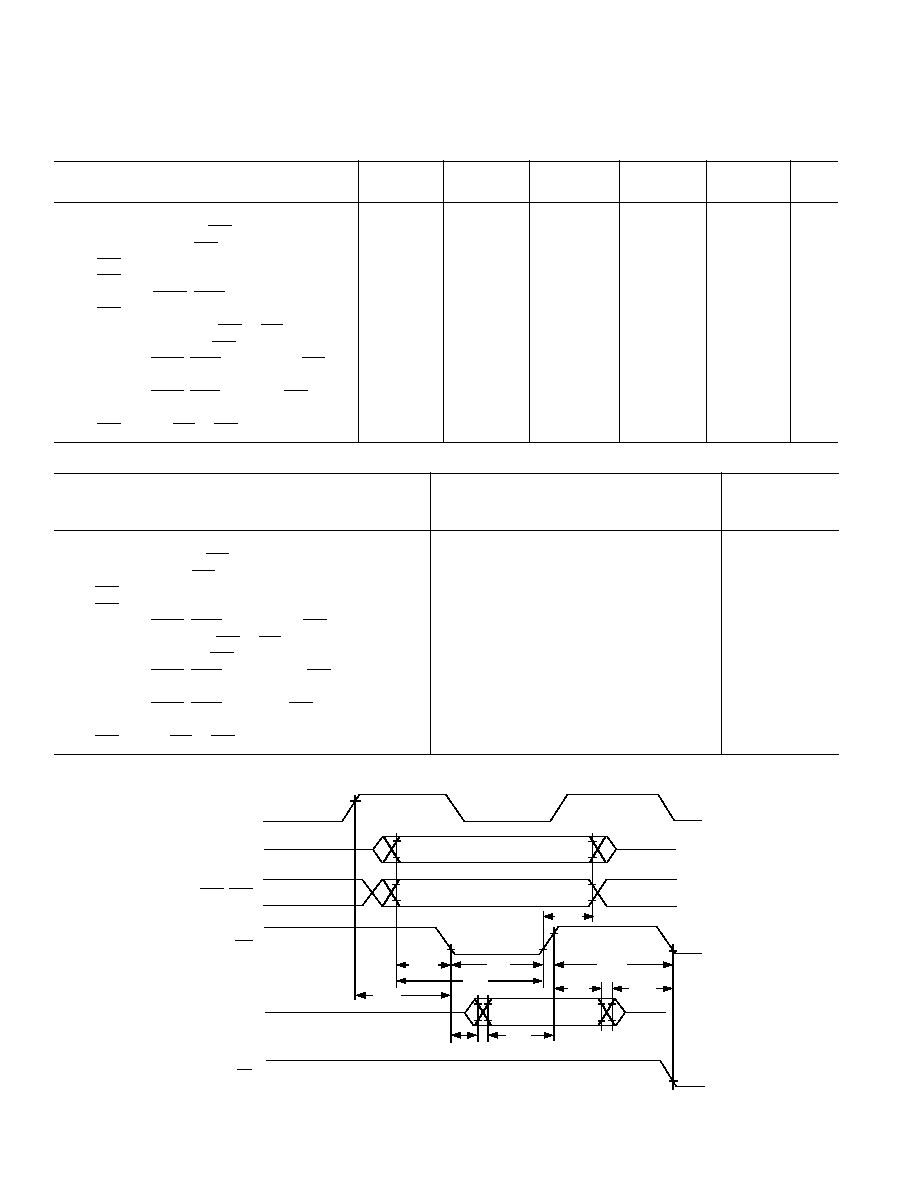
ADSP-21xx
≠34≠
REV. B
TIMING PARAMETERS (ADSP-2101/2105/2111/2115/2161/2163)
MEMORY WRITE
13 MHz
13.824 MHz 16.67 MHz
20 MHz
25 MHz
Parameter
Min
Max Min
Max
Min
Max
Min
Max
Min
Max Unit
Switching Characteristic:
t
DW
Data Setup before WR High
25.5
23.2
17
12
7
ns
t
DH
Data Hold after WR High
9.2
8.1
5
2.5
0
ns
t
WP
WR Pulse Width
30.5
28.2
22
17
12
ns
t
WDE
WR Low to Data Enabled
0
0
0
0
0
ns
t
ASW
A0≠A13, DMS, PMS Setup before
9.2
8.1
5
2.5
1.5
1
ns
WR Low
t
DDR
Data Disable before WR or RD Low
9.2
8.1
5
2.5
1.5
1
ns
t
CWR
CLKOUT High to WR Low
14.2
29.2
13.1
28.1
10
25
7.5
22.5
5
20
ns
t
AW
A0≠A13, DMS, PMS, Setup before WR
35.7
32.2
23
15.5
8
ns
Deasserted
t
WRA
A0≠A13, DMS, PMS Hold after WR
10.2
9.1
6
3.5
1
ns
Deasserted
t
WWR
WR High to RD or WR Low
33.5
31.2
25
20
15
ns
Figure 33. Memory Write
CLKOUT
A0 ≠ A13
D
t
WR A
WR
DMS, PMS
t
WWR
t
WP
t
AS W
t
AW
t
CWR
RD
t
DH
t
DD R
t
WDE
t
DW
Frequency Dependency
(CLKIN
25 MHz)
Parameter
Min
Max
Unit
Switching Characteristic:
t
DW
Data Setup before WR High
0.5t
CK
≠ 13 + w
ns
t
DH
Data Hold after WR High
0.25t
CK
≠ 10
ns
t
WP
WR Pulse Width
0.5t
CK
≠ 8 + w
ns
t
WDE
WR Low to Data Enabled
0
t
ASW
A0≠A13, DMS, PMS Setup before WR Low
0.25t
CK
≠ 10
1
ns
t
DDR
Data Disable before WR or RD Low
0.25t
CK
≠ 10
1
ns
t
CWR
CLKOUT High to WR Low
0.25t
CK
≠ 5
0.25t
CK
+ 10
ns
t
AW
A0≠A13, DMS, PMS, Setup before WR
Deasserted
0.75t
CK
≠ 22 + w
ns
t
WRA
A0≠A13, DMS, PMS Hold after WR
Deasserted
0.25t
CK
≠ 9
ns
t
WWR
WR High to RD or WR Low
0.5t
CK
≠ 5
ns
NOTES
1
For 25 MHz only the minimum frequency dependency formula for t
ASW
and t
DDR
= (0.25t
CK
≠ 8.5).
w = wait states
◊
t
CK
.
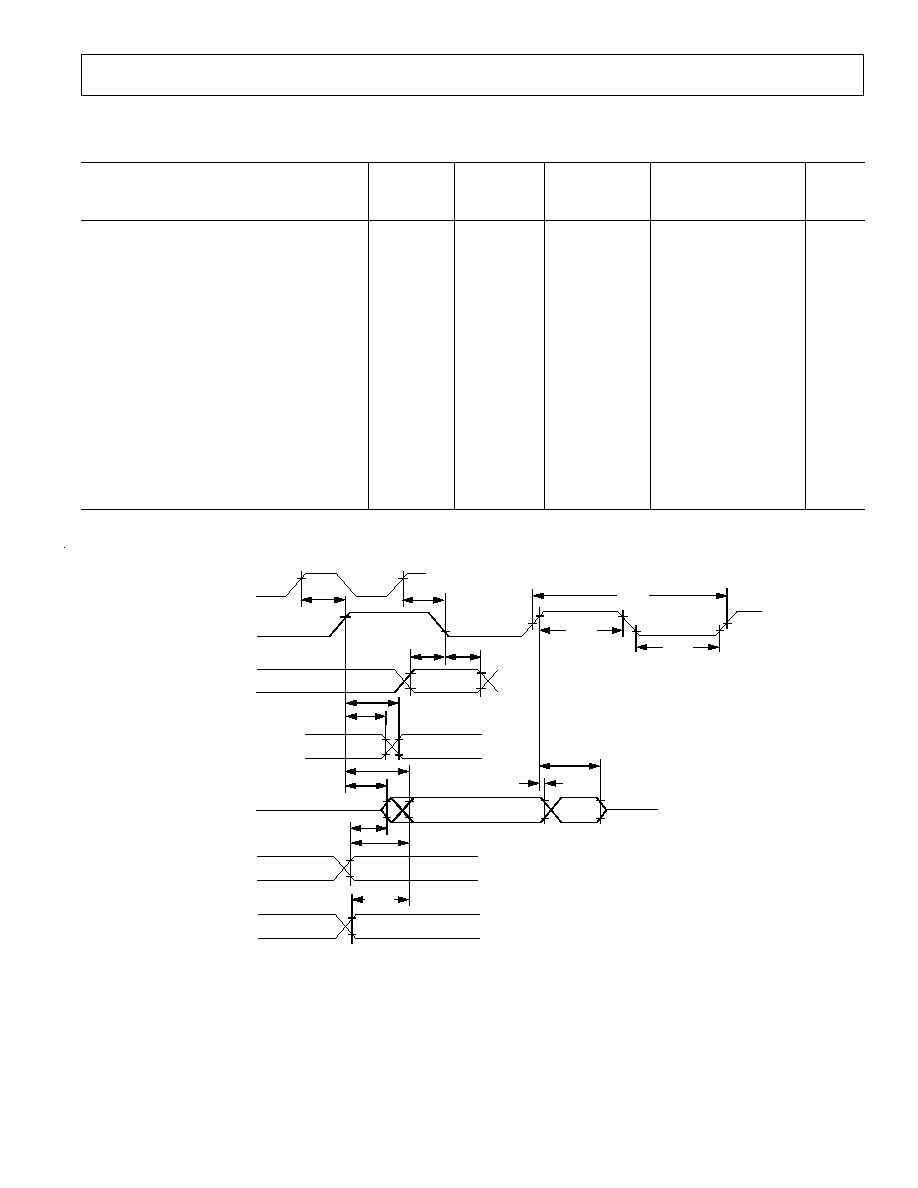
ADSP-21xx
REV. B
≠35≠
Frequency
12.5 MHz
13.0 MHz
13.824 MHz*
Dependency
Parameter
Min Max
Min Max
Min
Max
Min
Max
Unit
Timing Requirement:
t
SCK
SCLK Period
80
76.9
72.3
ns
t
SCS
DR/TFS/RFS Setup before SCLK Low
8
8
8
ns
t
SCH
DR/TFS/RFS Hold after SCLK Low
10
10
10
ns
t
SCP
SCLK
IN
Width
30
28
28
ns
Switching Characteristic:
t
CC
CLKOUT High to SCLK
OUT
20
35
19.2 34.2
18.1
33.1
0.25t
CK
0.25t
CK
+ 15ns
t
SCDE
SCLK High to DT Enable
0
0
0
ns
t
SCDV
SCLK High to DT Valid
20
20
20
ns
t
RH
TFS/RFS
OUT
Hold after SCLK High
0
0
0
ns
t
RD
TFS/RFS
OUT
Delay from SCLK High
20
20
20
ns
t
SCDH
DT Hold after SCLK High
0
0
0
ns
t
TDE
TFS (Alt) to DT Enable
0
0
0
ns
t
TDV
TFS (Alt) to DT Valid
18
18
18
ns
t
SCDD
SCLK High to DT Disable
25
25
25
ns
t
RDV
RFS
(Multichannel, Frame Delay Zero)
20
20
20
ns
to DT Valid
*Maximum serial port operating frequency is 13.824 MHz for all processor speed grades except the 12.5 MHz ADSP-2101 and 13.0 MHz ADSP-2111.
TIMING PARAMETERS (ADSP-2101/2105/2111/2115/2161/2163)
SERIAL PORTS
CLKOUT
SCLK
TFS
RFS
DR
RFS
IN
TFS
IN
DT
( ALTERNATE
FRAME MODE )
t
CC
t
CC
t
SCK
t
SCP
t
SCP
t
SCS
t
SCH
t
RD
t
RH
RFS
OUT
TFS
OUT
t
SCDV
t
SCDE
t
SCDH
t
SCDD
t
TDE
t
TDV
t
RDV
( MULTICHANNEL MODE,
FRAME DELAY 0 {MFD = 0} )
Figure 34. Serial Ports

ADSP-21xx
≠36≠
REV. B
TIMING PARAMETERS (ADSP-2111)
HOST INTERFACE PORT
Separate Data & Address (HMD1 = 0 )
Read Strobe & Write Strobe (HMD0 = 0)
13.0 MHz
16.67 MHz
20 MHz
No Frequency
Parameter
Min
Max
Min
Max
Min
Max
Dependency
Unit
Timing Requirement:
t
HSU
HA2-0 Setup before Start of Write or Read
1, 2
8
8
8
ns
t
HDSU
Data Setup before End of Write
3
8
8
8
ns
t
HWDH
Data Hold after End of Write
3
3
3
3
ns
t
HH
HA2-0 Hold after End of Write or Read
3, 4
3
3
3
ns
t
HRWP
Read or Write Pulse Width
5
30
30
30
ns
Switching Characteristic:
t
HSHK
HACK Low after Start of Write or Read
1, 2
0
20
0
20
0
20
ns
t
HKH
HACK Hold after End of Write or Read
3, 4
0
20
0
20
0
20
ns
t
HDE
Data Enabled after Start of Read
2
0
0
0
ns
t
HDD
Data Valid after Start of Read
2
23
23
23
ns
t
HRDH
Data Hold after End of Read
4
0
0
0
ns
t
HRDD
Data Disabled after End of Read
4
10
10
10
ns
NOTES
1
Start of Write = HWR Low and HSEL Low.
2
Start of Read = HRD Low and HSEL Low.
3
End of Write = HWR High or HSEL High.
4
End of Read = HRD High or HSEL High.
5
Read Pulse Width = HRD Low and HSEL Low, Write Pulse Width = HWR Low and HSEL Low.

ADSP-21xx
REV. B
≠37≠
Host Write Cycle
Host Read Cycle
Figure 35. Host Interface Port (HMD1 = 0, HMD0 = 0)
DATA
HD15≠0
HSEL
HWR
HACK
HA2≠0
ADDRESS
t
HSU
t
HH
t
HWDH
t
HRWP
t
HSHK
t
HKH
t
HDSU
DATA
HD15≠0
HSEL
HRD
HACK
HA2≠0
ADDRESS
t
HSU
t
HH
t
HRWP
t
HRDH
t
HKH
t
HSHK
t
HRDD
t
HDE
t
HDD

ADSP-21xx
≠38≠
REV. B
TIMING PARAMETERS (ADSP-2111)
HOST INTERFACE PORT
Separate Data & Address (HMD1 = 0)
Read/Write Strobe & Data Strobe (HMD0 = 1)
13.0 MHz
16.67 MHz
20 MHz
No Frequency
Parameter
Min
Max
Min
Max
Min
Max
Dependency
Unit
Timing Requirement:
t
HSU
HA2-0, HRW Setup before Start of Write or Read
1
8
8
8
ns
t
HDSU
Data Setup before End of Write
2
8
8
8
ns
t
HWDH
Data Hold after End of Write
2
3
3
3
ns
t
HH
HA2-0, HRW Hold after End of Write or Read
2
3
3
3
ns
t
HRWP
Read or Write Pulse Width
3
30
30
30
ns
Switching Characteristic:
t
HSHK
HACK Low after Start of Write or Read
1
0
20
0
20
0
20
ns
t
HKH
HACK Hold after End of Write or Read
2
0
20
0
20
0
20
ns
t
HDE
Data Enabled after Start of Read
1
0
0
0
ns
t
HDD
Data Valid after Start of Read
1
23
23
23
ns
t
HRDH
Data Hold after End of Read
2
0
0
0
ns
t
HRDD
Data Disabled after End of Read
2
10
10
10
ns
NOTES
1
Start of Write or Read = HDS Low and HSEL Low.
2
End of Write or Read = HDS High or HSEL High.
3
Read or Write Pulse Width = HDS Low and HSEL Low.
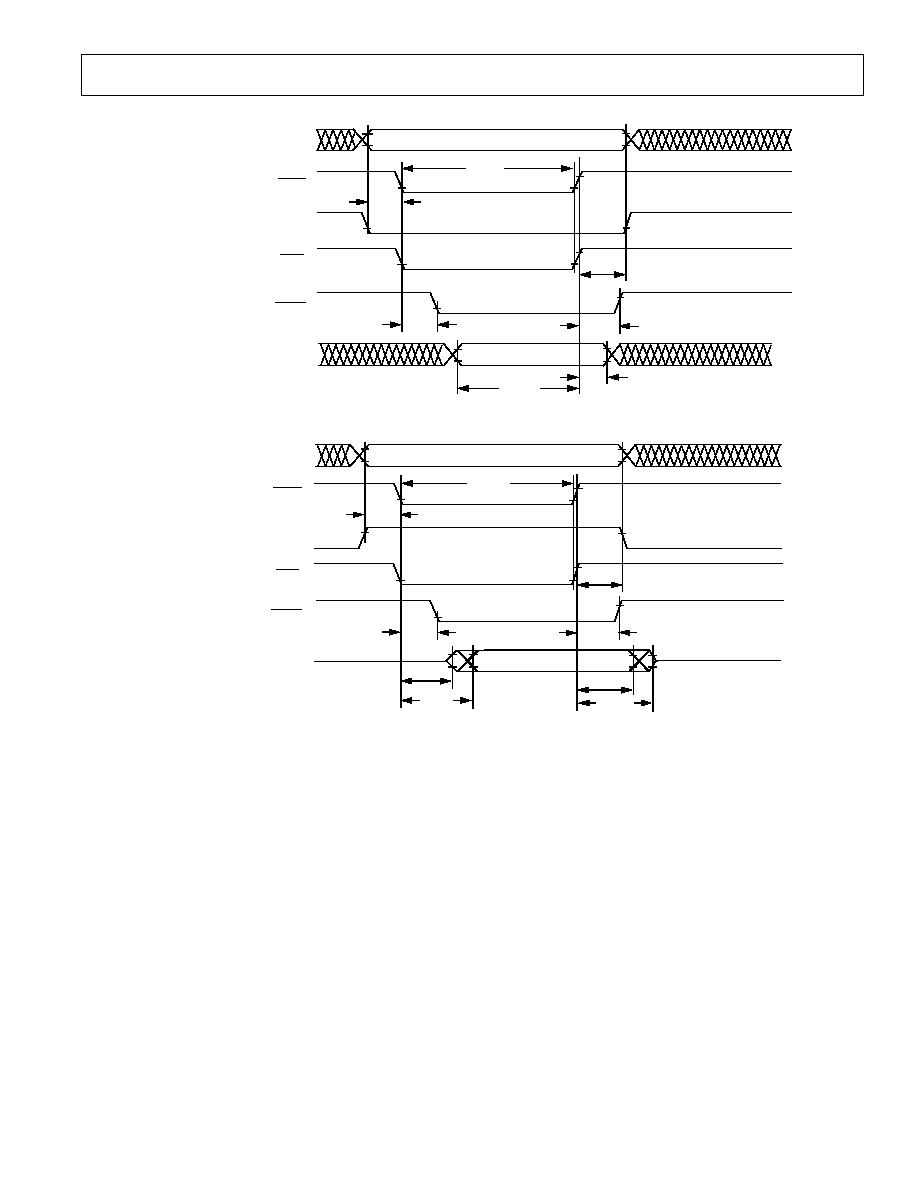
ADSP-21xx
REV. B
≠39≠
Figure 36. Host Interface Port (HMD1 = 0, HMD0 =1)
Host Write Cycle
Host Read Cycle
DATA
HD15≠0
HSEL
HRW
HACK
HA2≠0
ADDRESS
t
HSU
t
HH
t
HWDH
t
HRWP
t
HSHK
t
HKH
t
HDSU
HDS
DATA
HD15≠0
HSEL
HDS
HACK
HA2≠0
ADDRESS
t
HSU
t
HH
t
HRWP
t
HRDH
t
HKH
t
HSHK
t
HDE
t
HDD
HRW
t
HRDD

ADSP-21xx
≠40≠
REV. B
TIMING PARAMETERS (ADSP-2111)
HOST INTERFACE PORT
Multiplexed Data & Address (HMD1 = 1)
Read Strobe & Write Strobe (HMD0 = 0)
13.0 MHz
16.67 MHz
20 MHz
No Frequency
Parameter
Min
Max
Min
Max
Min
Max
Dependency
Unit
Timing Requirement:
t
HALP
ALE Pulse Width
15
15
15
ns
t
HASU
HAD15-0 Address Setup before ALE Low
5
5
5
ns
t
HAH
HAD15-0 Address Hold after ALE Low
2
2
2
ns
t
HALS
Start of Write or Read after ALE Low
1, 2
15
15
15
ns
t
HDSU
HAD15-0 Data Setup before End of Write
3
8
8
8
ns
t
HWDH
HAD15-0 Data Hold after End of Write
3
3
3
3
ns
t
HRWP
Read or Write Pulse Width
5
30
30
30
ns
Switching Characteristic:
t
HSHK
HACK Low after Start of Write or Read
1, 2
0
20
0
20
0
20
ns
t
HKH
HACK Hold after End of Write or Read
3, 4
0
20
0
20
0
20
ns
t
HDE
HAD15-0 Data Enabled after Start of Read
2
0
0
0
ns
t
HDD
HAD15-0 Data Valid after Start of Read
2
23
23
23
ns
t
HRDH
HAD15-0 Data Hold after End of Read
4
0
0
0
ns
t
HRDD
HAD15-0 Data Disabled after End of Read
4
10
10
10
ns
NOTES
1
Start of Write = HWR Low and HSEL Low.
2
Start of Read = HRD Low and HSEL Low.
3
End of Write = HWR High or HSEL High.
4
End of Read = HRD High or HSEL High.
5
Read Pulse Width = HRD Low and HSEL Low, Write Pulse Width = HWR Low and HSEL Low.
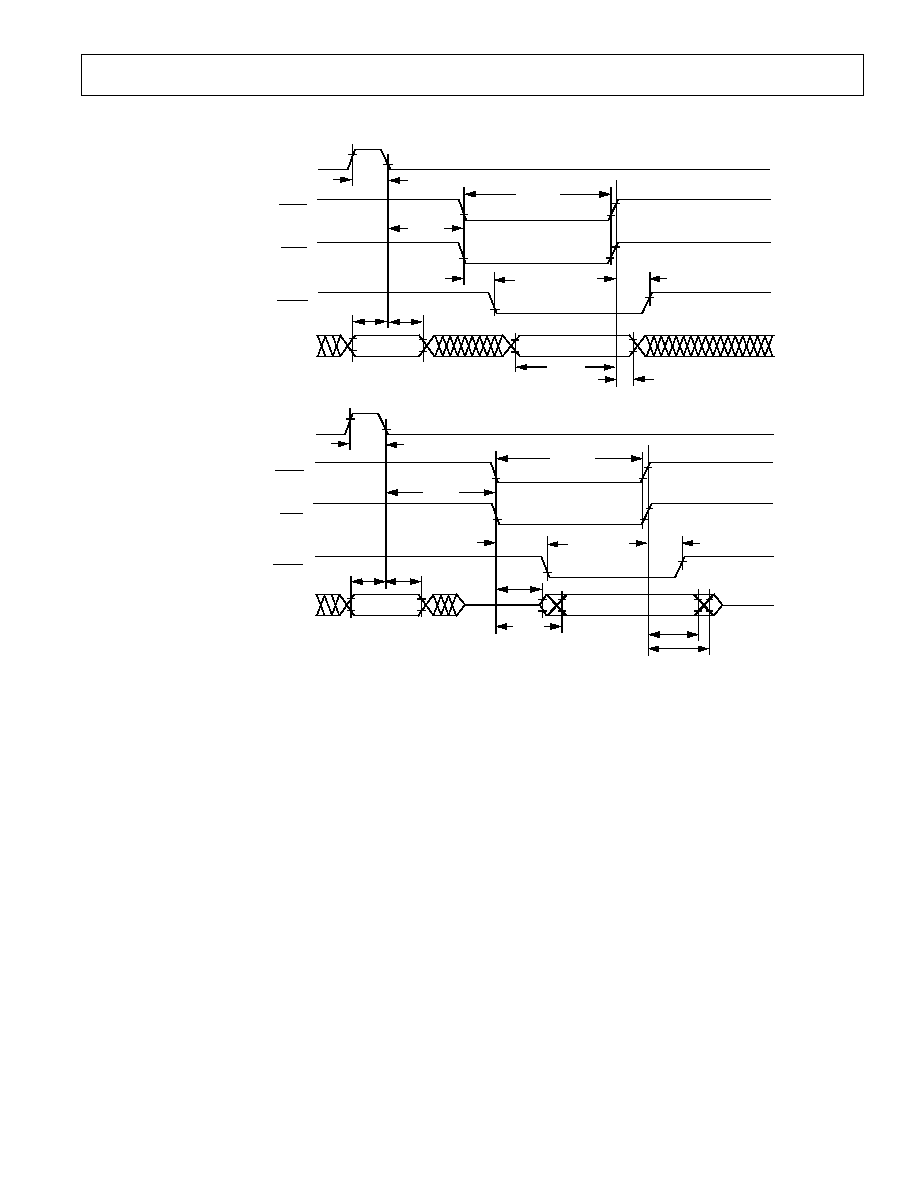
ADSP-21xx
REV. B
≠41≠
ADDRESS
t
HDSU
DATA
HACK
HWR
HSEL
HD15≠0
t
HRWP
t
HSHK
ALE
t
HALP
t
HALS
t
HKH
t
HAH
t
HASU
t
HWDH
t
HRDH
t
HRDD
t
HDE
ADDRESS
DATA
HACK
HRD
HSEL
HAD15≠0
t
HRWP
t
HSHK
ALE
t
HALP
t
HALS
t
HKH
t
HAH
t
HASU
t
HDD
Host Write Cycle
Figure 37. Host Interface Port (HMD1 = 1, HMD0 = 0)
Host Read Cycle

ADSP-21xx
≠42≠
REV. B
TIMING PARAMETERS (ADSP-2111)
HOST INTERFACE PORT
Multiplexed Data & Address (HMD1 = 1)
Read/Write Strobe & Data Strobe (HMD0 = 1 )
13.0 MHz
16.67 MHz
20 MHz
No Frequency
Parameter
Min
Max
Min
Max
Min
Max
Dependency
Unit
Timing Requirement:
t
HALP
ALE Pulse Width
15
15
15
ns
t
HASU
HAD15-0 Address Setup before ALE Low
5
5
5
ns
t
HAH
HAD15-0 Address Hold after ALE Low
2
2
2
ns
t
HALS
Start of Write or Read after ALE Low
1
15
15
15
ns
t
HSU
HRW Setup before Start of Write or Read
1
8
8
8
ns
t
HDSU
HAD15-0 Data Setup before End of Write
2
5
5
5
ns
t
HWDH
HAD15-0 Data Hold after End of Write
2
3
3
3
ns
t
HH
HRW Hold after End of Write or Read
2
3
3
3
ns
t
HRWP
Read or Write Pulse Width
3
30
30
30
ns
Switching Characteristic:
t
HSHK
HACK Low after Start of Write or Read
1
0
20
0
20
0
20
ns
t
HKH
HACK Hold after End of Write or Read
2
0
20
0
20
0
20
ns
t
HDE
HAD15-0 Data Enabled after Start of Read
1
0
0
0
ns
t
HDD
HAD15-0 Data Valid after Start of Read
1
23
23
23
ns
t
HRDH
HAD15-0 Data Hold after End of Read
2
0
0
0
ns
t
HRDD
HAD15-0 Data Disabled after End of Read
2
10
10
10
ns
NOTES
1
Start of Write or Read = HDS Low and HSEL Low.
2
End of Write or Read = HDS High or HSEL High.
3
Read or Write Pulse Width = HDS Low and HSEL Low.
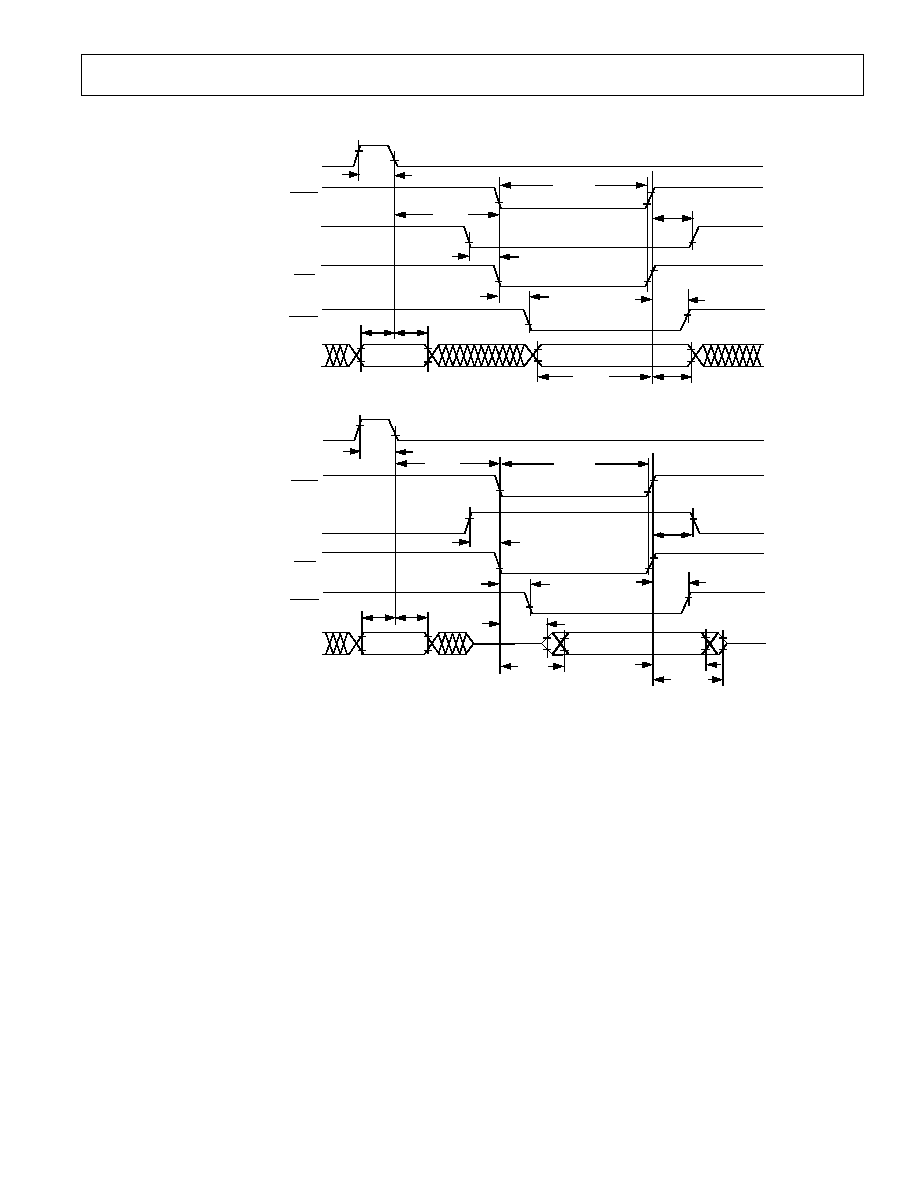
ADSP-21xx
REV. B
≠43≠
Host Write Cycle
Host Read Cycle
ADDRESS
t
HDSU
DATA
HACK
HRW
HSEL
HD15≠0
t
HRWP
t
HSHK
ALE
t
HALP
t
HALS
t
HKH
t
HAH
t
HASU
t
HWDH
HDS
t
HH
t
HSU
ADDRESS
DATA
HACK
HRW
HSEL
HD15≠0
t
HRWP
t
HSHK
ALE
t
HALP
t
HALS
t
HKH
t
HAH
t
HASU
t
HRDH
HDS
t
HH
t
HSU
t
HDE
t
HDD
t
HRDD
Figure 38. Host Interface Port (HMD1 = 1, HMD0 = 1)

ADSP-21xx
≠44≠
REV. B
TIMING PARAMETERS (ADSP-2103/2162/2164)
Timing requirements apply to signals that are controlled by
circuitry external to the processor, such as the data input for a
read operation. Timing requirements guarantee that the
processor operates correctly with other devices.
MEMORY REQUIREMENTS
The table below shows common memory device specifications
and the corresponding ADSP-21xx timing parameters, for your
convenience.
GENERAL NOTES
Use the exact timing information given. Do not attempt to
derive parameters from the addition or subtraction of others.
While addition or subtraction would yield meaningful results for
an individual device, the values given in this data sheet reflect
statistical variations and worst cases. Consequently, you cannot
meaningfully add parameters to derive longer times.
TIMING NOTES
Switching characteristics specify how the processor changes its
signals. You have no control over this timing--circuitry external
to the processor must be designed for compatibility with these
signal characteristics. Switching characteristics tell you what the
processor will do in a given circumstance. You can also use
switching characteristics to ensure that any timing requirement
of a device connected to the processor (such as memory) is
satisfied.
ADSP-21xx
Memory Specification
Timing Parameter
Timing Parameter Definition
Address Setup to Write Start
t
ASW
A0≠A13, DMS, PMS Setup before WR Low
Address Setup to Write End
t
AW
A0≠A13, DMS, PMS Setup before WR Deasserted
Address Hold Time
t
WRA
A0≠A13, DMS, PMS Hold after WR Deasserted
Data Setup Time
t
DW
Data Setup before WR High
Data Hold Time
t
DH
Data Hold after WR High
OE to Data Valid
t
RDD
RD Low to Data Valid
Address Access Time
t
AA
A0≠A13, DMS, PMS, BMS to Data Valid
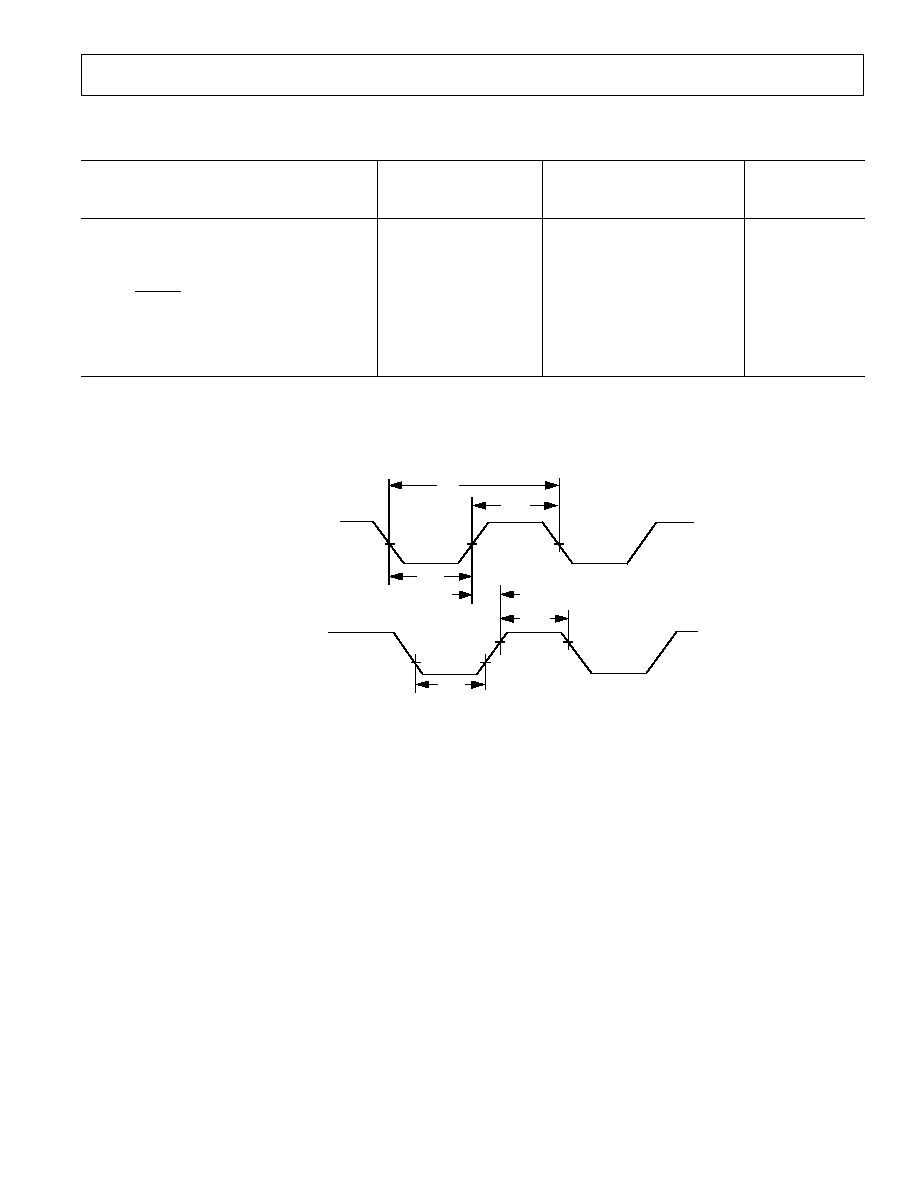
ADSP-21xx
REV. B
≠45≠
Frequency
10.24 MHz
Dependency
Parameter
Min
Max
Min
Max
Unit
Timing Requirement:
t
CK
CLKIN Period
97.6
150
ns
t
CKL
CLKIN Width Low
20
ns
t
CKH
CLKIN Width High
20
ns
t
RSP
RESET Width Low
488
5t
CK
1
ns
Switching Characteristic:
t
CPL
CLKOUT Width Low
38.8
0.5t
CK
≠ 10
ns
t
CPH
CLKOUT Width High
38.8
0.5t
CK
≠ 10
ns
t
CKOH
CLKIN High to CLKOUT High
0
20
ns
NOTES
1
Applies after powerup sequence is complete. Internal phase lock loop requires no more than 2000 CLKIN cycles assuming stable CLKIN (not including crystal
oscillator startup time).
TIMING PARAMETERS (ADSP-2103/2162/2164)
CLOCK SIGNALS & RESET
Figure 39. Clock Signals
CLKIN
CLKOUT
t
CKH
t
CK
t
CKL
t
CKOH
t
CPH
t
CPL
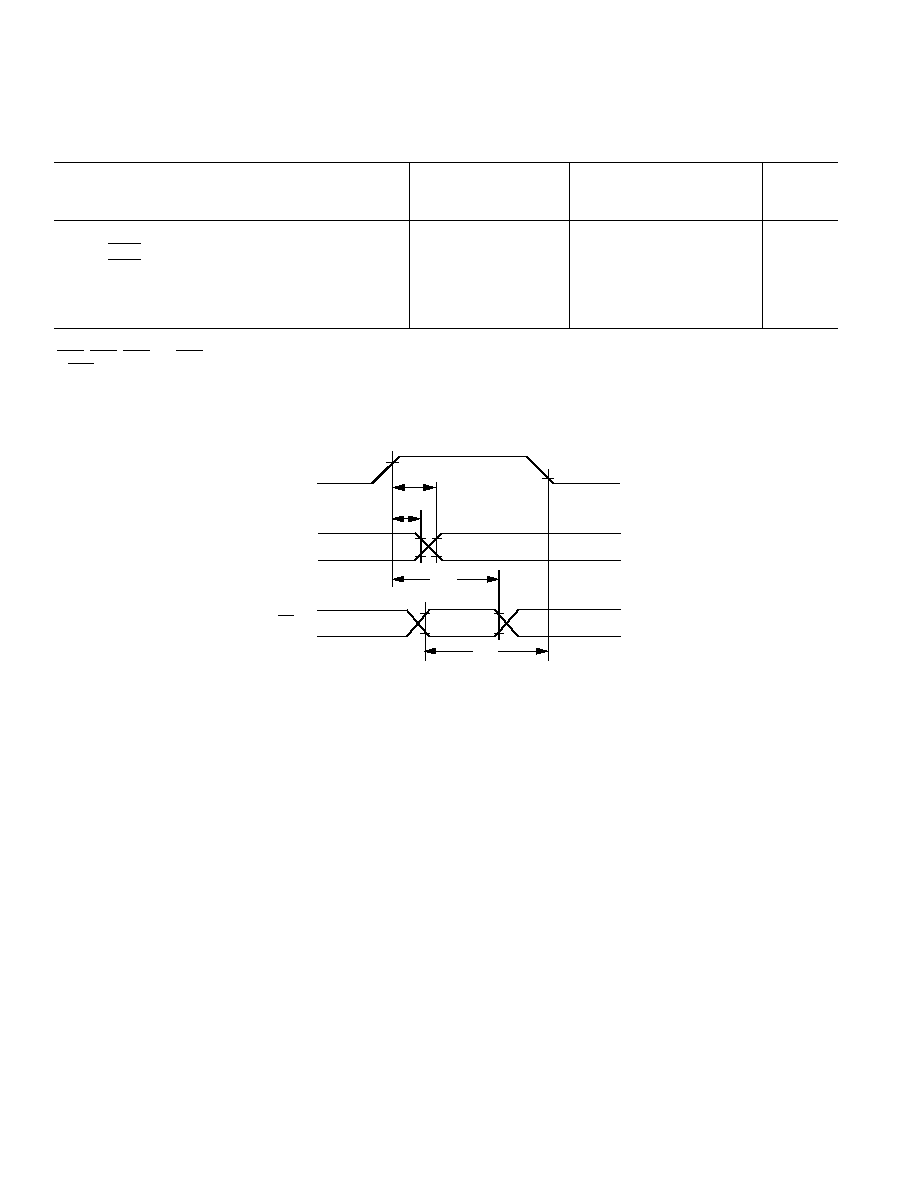
ADSP-21xx
≠46≠
REV. B
TIMING PARAMETERS (ADSP-2103/2162/2164)
INTERRUPTS & FLAGS
Frequency
10.24 MHz
Dependency
Parameter
Min
Max
Min
Max
Unit
Timing Requirement:
t
IFS
IRQx
1
or FI Setup before CLKOUT Low
2, 3
44.4
0.25t
CK
+ 20
ns
t
IFH
IRQx
1
or FI Hold after CLKOUT High
2, 3
24.4
0.25t
CK
ns
Switching Characteristic:
t
FOH
FO Hold after CLKOUT High
0
ns
t
FOD
FO Delay from CLKOUT High
15
ns
NOTES
1
IRQx=IRQ0, IRQ1, and IRQ2
.
2
If IRQx and FI inputs meet t
IFS
and t
IFH
setup/hold requirements, they will be recognized during the current clock cycle; otherwise they will be recognized during the
following cycle. (Refer to the "Interrupt Controller" section in Chapter 3, Program Control, of the
ADSP-2100 Family User's Manual for further information on
interrupt servicing.)
3
Edge-sensitive interrupts require pulse widths greater than 10 ns. Level-sensitive interrupts must be held low until serviced.
CLKOUT
FLAG
OUTPUT(S)
t
FOD
IRQ
x
FI
t
FOH
t
IFH
t
IFS
Figure 40. Interrupts & Flags
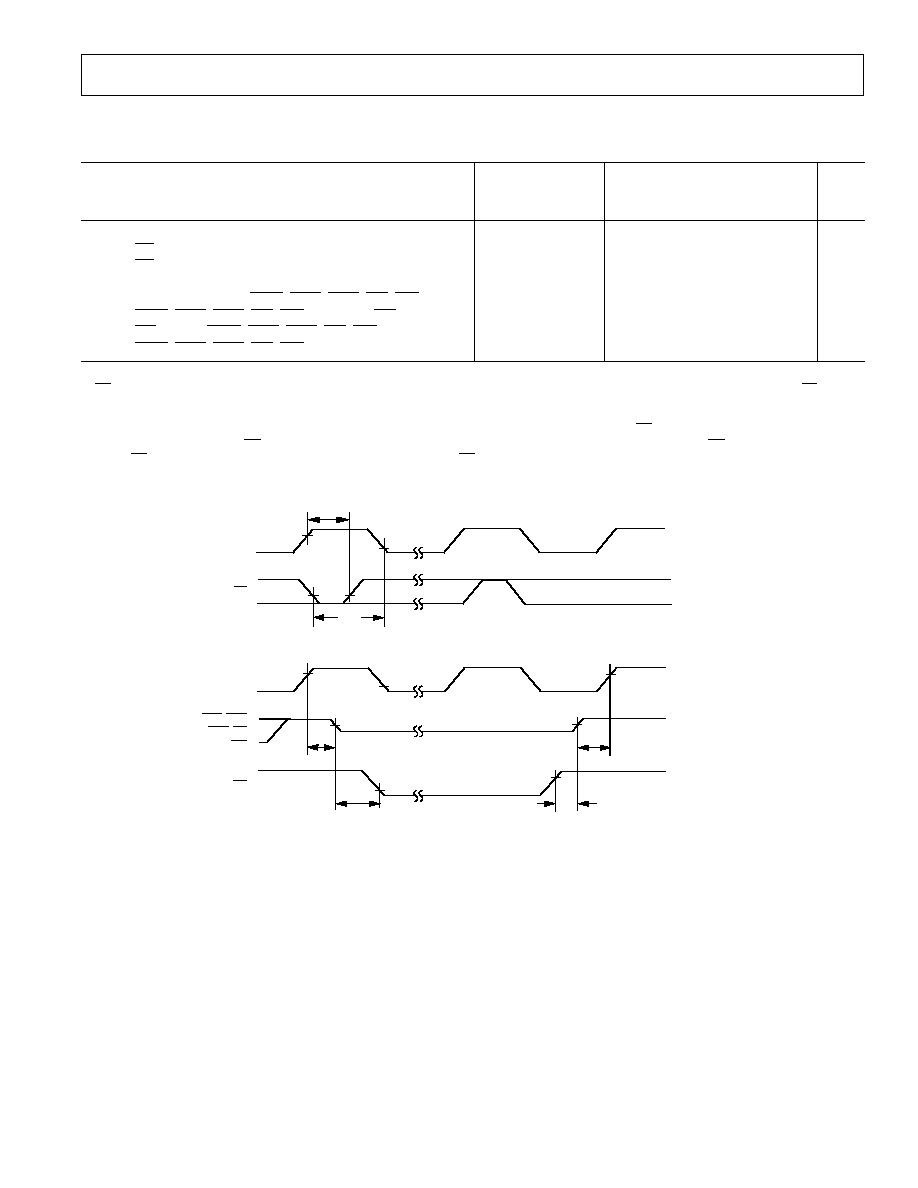
ADSP-21xx
REV. B
≠47≠
TIMING PARAMETERS (ADSP-2103/2162/2164)
BUS REQUEST/GRANT
Frequency
10.24 MHz
Dependency
Parameter
Min
Max
Min
Max
Unit
Timing Requirement:
t
BH
BR Hold after CLKOUT High
1
29.4
0.25t
CK
+ 5
ns
t
BS
BR Setup before CLKOUT Low
1
44.4
0.25t
CK
+ 20
ns
Switching Characteristic:
t
SD
CLKOUT High to DMS, PMS, BMS, RD, WR Disable
44.4
0.25t
CK
+ 20
ns
t
SDB
DMS, PMS, BMS, RD, WR Disable to BG Low
0
ns
t
SE
BG High to DMS, PMS, BMS, RD, WR Enable
0
ns
t
SEC
DMS, PMS, BMS, RD, WR Enable to CLKOUT High
14.4
0.25t
CK
≠ 10
ns
NOTES
1
If BR meets the t
BS
and t
BH
setup/hold requirements, it will be recognized in the current processor cycle; otherwise it is recognized in the following cycle. BR
requires a pulse width greater than 10 ns.
Section 10.2.4, "Bus Request/Grant," of the
ADSP-2100 Family User's Manual (1st Edition, ©1993) states that "When BR is recognized, the processor
responds immediately by asserting BG during the same cycle." This is incorrect for the current versions of all ADSP-21xx processors: BG is asserted in the
cycle after BR is recognized. No external synchronization circuit is needed when BR is generated as an asynchronous signal.
Figure 41. Bus Request/Grant
CLKOUT
PMS
,
DMS
BMS
,
RD
WR
t
BS
BR
BG
CLKOUT
t
SD
t
SDB
t
SE
t
SEC
t
BH
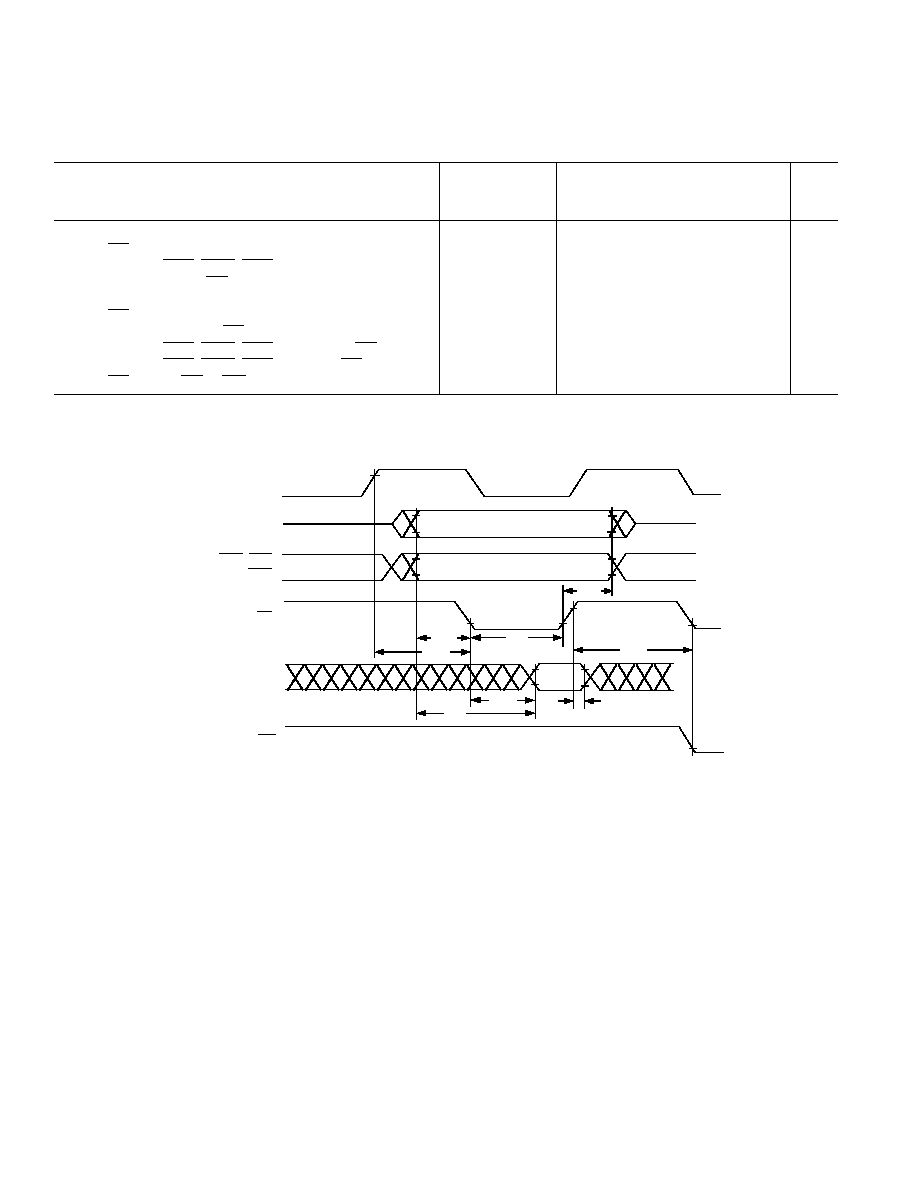
ADSP-21xx
≠48≠
REV. B
TIMING PARAMETERS (ADSP-2103/2162/2164)
MEMORY READ
Frequency
10.24 MHz
Dependency
Parameter
Min
Max
Min
Max
Unit
Timing Requirement:
t
RDD
RD Low to Data Valid
33.8
0.5t
CK
≠ 15 + w
ns
t
AA
A0≠A13, PMS, DMS, BMS to Data Valid
49.2
0.75t
CK
≠ 24 + w
ns
t
RDH
Data Hold from RD High
0
ns
Switching Characteristic:
t
RP
RD Pulse Width
43.8
0.5t
CK
≠ 5 + w
ns
t
CRD
CLKOUT High to RD Low
19.4
34.4
0.25t
CK
≠ 5
0.25t
CK
+ 10
ns
t
ASR
A0≠A13, PMS, DMS, BMS Setup before RD Low
12.4
0.25t
CK
≠ 12
ns
t
RDA
A0≠A13, PMS, DMS, BMS Hold after RD Deasserted
14.4
0.25t
CK
≠ 10
ns
t
RWR
RD High to RD or WR Low
38.8
0.5t
CK
≠ 10
ns
w = wait states
◊
t
CK.
Figure 42. Memory Read
CLKOUT
A0 ≠ A13
D
t
RDA
RD
WR
DMS, PMS
BMS
t
RWR
t
RP
t
ASR
t
CRD
t
RDD
t
AA
t
RDH

ADSP-21xx
REV. B
≠49≠
Frequency
10.24 MHz
Dependency
Parameter
Min
Max
Min
Max
Unit
Switching Characteristic:
t
DW
Data Setup before WR High
38.8
0.5t
CK
≠ 10 + w
ns
t
DH
Data Hold after WR High
14.4
0.25t
CK
≠ 10
ns
t
WP
WR Pulse Width
43.8
0.5t
CK
≠ 5 + w
ns
t
WDE
WR Low to Data Enabled
0
t
ASW
A0≠A13, DMS, PMS Setup before WR Low
12.4
0.25t
CK
≠ 12
ns
t
DDR
Data Disable before WR or RD Low
14.4
0.25t
CK
≠ 10
ns
t
CWR
CLKOUT High to WR Low
19.4
34.4
0.25t
CK
≠ 5
0.25t
CK
+ 10
ns
t
AW
A0≠A13, DMS, PMS, Setup before WR Deasserted
58.2
0.75t
CK
≠ 15 + w
ns
t
WRA
A0≠A13, DMS, PMS Hold After WR Deasserted
14.4
0.25t
CK
≠ 10
ns
t
WWR
WR High to RD or WR Low
38.8
0.5t
CK
≠ 10
ns
w = wait states
◊
t
CK.
TIMING PARAMETERS (ADSP-2103/2162/2164)
MEMORY WRITE
Figure 43. Memory Write
CLKOUT
A0 ≠ A13
D
t
WR A
WR
DMS, PMS
t
WWR
t
WP
t
AS W
t
AW
t
CWR
RD
t
DH
t
DD R
t
WDE
t
DW
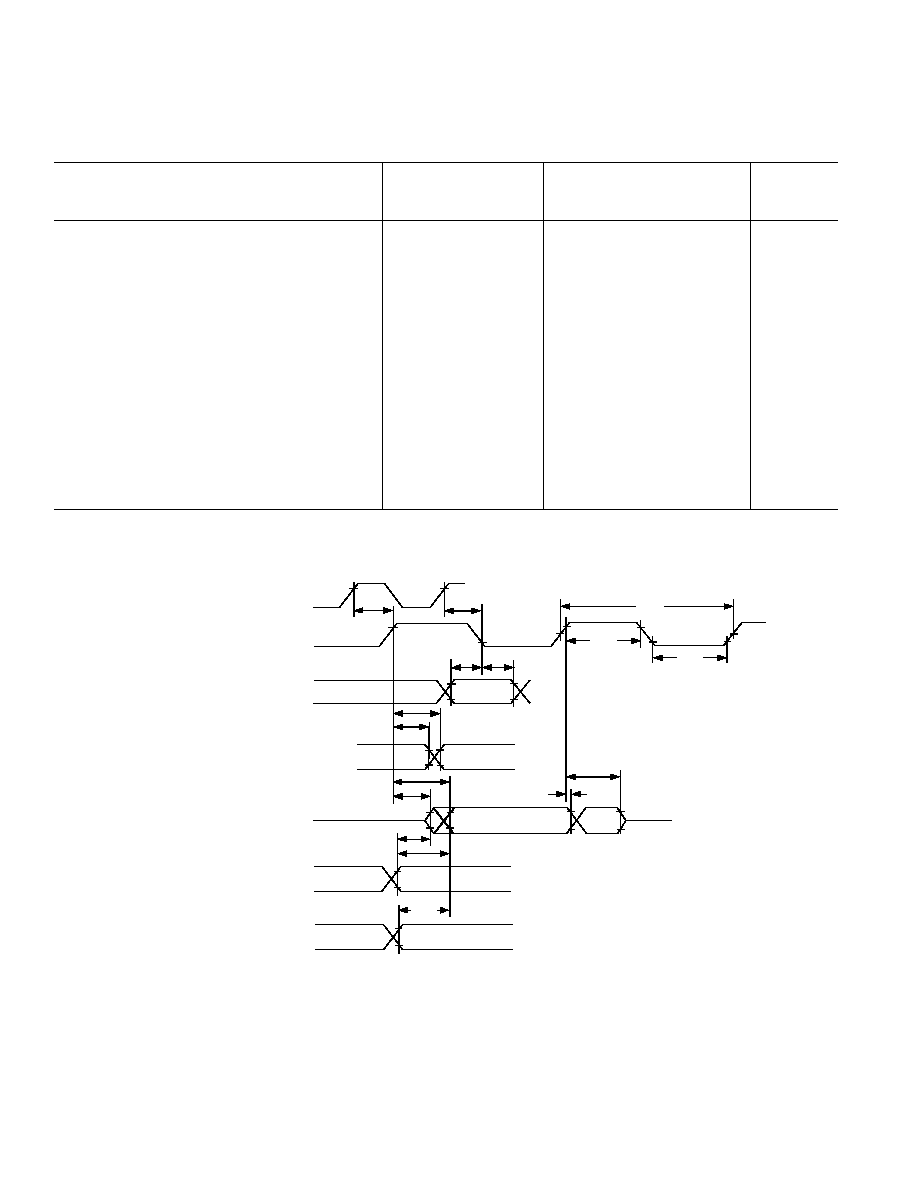
ADSP-21xx
≠50≠
REV. B
TIMING PARAMETERS (ADSP-2103/2162/2164)
SERIAL PORTS
Frequency
10.24 MHz
Dependency
Parameter
Min
Max
Min
Max
Unit
Timing Requirement:
t
SCK
SCLK Period
97.6
t
CK
ns
t
SCS
DR/TFS/RFS Setup before SCLK Low
8
ns
t
SCH
DR/TFS/RFS Hold after SCLK Low
10
ns
t
SCP
SCLK
in
Width
28
ns
Switching Characteristic:
t
CC
CLKOUT High to SCLK
out
24.4
39.4
0.25t
CK
0.25t
CK
+ 15
ns
t
SCDE
SCLK High to DT Enable
0
ns
t
SCDV
SCLK High to DT Valid
28
ns
t
RH
TFS/RFS
out
Hold after SCLK High
0
ns
t
RD
TFS/RFS
out
Delay from SCLK High
28
ns
t
SCDH
DT Hold after SCLK High
0
ns
t
TDE
TFS (alt) to DT Enable
0
ns
t
TDV
TFS (alt) to DT Valid
18
ns
t
SCDD
SCLK High to DT Disable
30
ns
t
RDV
RFS
(Multichannel, Frame Delay Zero)
20
ns
to DT Valid
CLKOUT
SCLK
TFS
RFS
DR
RFS
IN
TFS
IN
DT
( ALTERNATE
FRAME MODE )
t
CC
t
CC
t
SCK
t
SCP
t
SCP
t
SCS
t
SCH
t
RD
t
RH
RFS
OUT
TFS
OUT
t
SCDV
t
SCDE
t
SCDH
t
SCDD
t
TDE
t
TDV
t
RDV
( MULTICHANNEL MODE,
FRAME DELAY 0 {MFD = 0} )
Figure 44. Serial Ports
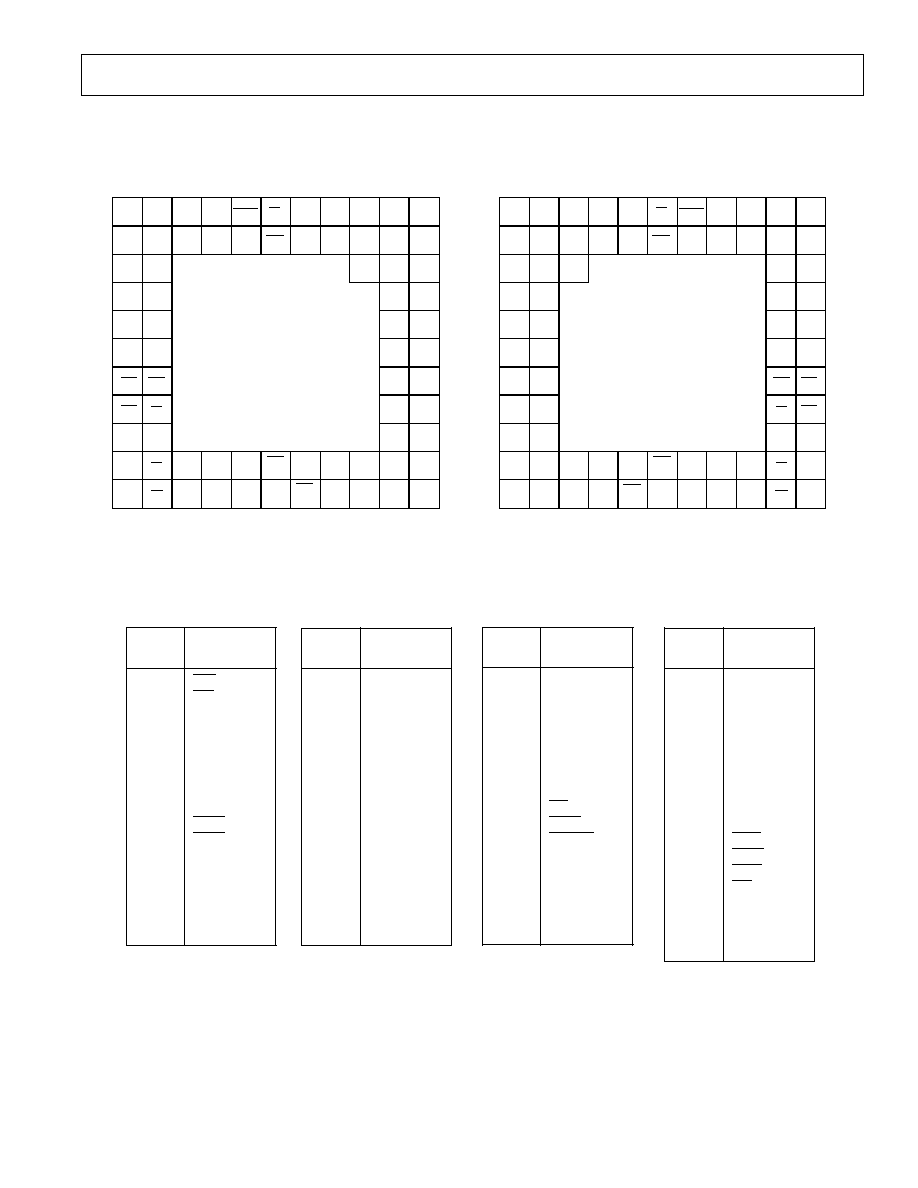
ADSP-21xx
REV. B
≠51≠
PGA
Pin
Number
Name
L2
A5
K2
A6
L3
GND
K3
A7
L4
A8
K4
A9
L5
A10
K5
A11
L6
A12
K6
A13
L7
PMS
K7
DMS
L8
BMS
K8
BG
L9
XTAL
K9
CLKIN
L10
CLKOUT
C3
Index (NC)
PIN CONFIGURATIONS
68-Pin PGA
PGA
Pin
Number
Name
A10
D3
B10
D4
A9
D5
B9
D6
A8
D7
B8
D8
A7
D9
B7
D10
A6
D11
B6
GND
A5
D12
B5
D13
A4
D14
B4
D15
A3
D16
B3
D17
A2
D18
PGA
Pin
Number
Name
B1
GND
B2
D19
C1
D20
C2
D21
D1
D22
D2
D23
E1
V
DD
E2
MMAP
F1
BR
F2
IRQ2
G1
RESET
G2
A0
H1
A1
H2
A2
J1
A3
J2
A4
K1
V
DD
PGA PACKAGE
ADSP-2101
TOP VIEW
(PINS DOWN)
L
K
J
H
G
F
E
D
C
B
A
1
2
3
4
5
6
7
8
9
10
11
IRQ1
(TFS1)
A5
GND
A8
A10
A12
PMS
BMS
XTAL
CLK
OUT
V
DD
A6
A7
A9
A11
A13
DMS
BG
RD
WR
CLK
IN
GND
D19
D17
D15
D13
GND
D10
D8
D6
D4
D2
A3
A4
RESET
A0
BR
IRQ2
V
DD
MMAP
D22
D23
D20
D21
A1
A2
INDEX
(NC)
D18
D16
D14
D12
D11
D9
D7
D5
D3
V
DD
SCLK1
TFS0
DT0
GND
RFS0
SCLK0
DR0
D1
D0
FO
(DT1)
IRQ0
(RFS1)
FI
(DR1)
1
2
3
4
5
6
7
8
9
10
11
L
K
J
H
G
F
E
D
C
B
A
PGA PACKAGE
ADSP-2101
BOTTOM VIEW
(PINS UP)
1
2
3
4
5
6
7
8
9
10
11
IRQ1
(TFS1)
A5
GND
A8
A10
A12
PMS
BMS
XTAL
CLK
OUT
V
DD
A6
A7
A9
A11
A13
DMS
BG
RD
WR
CLK
IN
GND
D19
D17
D15
D13
GND
D10
D8
D6
D4
D2
A3
A4
RESET
A0
BR
IRQ2
V
DD
MMAP
D22
D23
D20
D21
A1
A2
INDEX
(NC)
D18
D16
D14
D12
D11
D9
D7
D5
D3
V
DD
SCLK1
TFS0
DT0
GND
RFS0
SCLK0
DR0
D1
D0
FO
(DT1)
IRQ0
(RFS1)
FI
(DR1)
L
K
J
H
G
F
E
D
C
B
A
1
2
3
4
5
6
7
8
9
10
11
L
K
J
H
G
F
E
D
C
B
A
NC = NO CONNECT
PGA
Pin
Number
Name
K11
WR
K10
RD
J11
DT0
J10
TFS0
H11
RFS0
H10
GND
G11
DR0
G10
SCLK0
F11
FO
(DT1)
F10
IRQ1
(TFS1)
E11
IRQ0
(RFS1)
E10
FI
(DR1)
D11
SCLK1
D10
V
DD
C11
D0
C10
D1
B11
D2

ADSP-21xx
≠52≠
REV. B
PLCC
Pin
Number Name
52
FO
(DT1)
53
IRQ1
(TFS1)
54
IRQ0
(RFS1)
55
FI
(DR1)
56
SCLK1
57
V
DD
58
D0
59
D1
60
D2
61
D3
62
D4
63
D5
64
D6
65
D7
66
D8
67
D9
68
D10
PIN CONFIGURATIONS
68-Lead PLCC
PLCC
Pin
Number Name
1
D11
2
GND
3
D12
4
D13
5
D14
6
D15
7
D16
8
D17
9
D18
10
GND
11
D19
12
D20
13
D21
14
D22
15
D23
16
V
DD
17
MMAP
PLCC
Pin
Number Name
18
BR
19
IRQ2
20
RESET
21
A0
22
A1
23
A2
24
A3
25
A4
26
V
DD
27
A5
28
A6
29
GND
30
A7
31
A8
32
A9
33
A10
34
A11
PLCC
Pin
Number Name
35
A12
36
A13
37
PMS
38
DMS
39
BMS
40
BG
41
XTAL
42
CLKIN
43
CLKOUT
44
WR
45
RD
46
DT0
(NC on ADSP-2105)
47
TFS0
(NC on ADSP-2105)
48
RFS0
(NC on ADSP-2105)
49
GND
50
DR0
(NC on ADSP-2105)
51
SCLK0 (NC on ADSP-2105)
NC = NO CONNECT
GND
D19
D20
D21
D22
D23
V
DD
MMAP
BR
IRQ2
RESET
A0
A1
A2
A3
A4
V
DD
D18
D17
D16
D15
D14
D13
D12
GND
D11
D10
D9
D8
D7
D6
D5
D4
D3
60
59
58
57
56
55
54
53
52
51
50
49
48
47
46
45
44
9
8
7
6
5
4
3
2
1
68
67
66
65
64
63
62
61
27
28
29
30
31
32
33
34
35
36
37
38
39
40
41
42
43
10
11
12
13
14
15
16
17
18
19
20
21
22
23
24
25
26
PIN 1
IDENTIFIER
D2
D1
D0
V
DD
SCLK1
FI
(DR1)
IRQ0
(RFS1)
IRQ1
(TFS1)
FO
(DT1)
SCLK0
(NC on ADSP-2105)
DR0
(NC on ADSP-2105)
GND
RFS0
(NC on ADSP-2105)
TFS0
(NC on ADSP-2105)
DT0
(NC on ADSP-2105)
RD
WR
A5
A6
GND
A7
A8
A9
A10
A11
A12
A13
PMS
DMS
BMS
BG
XTAL
CLKIN
CLKOUT
PLCC PACKAGE
ADSP-2101
ADSP-2103
ADSP-2105
ADSP-2115
ADSP-2161/62/63/64
TOP VIEW
(PINS DOWN)

ADSP-21xx
REV. B
≠53≠
PIN CONFIGURATIONS
80-Lead PQFP
80-Lead TQFP
PQFP/
TQFP
Pin
Number Name
1
A5
2
A6
3
GND
4
GND
5
A7
6
A8
7
A9
8
A10
9
A11
10
A12
11
A13
12
PMS
13
DMS
14
BMS
15
BG
16
XTAL
17
CLKIN
18
NC
19
NC
20
NC
PQFP/
TQFP
Pin
Number Name
21
CLKOUT
22
WR
23
RD
24
DT0
25
TFS0
26
RFS0
27
GND
28
GND
29
DR0
30
SCLK0
31
FO
(DT1)
32
IRQ1
(TFS1)
33
IRQ0
(RFS1)
34
FI
(DR1)
35
SCLK1
36
V
DD
37
D0
38
D1
39
D2
40
D3
PQFP/
TQFP
Pin
Number Name
41
NC
42
NC
43
NC
44
D4
45
D5
46
D6
47
D7
48
D8
49
D9
50
D10
51
D11
52
GND
53
GND
54
D12
55
D13
56
D14
57
D15
58
D16
59
D17
60
D18
PQFP/
TQFP
Pin
Number Name
61
GND
62
GND
63
D19
64
D20
65
D21
66
D22
67
D23
68
V
DD
69
V
DD
70
MMAP
71
BR
72
IRQ2
73
RESET
74
A0
75
A1
76
A2
77
A3
78
A4
79
V
DD
80
V
DD
A5
A6
GND
GND
A7
A8
A9
A10
A11
A12
A13
PMS
DMS
BMS
BG
XTAL
CLKIN
NC
NC
NC
D18
D17
D16
D15
D14
D13
D12
GND
GND
D11
D10
D9
D8
D7
D6
D5
D4
NC
NC
NC
CLKOUT
WR
RD
DT0
TFS0
RFS0
GND
GND
DR0
SCLK0
FO
(DT1)
IRQ1
(TFS1)
IRQ0
(RFS1)
F1
(DR1)
SCLK1
V
DD
D0
D1
D2
D3
V
DD
V
DD
A4
A3
A2
A1
A0
RESET
IRQ2
BR
MMAP
V
DD
V
DD
D23
D22
D21
D20
D19
GND
GND
80
79
78
77
76
75
74
73
72
71
70
69
68
67
66
65
64
63
62
61
PQFP PACKAGE
ADSP-2101
ADSP-2103
ADSP-2115
ADSP-2161/62/63/64
TOP VIEW
(PINS DOWN)
1
2
3
4
5
6
7
8
9
10
11
12
13
14
15
16
17
18
19
20
80
79
78
77
76
75
74
73
72
71
70
69
68
67
66
65
64
63
62
61
21
22
23
24
25
26
27
28
29
30
31
32
33
34
35
36
37
38
39
40
60
59
58
57
56
55
54
53
52
51
50
49
48
47
46
45
44
43
42
41
NC = NO CONNECT

ADSP-21xx
≠54≠
REV. B
PGA
Pin
Number Name
L2
FL2
M1
FL1
N1
V
DD
N2
D1
M2
D0
N3
D3
M3
D2
N4
D5
M4
D4
N5
D7
M5
D6
N6
D10
M6
D9
L6
D8
N7
D12
M7
D11
L7
GND
N8
D13
M8
D14
L8
D15
N9
D16
M9
D17
N10
D18
M10
D19
N11
D20
M11
D22
PGA
Pin
Number Name
N13
D23
N12
D21
M13
MMAP
M12
GND
L13
BR
L12
RESET
K13
PMS
K12
V
DD
J13
BMS
J12
DMS
H13
BG
H12
WR
H11
RD
G13
A2
G12
A0
G11
A1
F13
A3
F12
A4
F11
A5
E13
GND
E12
A6
D13
A7
D12
A8
C13
A9
C12
A11
PIN CONFIGURATIONS
100-Pin PGA
PGA PACKAGE
ADSP-2111
TOP VIEW
(PINS DOWN)
CLK
OUT
F1
(D R1)
INDEX
PIN
(NC)
HD1
HD3
HA1
HD13
HD11
HD8
V
DD
HD4
HD15
A12
A10
HD2
CLK
IN
HD0
HD12
HD10
GND
HD6
HD5
HD14
A13
V
DD
HA0
D5
D7
D3
D18
D16
D13
D12
D10
D20
D21
D23
D1
V
DD
D4
D6
D2
D19
D17
D14
D11
D9
D22
GND
MMAP
D0
FL1
D15
GND
D8
FL2
FL0
V
DD
SCLK1
GND
SCLK0
RFSO
A1
A0
A2
TFS0
DR0
A5
A4
A3
DT0
A6
GND
BMODE
A8
A7
HMD1
HMD0
HD9
HD7
XTAL
A11
A9
HSIZE
HWR/
HDS
RESET
BR
PMS
BMS
BG
DMS
WR
RD
IRQ1
(TFS1)
IRQ0
(RFS1)
FO
(D T1)
HACK
IRQ2
HRD /
HRW
HSEL
HA2 /
ALE
N
M
L
K
J
H
G
F
E
D
C
B
A
13
12
11
10
9
8
7
5
4
6
3
2
1
13
12
11
10
9
8
7
5
4
6
3
2
1
N
M
L
K
J
H
G
F
E
D
C
B
A
NC = NO CONNECT
N
M
L
K
J
H
G
F
E
D
C
B
A
13
12
11
10
9
8
7
5
4
6
3
2
1
N
M
L
K
J
H
G
F
E
D
C
B
A
13
12
11
10
9
8
7
5
4
6
3
2
1
13
12
11
10
9
8
7
5
4
6
3
2
1
PGA PACKAGE
ADSP-2111
BOTTOM VIEW
(PINS UP)
D15
GND
D8
HD9
HD7
XTAL
A2
A3
GND
A7
A9
BR
PMS
BMS
BG
RESET
V
DD
A0
A4
A6
A8
A11
DMS
WR
A1
A5
RD
FO
(D T1)
HACK
F1
(DR1)
FL0
SCLK0
DT0
HMD0
IRQ1
(TFS1)
IRQ2
CLK
OUT
D12
D5
D7
D3
D18
D16
D20
D13
D10
D23
D21
V
DD
D1
D4
D6
D2
D19
D17
D11
D22
D14
D9
MMAP
GND
FL1
D0
FL2
SCLK1
GND
RFSO
DR0
TFS0
BMODE
HMD1
IRQ0
(RFS1)
INDEX
PIN
(NC)
HSIZE
HRD/
HRW
HD1
HD3
V
DD
HD11
HD13
HD15
HD8
HD4
A10
A12
HWR/
HDS
HSEL
HA1
HD2
CLK
IN
HD10
HD6
HD12
HD14
GND
HD5
V
DD
A13
HA0
HA2 /
ALE
HD0
PGA
Pin
Number Name
C3
Index (NC)
A2
HA2/ALE
A1
HA0
B1
HWR/HDS
B2
HSEL
C1
HSIZE
C2
HRD/HRW
D1
HMD0
D2
HMD1
E1
IRQ2
E2
BMODE
F1
DT0
F2
CLKOUT
F3
HACK
G1
DR0
G2
TFS0
G3
RFS0
H1
SCLK0
H2
GND
H3
FO
(DT1)
J1
IRQ1
(TFS1)
J2
IRQ0
(RFS1)
K1
FI
(DR1)
K2
SCLK1
L1
FL0
PGA
Pin
Number Name
B13
A10
A13
V
DD
A12
A13
B12
A12
A11
HD14
B11
HD15
A10
HD12
B10
HD13
A9
HD10
B9
HD11
A8
GND
B8
HD8
C8
HD9
A7
HD6
B7
V
DD
C7
HD7
A6
HD5
B6
HD4
C6
XTAL
A5
CLKIN
B5
HD3
A4
HD2
B4
HD1
A3
HD0
B3
HA1

ADSP-21xx
REV. B
≠55≠
PIN CONFIGURATIONS
100-Lead Bumpered PQFP
PQFP
Pin
Number Name
1
GND
2
D12
3
D13
4
D14
5
D15
6
D16
7
D17
8
D18
9
D19
10
D20
11
D21
12
D22
13
D23
14
GND
15
MMAP
16
RESET
17
BR
18
V
DD
19
PMS
20
DMS
21
BMS
22
RD
23
WR
24
BG
25
A0
PQFP
Pin
Number Name
26
A1
27
A2
28
A3
29
A4
30
A5
31
GND
32
A6
33
A7
34
A8
35
A9
36
A10
37
A11
38
V
DD
39
A12
40
A13
41
HD15
42
HD14
43
HD13
44
HD12
45
HD11
46
HD10
47
HD9
48
HD8
49
GND
50
V
DD
PQFP
Pin
Number Name
51
HD7
52
HD6
53
HD5
54
HD4
55
XTAL
56
CLKIN
57
HD3
58
HD2
59
HD1
60
HD0
61
HA2/ALE
62
HA1
63
HA0
64
HSEL
65
HWR/HDS
66
HRD/HRW
67
HSIZE
68
HMD1
69
HMD0
70
BMODE
71
IRQ2
72
HACK
73
CLKOUT
74
DT0
75
TFS0
PQFP
Pin
Number Name
76
RFS0
77
DR0
78
SCLK0
79
GND
80
FO
(DT1)
81
IRQ1
(TFS1)
82
IRQ0
(RFS1)
83
FI
(DR1)
84
SCLK1
85
FL0
86
FL1
87
FL2
88
V
DD
89
D0
90
D1
91
D2
92
D3
93
D4
94
D5
95
D6
96
D7
97
D8
98
D9
99
D10
100
D11
A12
A13
HD15
HD14
HD13
HD12
HD11
HD10
HD9
HD8
GND
VDD
HD7
HD6
HD5
HD4
XTAL
CLKIN
HD3
HD2
HD1
HD0
HA2/ALE
HA1
HA0
NOTE: PIN 1 IS LOCATED AT THE CENTER OF THE BEVELED-EDGE SIDE OF THE PACKAGE.
D23
D22
D21
D20
D19
D18
D17
D16
D15
D14
D13
D12
GND
D11
D10
D9
D8
D7
D6
D5
D4
D3
D2
D1
D0
BEVELED EDGE
13
12
11
10
9
8
7
6
5
4
3
2
1
100
99
98
97
96
95
94
93
92
91
90
89
14
15
16
17
18
19
20
21
22
23
24
25
26
27
28
29
30
31
32
33
34
35
36
37
38
39
40
41
42
43
44
45
46
47
48
49
50
51
52
53
54
55
56
57
58
59
60
61
62
63
88
87
86
85
84
83
82
81
80
79
78
77
76
75
74
73
72
71
70
69
68
67
66
65
64
PQFP PACKAGE
ADSP-2111
TOP VIEW
(PINS DOWN)
GND
MMAP
RESET
BR
PMS
DMS
BMS
RD
WR
BG
A0
A1
A2
A3
A4
A5
GND
A6
A7
A8
A9
A10
A11
VDD
V
DD
VDD
FL2
FL1
FL0
SCLK1
FI
(DR1)
IRQ0
(RFS1)
IRQ1
(TFS1)
FO
(DT1)
GND
SCLK0
DR0
RFS0
TFS0
DT0
CLKOUT
HACK
IRQ2
BMODE
HMD0
HMD1
HSIZE
HRD
/HRW
HWR
/
HDS
HSEL
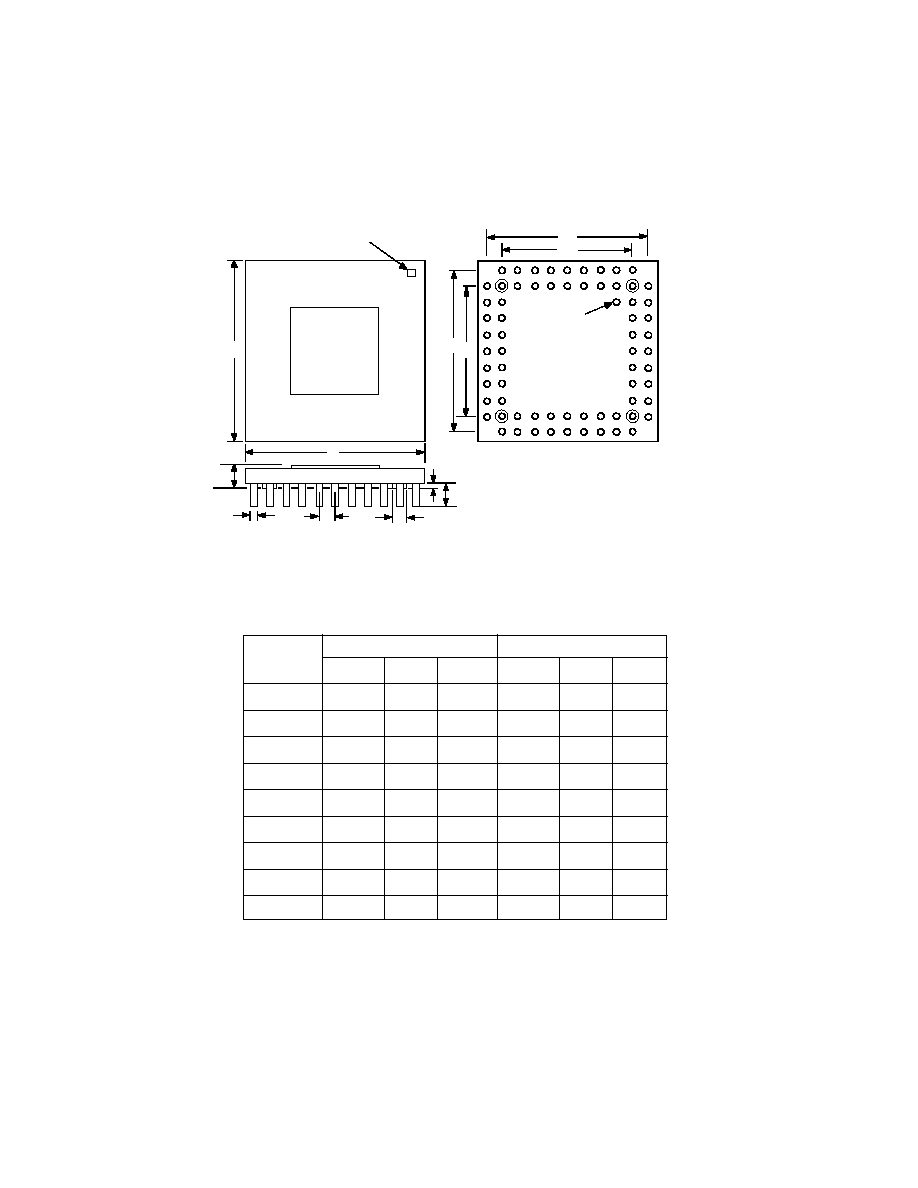
ADSP-21xx
≠56≠
REV. B
INCHES
MILLIMETERS
SYMBOL
MIN
TYP
MAX
MIN
TYP
MAX
A
0.123
0.164
3.12
4.17
A
1
0.50
1.27
b
0.016
0.018
0.020
0.46
b
1
0.050
1.27
D
1.086
1.110
27.58
28.19
e
1
0.988
1.012
25.10
25.70
e
2
0.788
0.812
20.02
20.62
e
0.100
2.54
L
3
0.180
4.57
OUTLINE DIMENSIONS
ADSP-2101
68-Pin Grid Array (PGA)
A
B
C
D
E
F
G
H
J
K
L
1
2
3
4
5
6
7
8
9
10
11
TOP VIEW
GUIDE
PIN ONLY
D
b
1
e
D
A
SEATING
PLANE
L
3
b
A
1
e
1
e
2
e
1
e
2
PGA LOCATION A1 QUADRANT MARKING
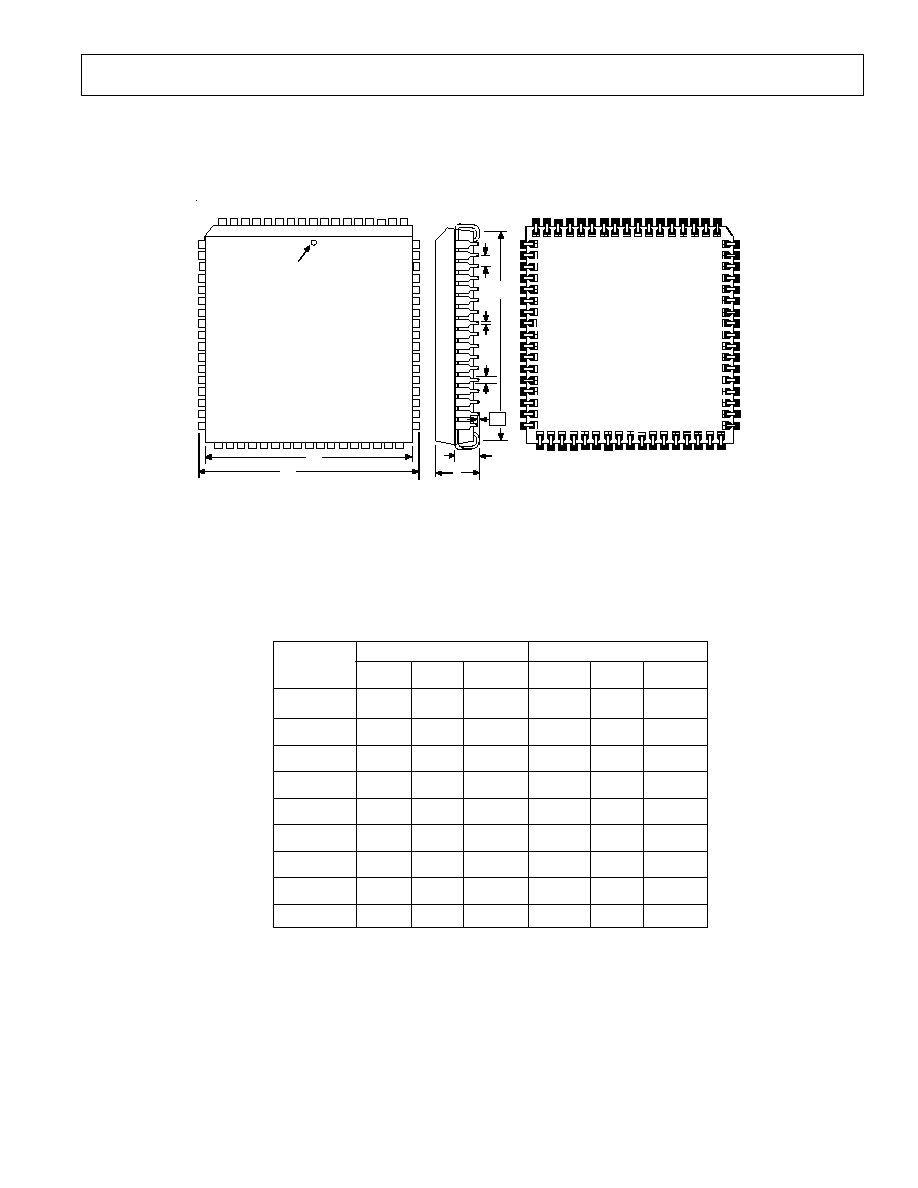
ADSP-21xx
REV. B
≠57≠
OUTLINE DIMENSIONS
ADSP-21xx
68-Lead Plastic Leaded Chip Carrier (PLCC)
INCHES
MILLIMETERS
SYMBOL
MIN
TYP
MAX
MIN
TYP
MAX
A
0.169
0.172
0.175
4.29
1
4.37
4.45
A
1
0.104
1
2.64
b
0.017
0.018
0.019
0.43
1
0.46
0.48
b
1
0.027
0.028
0.029
0.69
1
0.71
0.74
D
0.985
0.990
0.995
25.02
25.15
25.27
D
1
0.950
0.952
0.954
24.13
24.18
24.23
D
2
0.895
0.910
0.925
22.73
23.11
23.50
e
0.050
1
1.27
0.004
1
0.10
D
e
b
b
1
A
1
A
PIN 1 IDENTIFIER
TOP VIEW
(PINS DOWN)
9
61
D
1
D
BOTTOM VIEW
(PINS UP)
D
2
D
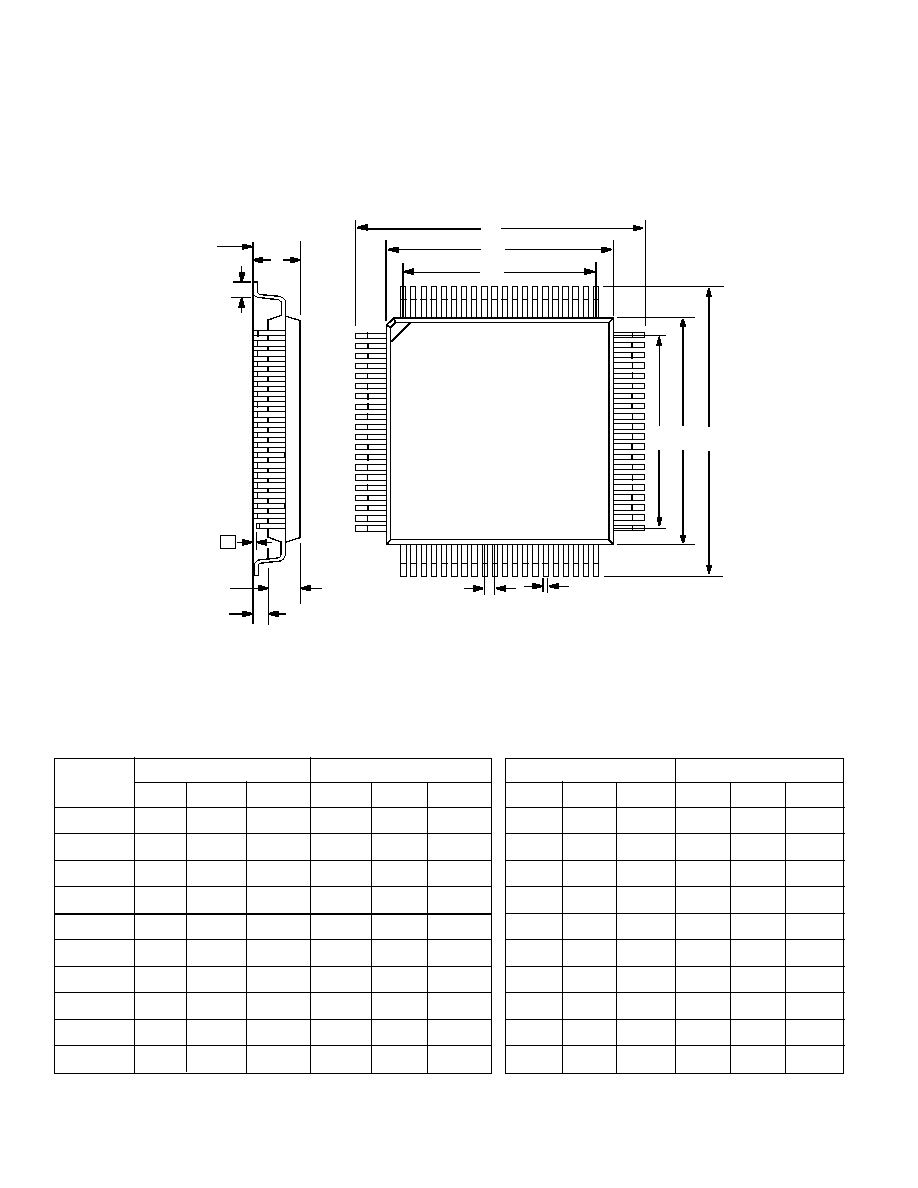
ADSP-21xx
≠58≠
REV. B
MILLIMETERS
INCHES
SYMBOL
MIN
TYP
MAX
MIN
TYP
MAX
A
2.45
0.096
A
1
0.25
0.010
A
2
1.90
2.00
2.10
0.075
0.079
0.083
D, E
16.95
17.20
17.45
0.667
0.678
0.690
D
1
, E
1
13.90
14.00
14.10
0.547
0.551
0.555
D
3
, E
3
12.35
12.43
0.486
0.490
L
0.65
0.80
0.95
0.026
0.031
0.037
e
0.57
0.65
0.73
0.023
0.026
0.029
B
0.22
0.30
0.38
0.009
0.012
0.015
0.10
0.004
OUTLINE DIMENSIONS
ADSP-21xx
80-Lead Metric Plastic Quad Flatpack (PQFP)
80-Lead Metric Thin Quad Flatpack (TQFP)
MILLIMETERS
INCHES
MIN
TYP
MAX
MIN
TYP
MAX
1.60
0.063
0.05
0.15
0.002
0.006
1.35
1.40
1.45
0.053
0.055 0.057
15.75 16.00
16.25
0.620
0.630 0.640
13.95 14.00
14.05
0.549
0.551 0.553
12.35
12.43
0.486 0.490
0.50
0.60
0.75
0.020
0.024 0.030
0.57
0.65
0.73
0.022
0.026 0.029
0.25
0.30
0.35
0.010
0.012 0.014
0.10
0.004
D
PQFP
TQFP
1
80
61
60
41
40
21
20
e
E
TOP VIEW
(PINS DOWN)
B
E
1
D
1
D
E
3
D
3
A
L
A
1
A
2
SEATING
PLANE
D
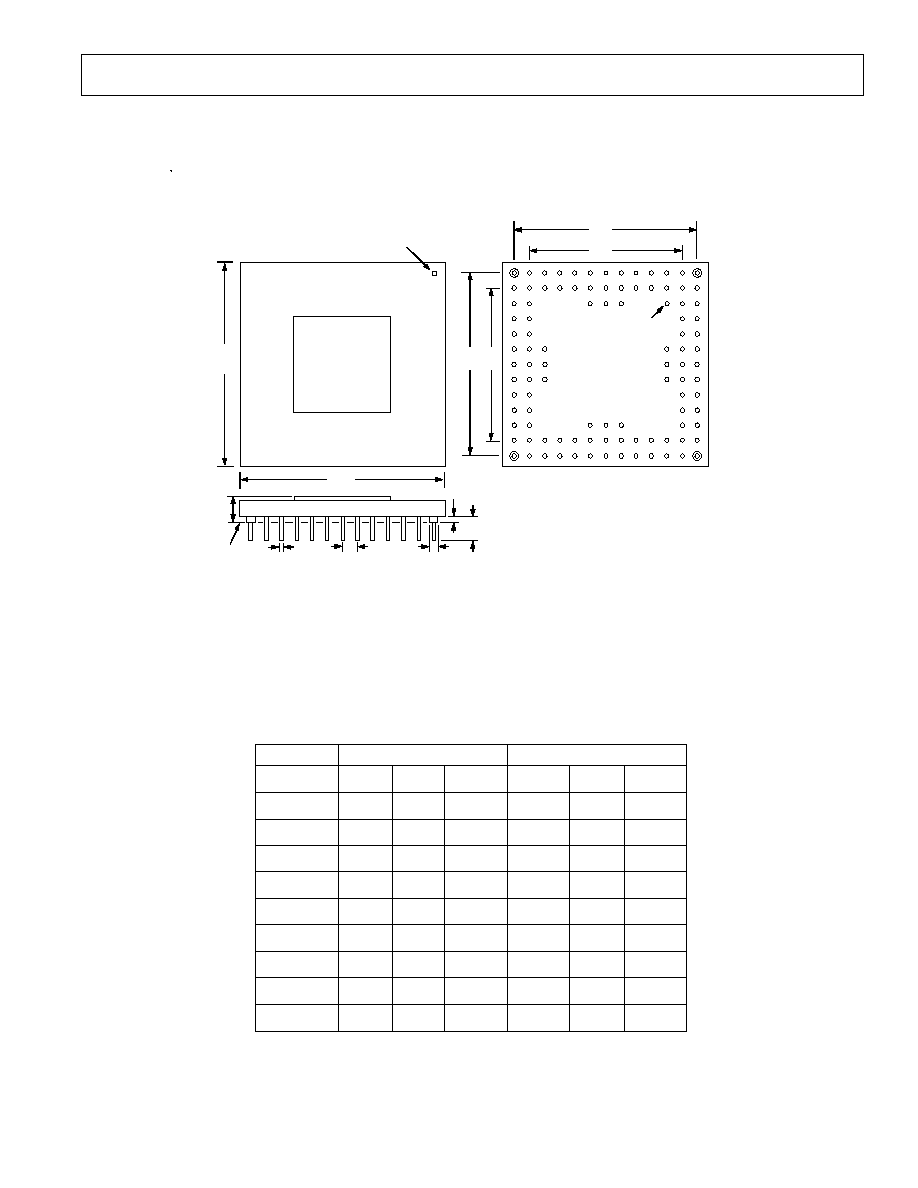
ADSP-21xx
REV. B
≠59≠
INCHES
MILLIMETERS
SYMBOL
MIN
TYP
MAX
MIN
TYP
MAX
A
0.123
0.169
3.12
4.29
A
1
0.050
1.27
b
0.016
0.018
0.020
0.41
0.46
0.51
b
1
0.050
1.27
D
1.308
1.32
1.342
33.22
33.53
34.09
e
1
1.188
1.20
1.212
30.18
30.48
30.78
e
2
0.988
1.00
1.012
25.10
25.4
25.70
e
0.100
2.54
L
3
0.180
4.57
OUTLINE DIMENSIONS
ADSP-2111
100-Pin Grid Array (PGA)
TOP VIEW
INDEX
PIN
ONLY
1
2
3
4
5
6
7
8
9
10
11
13
12
A
B
C
D
E
F
G
H
J
K
L
N M
e1
e2
e1 e2
SEATING
PLANE
D
D
A
b
e
A1
L3
b1
PGA LOCATION A1 QUADRANT MARKING
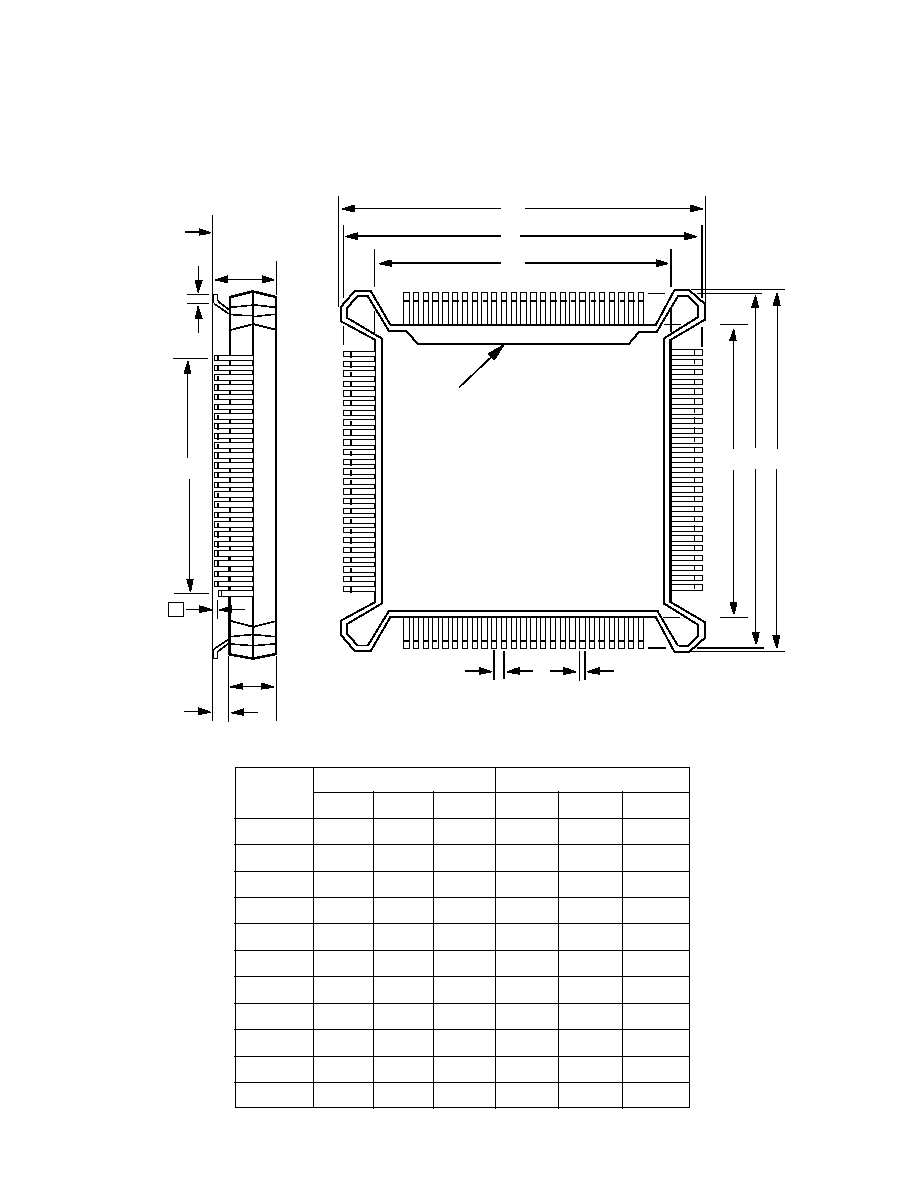
ADSP-21xx
≠60≠
REV. B
OUTLINE DIMENSIONS
INCHES
MILLIMETERS
SYMBOL
MIN
TYP
MAX
MIN
TYP
MAX
A
0.180
4.572
A
1
0.020
0.030
0.040
0.508
0.762
1.016
A
2
0.130
0.140
0.150
3.302
3.556
3.810
D, E
0.875
0.880
0.885
22.225
22.352
22.479
D
1
, E
1
0.747
0.750
0.753
18.974
19.050
19.126
D
2
, E
2
0.897
0.900
0.903
22.784
22.860
22.936
D
3
, E
3
0.600
0.603
15.240
15.316
L
0.036
0.046
0.914
1.168
e
0.022
0.025
0.028
0.559
0.635
0.711
B
0.008
0.012
0.203
0.305
0.004
0.102
ADSP-2111
100-Lead Bumpered Plastic Quad Flatpack (PQFP)
D
13
TOP VIEW
(PINS DOWN)
1
e
E
1
E
2
E
88
64
39
63
14
38
89
B
Beveled
Edge
D
1
D
D
2
D
A 2
A
1
A
SEATING
PLANE
L
D
3
, E
3
NOTE: PIN 1 IS THE CENTER PIN ON THE BEVELED-EDGE SIDE OF THE PACKAGE.

ADSP-21xx
REV. B
≠61≠
ORDERING GUIDE
Ambient
Temperature
Instruction
Package
Package
Part Number
1
Range
Rate (MHz)
Description
Option
ADSP-2101KG-66
0
∞
C to +70
∞
C
16.67 MHz
68-Pin PGA
G-68A
ADSP-2101BG-66
≠40
∞
C to +85
∞
C
16.67 MHz
68-Pin PGA
G-68A
ADSP-2101KP-66
0
∞
C to +70
∞
C
16.67 MHz
68-Lead PLCC
P-68A
ADSP-2101BP-66
≠40
∞
C to +85
∞
C
16.67 MHz
68-Lead PLCC
P-68A
ADSP-2101KS-66
0
∞
C to +70
∞
C
16.67 MHz
80-Lead PQFP
S-80
ADSP-2101BS-66
≠40
∞
C to +85
∞
C
16.67 MHz
80-Lead PQFP
S-80
ADSP-2101KG-80
0
∞
C to +70
∞
C
20.0 MHz
68-Pin PGA
G-68A
ADSP-2101BG-80
≠40
∞
C to +85
∞
C
20.0 MHz
68-Pin PGA
G-68A
ADSP-2101KP-80
0
∞
C to +70
∞
C
20.0 MHz
68-Lead PLCC
P-68A
ADSP-2101BP-80
≠40
∞
C to +85
∞
C
20.0 MHz
68-Lead PLCC
P-68A
ADSP-2101KS-80
0
∞
C to +70
∞
C
20.0 MHz
80-Lead PQFP
S-80
ADSP-2101BS-80
≠40
∞
C to +85
∞
C
20.0 MHz
80-Lead PQFP
S-80
ADSP-2101KP-100
0
∞
C to +70
∞
C
25.0 MHz
68-Pin PLCC
P-68A
ADSP-2101BP-100
≠40
∞
C to +85
∞
C
25.0 MHz
68-Pin PLCC
P-68A
ADSP-2101KS-100
0
∞
C to +70
∞
C
25.0 MHz
80-Lead PQFP
S-80
ADSP-2101BS-100
≠40
∞
C to +85
∞
C
25.0 MHz
80-Lead PQFP
S-80
ADSP-2101KG-100
0
∞
C to +70
∞
C
25.0 MHz
68-Lead PGA
G-68A
ADSP-2101BG-100
≠40
∞
C to +85
∞
C
25.0 MHz
68-Lead PGA
G-68A
ADSP-2101TG-50
≠55
∞
C to +125
∞
C
12.5 MHz
68-Pin PGA
G-68A
ADSP-2103KP-40 (3.3 V)
0
∞
C to +70
∞
C
10.24 MHz
68-Lead PLCC
P-68A
ADSP-2103BP-40 (3.3 V)
≠40
∞
C to +85
∞
C
10.24 MHz
68-Lead PLCC
P-68A
ADSP-2103KS-40 (3.3 V)
0
∞
C to +70
∞
C
10.24 MHz
80-Lead PQFP
S-80
ADSP-2103BS-40 (3.3 V)
≠40
∞
C to +85
∞
C
10.24 MHz
80-Lead PQFP
S-80
ADSP-2105KP-55
0
∞
C to +70
∞
C
13.824 MHz
68-Lead PLCC
P-68A
ADSP-2105BP-55
≠40
∞
C to +85
∞
C
13.824 MHz
68-Lead PLCC
P-68A
ADSP-2105KP-80
0
∞
C to +70
∞
C
20.0 MHz
68-Lead PLCC
P-68A
ADSP-2105BP-80
≠40
∞
C to +85
∞
C
20.0 MHz
68-Lead PLCC
P-68A
ADSP-2115KP-66
0
∞
C to +70
∞
C
16.67 MHz
68-Lead PLCC
P-68A
ADSP-2115BP-66
≠40
∞
C to +85
∞
C
16.67 MHz
68-Lead PLCC
P-68A
ADSP-2115KS-66
0
∞
C to +70
∞
C
16.67 MHz
80-Lead PQFP
S-80
ADSP-2115BS-66
≠40
∞
C to +85
∞
C
16.67 MHz
80-Lead PQFP
S-80
ADSP-2115KST-66
0
∞
C to +70
∞
C
16.67 MHz
80-Lead TQFP
ST-80
ADSP-2115BST-66
≠40
∞
C to +85
∞
C
16.67 MHz
80-Lead TQFP
ST-80
ADSP-2115KP-80
0
∞
C to +70
∞
C
20.0 MHz
68-Lead PLCC
P-68A
ADSP-2115BP-80
≠40
∞
C to +85
∞
C
20.0 MHz
68-Lead PLCC
P-68A
ADSP-2115KS-80
0
∞
C to +70
∞
C
20.0 MHz
80-Lead PQFP
S-80
ADSP-2115BS-80
≠40
∞
C to +85
∞
C
20.0 MHz
80-Lead PQFP
S-80
ADSP-2115KST-80
0
∞
C to +70
∞
C
20.0 MHz
80-Lead TQFP
ST-80
ADSP-2115BST-80
≠40
∞
C to +85
∞
C
20.0 MHz
80-Lead TQFP
ST-80
ADSP-2115KP-100
0
∞
C to +70
∞
C
25.0 MHz
68-Lead PLCC
P-68A
ADSP-2115BP-100
≠40
∞
C to +85
∞
C
25.0 MHz
68-Lead PLCC
P-68A
NOTES
1
K = Commercial Temperature Range (0
∞
C to +70
∞
C).
B = Industrial Temperature Range (≠40
∞
C to +85
∞
C).
T = Extended Temperature Range (≠55
∞
C to +125
∞
C).
G = Ceramic PGA (Pin Grid Array).
P = PLCC (Plastic Leaded Chip Carrier).
S = PQFP (Plastic Quad Flatpack).
ST = TQFP (Thin Quad Flatpack)

ADSP-21xx
≠62≠
REV. B
ORDERING GUIDE
Ambient
Temperature
Instruction
Package
Package
Part Number
1
Range
Rate (MHz)
Description
Option
ADSP-2111KG-52
0
∞
C to +70
∞
C
13.0 MHz
100-Pin PGA
G-100A
ADSP-2111BG-52
≠40
∞
C to +85
∞
C
13.0 MHz
100-Pin PGA
G-100A
ADSP-2111KS-52
0
∞
C to +70
∞
C
13.0 MHz
100-Lead PQFP
S-100A
ADSP-2111BS-52
≠40
∞
C to +85
∞
C
13.0 MHz
100-Lead PQFP
S-100A
ADSP-2111KG-66
0
∞
C to +70
∞
C
16.67 MHz
100-Pin PGA
G-100A
ADSP-2111BG-66
≠40
∞
C to +85
∞
C
16.67 MHz
100-Pin PGA
G-100A
ADSP-2111KS-66
0
∞
C to +70
∞
C
16.67 MHz
100-Lead PQFP
S-100A
ADSP-2111BS-66
≠40
∞
C to +85
∞
C
16.67 MHz
100-Lead PQFP
S-100A
ADSP-2111KG-80
0
∞
C to +70
∞
C
20.0 MHz
100-Pin PGA
G-100A
ADSP-2111BG-80
≠40
∞
C to +85
∞
C
20.0 MHz
100-Pin PGA
G-100A
ADSP-2111KS-80
0
∞
C to +70
∞
C
20.0 MHz
100-Lead PQFP
S-100A
ADSP-2111BS-80
≠40
∞
C to +85
∞
C
20.0 MHz
100-Lead PQFP
S-100A
ADSP-2111TG-52
≠55
∞
C to +125
∞
C
13.0 MHz
100-Pin PGA
G-100A
ADSP-2161KP-66
2
0
∞
C to +70
∞
C
16.67 MHz
68-Lead PLCC
P-68A
ADSP-2161BP-66
2
≠40
∞
C to +85
∞
C
16.67 MHz
68-Lead PLCC
P-68A
ADSP-2161KS-66
2
0
∞
C to +70
∞
C
16.67 MHz
80-Lead PQFP
S-80
ADSP-2161BS-66
2
≠40
∞
C to +85
∞
C
16.67 MHz
80-Lead PQFP
S-80
ADSP-2162KP-40 (3.3 V)
2
0
∞
C to +70
∞
C
10.24 MHz
68-Lead PLCC
P-68A
ADSP-2162BP-40 (3.3 V)
2
≠40
∞
C to +85
∞
C
10.24 MHz
68-Lead PLCC
P-68A
ADSP-2162KS-40 (3.3 V)
2
0
∞
C to +70
∞
C
10.24 MHz
80-Lead PQFP
S-80
ADSP-2162BS-40 (3.3 V)
2
≠40
∞
C to +85
∞
C
10.24 MHz
80-Lead PQFP
S-80
ADSP-2163KP-66
2
0
∞
C to +70
∞
C
16.67 MHz
68-Lead PLCC
P-68A
ADSP-2163BP-66
2
≠40
∞
C to +85
∞
C
16.67 MHz
68-Lead PLCC
P-68A
ADSP-2163KS-66
2
0
∞
C to +70
∞
C
16.67 MHz
80-Lead PQFP
S-80
ADSP-2163BS-66
2
≠40
∞
C to +85
∞
C
16.67 MHz
80-Lead PQFP
S-80
ADSP-2163KP-100
2
0
∞
C to +70
∞
C
25 MHz
68-Lead PLCC
P-68A
ADSP-2163BP-100
2
≠40
∞
C to +85
∞
C
25 MHz
68-Lead PLCC
P-68A
ADSP-2163KS-100
2
0
∞
C to +70
∞
C
25 MHz
80-Lead PQFP
S-80
ADSP-2163BS-100
2
≠40
∞
C to +85
∞
C
25 MHz
80-Lead PQFP
S-80
ADSP-2164KP-40 (3.3 V)
2
0
∞
C to +70
∞
C
10.24 MHz
68-Lead PLCC
P-68A
ADSP-2164BP-40 (3.3 V)
2
≠40
∞
C to +85
∞
C
10.24 MHz
68-Lead PLCC
P-68A
ADSP-2164KS-40 (3.3 V)
2
0
∞
C to +70
∞
C
10.24 MHz
80-Lead PQFP
S-80
ADSP-2164BS-40 (3.3 V)
2
≠40
∞
C to +85
∞
C
10.24 MHz
80-Lead PQFP
S-80
NOTES
1
K = Commercial Temperature Range (0
∞
C to +70
∞
C).
B = Industrial Temperature Range (≠40
∞
C to +85
∞
C).
T = Extended Temperature Range (≠55
∞
C to +125
∞
C).
G = Ceramic PGA (Pin Grid Array).
P = PLCC (Plastic Leaded Chip Carrier).
S = PQFP (Plastic Quad Flatpack).
2
Minimum order quantities required. Contact factory for further information.

≠63≠

C1891b≠10≠2/96
PRINTED IN U.S.A.
≠64≠































































